#shaku does commentary
Explore tagged Tumblr posts
Note
Now tell me the gay montriputro story please🙃🙃
KSKSJDJDHD NOW IT'S TIME FOR MY ANOTHER FAVOURITE TALE MUAHAHAHAHAHA
Ok so this story is actually so cute I wanted to retell it in my own ways someday... (nvm im too lazy to get going with anything) and this story's characters also had no names so I thought “hmm since I'm already planning to retell this why not give them brand new names....”
You might have (or might not have) seen me making some random gay doodlings and showing them to @igotadigbickandureadthatwrong [the uponkor ones lol...] and sometimes I sent one or two pictures from the og book to @randomx123 too ig..?
So this story has 4 main characters... (Well that's what I consider but you can consider 3...) And for the love of god non of them had a fucking name (and a fucking side character had a name 💀🤌) That's why the names I allotted to them are...
Dun dun dun...
Im revealing them in the narration lol...
Tagging people whom I want to share this crazy story with @randomx123 @jeahreading @krishna-priyatama @no-idea-where-i-am-lost @foreignink @igotadigbickandureadthatwrong @prettykittytanjiro @ishaaron-ishaaron-me @stxrrynxghts @desigurlie @crystraniqelle @priestessofuniverse @dwarpharini @shubhadeep385 @hydestudixs @dreamer-in-sleep @aru-loves-krishnaxarjuna @livingtheparadoxlife @groovycynicalcheesecake @wulfricnavy (im sorry im adding you late 😭 but consider this the return gift for Depth of Despair)
Trigger warnings: bitchass people, unfortunately those bitchass people don't die well in this story... sigh, infanticide, homoerotic friendship, divine intervention, snakes, snake dying, snake coming out of nose, turning into stone, talking birds and swearings
So in the starting of the story we are told about this rajkumar Upendro (yes I named him) and his verryyy verryyy verryyyy close “friend” the montriputro Shonkor 🗿 (I named him too yeahhh)
They are such good “friends” they can't even spend a day without eachother. They grew up together and do everything together eat sleep roaming around. They are literally the do dil ek jaan kinda “friends”. It's a hot topic how close these two are with eachother...
Their “friendship” is so deep Shonkor sometimes falls asleep in Upendro's room and nobody gives a flying fuck about it... Not Even the king. 💀🤌
(Me interviewing the maids of the palace*
Maids: ohh then they fell asleep together, such good friends I mean...
Me: 💀💀🗿✨ yup... Very good friends... 💀✨)
.....
So whatever back to actually plot
One day Upendro is like
Upendro: yk... I feel like going on some adventures...
Upendro: roaming around the kingdoms... Seeing new things..
Upendro: just you and me...
Shonkor: ...
Shonkor: ok
So yeah, they decided they'd go do Dora the explorer shit in the wild and went away. Just the two of them on their horses and didn't take any men or soldiers with them. 💀
And they roamed around here and there in different kingdoms and places, like those discovery channel dudes.
.....
One day after travelling for long enough they are in a forest and it's getting late. And they come across a BEAUTIFUL lake and it got really clear water like glass.
So our boyfriends besties decides “yeah let's spend the night near this lake on that banyan tree nearby”
And they tie their horses at the bottom and then get some water from the lake for hath mukh dhona and drinking and climbs the tree to sleep on it (I have no idea what they were planning to do on those branches or if it's even possible to sleep on branches 💀🤌)
.......
Now after sometimes a lot of light literally blinds them, like there's too much brightness like my mom's phone screen all over the forest and they are both like o.O trying to figure out where the light came from
And their eyes fall at the lake and they see a bigass snake coming out of it, and it has a BIG mani on it's head (hehehehehehd nag mani lessgoo) which is the source of all the blinding light.
So they see the snake crawling out of the pond and into the forest and under the tree. Snake bbg puts the nagmani down from it's head and below the tree (idk how that even happened considering it has no hands or anything 💀💀)
And then the snake eats up those two pookie horses (MY SHYALAAAAAA NO MY SHYALAAAA 😭😭) and goes away deeper into the forest 🗿🗿 blud didn't even try to climb the tree bruhh
So now Upendro and Shonkor are like 💀💀 because one wtf is that giantass snake and two their horses are gone 😭😭 (I just really love horses ok!!)
So Shonkor my ultimate gadha climbs down the tree to look at the mani and he just fucking covers that stone with the horse saddle for some weird reasons idfk 💀🤌 and then climbs back next to his boifren
......
So snake dude?dudette? idk comes back after sometime and when it couldn't find it's mani it just makes all those growling sounds like crying and all. Then it fucking dies. 💀 In dispression. 💀 Because it lost it's stone. 💀 (Ykw mood 🗿 I'd die too if I lost my favourite stone)
So now Shonkor and Upendro stays awake the entire night on the tree scared shitless 🌝 because yeah obviously you don't wanna end up in a anaconda's stomach even if you know it's ded. Like take no chances my boys.
So next morning early in the dawn they come down from the tree and Shonkor picks up the mani from those hiddings to wash it in the lake (why's he always doing the labour Upendro you hypocrite bitch)
And as soon as the mani touches the water it again starts to glowwwwwww ( read it in the you make me glow tune) and they notices a literal PALACE under the lake 💀💀
And they are like “GURL DAMN WHAT”
......
So these gayass bitches decides they wanna know what's in tha palace (like no thoughts of self preservation or safety or anything... 💀🤌 dumbasses)
And they go under the lake and yeah surprise surprise they can breath under water because of the mani 🗿
So whatever... they get under water in that palace and it's really gorgeous and big and a lot of stuff are there like trees and fruits they never heard of, flowers with sweet smells, and ofcourse lots of gemstone and stuff and as expected NO ONE fucking no one's in that palace 💀🤌
So they get inside the palace (bro that's trespassing where's your poribar's shikkha??) And starts to search all the rooms like some local chor because bruhh 💀
......
Then they suddenly hear some very feminine crying sounds coming from one of the rooms, and ofcourse they are like o.O and go to see what's wrong and comes across the room where the sound is coming from
Inside they see a gorgeous maiden sitting on the GOLDEN bed and sobbing like her world ended (which yeah it did)
And she hears to footsteps and looks up to see those two randomass dude standing there like🧍And she's like
Bbg cutie: who are you all? 😭
Bbg cutie: why are you here? 😭
Bbg cutie: go away or the snek will eat you 😭
Bbg cutie: it already ate my mom dad siblings and everyone in this palace 😭
Bbg cutie: only I'm alive now (because of unknown reasons) 😭
Bbg cutie: so go away before you become the 3 course 5 star meal for the snake... 😭😭
So Shonkor is like
Shonkor: girl dw that snek is ded, we killed it :D (where dude? It died from grief stop lying idiot)
Shonkor: see see the mani from its head :D
And he shows her the mani (also Upendro you bitch why tf are you just standing and doing nothing you kamchor lyadkhor harami)
[Ohhh btw I named my bbg Kumudini just because 🗿🗿🗿]
So now
Kumudini: umm ok... But who tf ARE you??
Shonkor: ummm I'm Shonkor... You? (Well in the og tale he just says he's montriputro but since I gave him a name he's saying his name ok)
Kumudini: I'm the princess of this place Kumudini 🥹🤌
Kumudini: will you two go away from here 🥺 (goshhh she's so pookie I love her soo much ahhhhh)
Shonkor: no no! We're here to stay ofcourse :D
Kumudini: omgg yayyy welcome you all will be as comfortable as possible here :D
[I love how Upendro is just standing there like 🧍 while these two chat like he's such a dumb and introverted gadha... I love him so much lmao]
......
So they start to stay in that patal palace (that's how that place is described ok it's said to be patal... cool ig?)
And ig in those days Upendro and Kumudini have their Kuch Kuch Hota Hai moments cuz Shonkor then one days tells her Upendro wants to marry her 💀🤌
(Lmao imagine the conversation that went between our cookie Shonkor and his adopted introvert Upendro...
Upendro: bhai 🌝
Shonkor:
Upendro: setting karwa de 🌝
Shonkor:
Upendro: plj 🌝
Shonkor:
Shonkor: ok 💀
Upendro: yaayy ilysm 🥹)
And unsurprisingly Kumudini agrees to marry him cuz ofcourse duhh they are in looveee~ 💀
So they get married in that place (idk how they got a purohit tho... Ig allrounder Shonkor became the purohit... Or they simply married without a purohit which is also not at all wrong)
......
Now after somedays Upendro starts to feel homesick because they have been away from there kingdom for SO LONG
So Upendro tells Shonkor that they should go back home but Shonkor is like
Shonkor: yaaa you're right. But idt you two should go like this....
Upendro: wot? woi?
Shonkor: cuz you both are newly married 🗿
He basically tells them both to stay at the patal palace and enjoy their honeymoon while he goes back to their kingdom to get the king daddy to come and fetch them, since Upendro's the prince and he just got married so that would be appropriate.
And so Upendro and Kumudini agrees, while Shonkor tells them bye bye and sets off for home. (Sighh... Things you do for your homoerotic friendship huh)
......
So now Kumudini and Upendro are spending their days well and good in that patal palace.
BUT one day Kumudini was getting really bored in the afternoon while Upendro was giving a mosher moto ghum (this bitch also likes bhat ghum my brother in maa Durga ufff 🫂🥹🗿✨)
And she looks at the nagmani kept close by and wonders how the upside world looks like cuz she had NEVER been there in her entire life (you need a guide for your first trip bbg don't do it alone pls)
So she decides “yeah nothing bad will happen I'll just go and come back before hubby wakes up...” and takes the mani to get out of that lake and wonder around the forest :p 💀✨
And she goes around admiring the things and all yk typical snow white behaviour, and it makes her really excited and happy because she's seeing all those for the first time in her life.
Then she comes back to the patal palace before Upendro could wake up and acts all normal and happy 🌝 telling him nothing (because more gele ke dekhche what's safety what's precautions???)
......
So this shit continues for some days, everyday she goes up and wonders like Dora the explorer during the afternoon and then comes back before Upendro can wake up from his moron ghum and she pretends everything is normal. 🗿🗿
BUT how can they live in peace right? Some crazy shit is bound to happen...
So one day as she was sitting by the lake and just playing with the water like the pookie cookie she is, that kingdom's bitchass rajkumar (the kingdom in whose area that forest falls) was out hunting with some of his equally bitchass friends and they come across the lake and banyan tree. (There's a buri mohila near the tree too, keep that in mind, it will be important to the plot later)
The rajkumar (I'm not naming him I'd just call him bitchass rajkumar) sees Kumudini only once and Kumudini get's scared and just jumps back in the lake and goes back to the palace.
And now dude is like shocked pikachu face because tf happened and he falls back down unconscious because of how GORGEOUS Kumudini is.... 💀🗿 (i mean I would too 🗿)
.....
This side Kumudini got REALLY scared so she stopped going out of the lake for some days and just spends her days in patal palace like normal, not wanting to get caught roaming by some randomass men (see everyone is scared of unknown men)
And on the other hand, over there bitchass rajkumar's sakha gang are like “yoo dude wtf happened??” and they worry for him but all dude could say is “where did she go?? where did she go??” 💀💀💀
So they are like “beta pagla hoye gache” and they take him back to the palace to his father the king. And in a few days bro becomes absolutely bedridden and mad only ever saying “where did she go?? where did she go” 💀🤌
.....
Now king dude is like “wtf gotta save my baby boy” and he does what any typical king does when no raj vaidya works... And makes the announcement that whoever can cure the rajkumar and decode who's “she” that person will get half the kingdom and the hand in marriage with his daughter the rajkumari 🗿💀✨
And now nobody fucking knows what to do because who IS “she”??? So nobody is able to save rajkumar and the king dude is getting frustrated...
THAT'S WHEN the buri mohila from before randomly appears claiming she knows how to cure the rajkumar and who “she” really is...
But ofc nobody believes her not even the king (cuz she got a rastar pagol type er chhele who's called Fokir and everyone thinks she's also pagol like her son) 💀💀💀
But she insists and says she will do it she'd just need a lake side view hut and a bunch of soldiers to help her. And if she succeeds her son must get that half kingdom and the princess' (king dude's daughter not Kumudini don't confuse) hand in marriage... (I first thought she was gonna ask to get married to the princess herself 💀🤌)
So king dude is like yeah what's there to lose? And agrees to her thinking the buri mohila can't do shit.
......
Then she gets the lake view hut and soldiers and starts to stay there starring at the lake all day.
Now this side after many days Kumudini finally gets the courage to go back outside and gets out of the lake to sit near it. 💀✨
NOW as soon as she's out in the wild sitting and playing around with the water, that old hag approaches her... And pretends to be friendly telling her not to be scared and anything and dumb dumb blorbo Kumudini agrees and tells her who she is saying she's the patal puri rajkonna and stuff showing her the nagmani.
The buri mohila pretends to be curious and asks to see the mani taking it in her hand and as soon as Kumudini gives it to her like a bokach*** she tells the hidden soldiers to come out and basically kidnap Kumudini 💀💀💀 (that's why you should trust NO ONE in an unknown place)
.....
They kidnap her and take her back to the palace while she's crying and begging them to let her go (too much traumatizing shit goes on in this story trust me)
And the buri is like “dw girl you'll be fine here the rajkumar just wants to see you”
So in the palace they call the half mad depressed bitchass rajkumar who's still murmuring “where did she go?? where did she go??” and as soon as he sees Kumudini he's like
Bitchass rajkumar: THAT'S HER THAT'S HER THAT'S THE MAIDEN I SAW BACK THEN
Kumudini: just lemme go plssss 😭😭🙏
Bitchass rajkumar not even listening to her: you're so gorgeous ahhh I wanna marry you 🥹
Kumudini, trying to save herself: ummm umm I- I can't marry for six months I'm doing a vrat 😭
Bitchass rajkumar: okk bbg I can wait for you for eternity what's six months to that 😩✨✋
(💀💀 that's legit a line from the book ok... 💀 And as much as I like the flirting romantic line he just said he's still a big long smelly piece of shit so I hate him)
......
And now back to patal palace, Upendro wakes up and is in deep depression cuz Kumudini is missing and even the mani that enables them all to get out and inside of lake is missing so he can't even go search for her.
He's literally in pieces, crying himself to madness in that lonely palace (ok yeah bro really loves his wife sigh... I just love him so much)
So now six months are going by and Kumudini is still kept hostage in that bitchass palace.
And this side Shonkor had returned to the lake side after months with those delegation party men and is waiting for Upendro and Kumudini to come out of the lake on the given date and time. But for obvious reasons non of them does that but who's gonna tell that to my baby boy sigh... 💀🤌
So he and the men he brought wait for them for some days camping in the lake side 🗿✨
......
But then one day he sees some randomass man of that kingdom going by and he asks
Shonkor: yoo dude why is there so much noice in this kingdom?? Is some festival going on?? (Cuz dude's been hearing shanai er awaj for the past days)
Dude: donchu know?? The rajkumar of this kingdom is getting married to the beautiful patal puri rajkonna...
Shonkor: .....
Shonkor: ohhh
(YEAH THOSE FUCKERS ARE FORCING MY GIRL TO GET MARRIED CUZ SIX MONTHS ARE ABOUT TO BE OVER)
And now Shonkor is like.... Damn something sus is going on and decides he'd go and investigate further cuz wtf?!?!
.....
So he goes to the city and just stays as a guest to a randomass brahmin's family to get more info
Shonkor: umm so... I heard the rajkumar is getting married to some patal puri rajkonna... Where did he find her??? 💀
Brahmin dude: ohhh yeah thats a really long story so atleast a year ago.... *tells the entire tale of bitchass rajkumar becoming depressed and muttering “where did she go??” and then buri mohila bringing Kumudini and etc etc*
Shonkor, internally fs: 💀💀💀💀 FUCK- GOTTA SAVE MAH GURL-
Shonkor: ohh umm achha... Ummm
Shonkor: so... Uhhh did the king get his daughter married to that buri mohila's son Fokir as promised...??
Brahmin dude: lmao nahhh that dude is a rastar pagol ahh person idt the king would keep his promise LOL
Shonkor: ahhh damn... How does he looks anyway??
Bhola bhala brahmin dude: hmmmm tbh he looks kinda like you... Just a little more mad and dirty and he roams around in torn clothes and all
Shonkor: ohhhh achha achha well thank you ʘ‿ʘ
......
So next day Shonkor is like dress up bitches ✨🗿💀 and find some chhera fata clothes and becomes Fokir 🗿 cuz ofc he's THE FRIEND IN NEED IS A FRIEND INDEED personified (he's my shona mona chader kona frrr ahhh)
And then he goes to that psycho bitchass buri's house during the evening cuz well buri must have cataract at that age and won't be able to tell properly if it's her son or some randomass dude 💀
So he goes infront of the buri's house and starts to 🕺🕺🕺✨ .... Yes... Dance 🗿🔥
Psycho buri: yoo Fokir you home??
Disguised Shonkor: ..hmm 💀
Psycho buri, rambling on: where tf do you stay you dumbass
Psycho buri: do you even have any idea I fixed your marriage with the rajkonna???
Psycho buri: you'll marry her right??
Disguised Shonkor: ..hmm 💀💀
And then she drags him inside not even knowing that it's not her son because well... As I said it's evening and she got cataract fs
Psycho buri: do you even know how I fixed your marriage??
Disguised Shonkor: 💀💀 ....no...
Pyscho buri: ok so listen...
And she PROUDLY tells him how she kidnapped an innocent maiden just like that and practically held her hostage so that people can force her in a marriage without her consent 🤡🤡 and then shows him that mani which she kept with her all this time
Shonkor internally: BITCH I WANNA BEAT YOU UP YOU HORRIBLE FUCKING WOMAN- 🥰🔪⚡🔥👹💀✨ (this is legit in the book ok)
Shonkor internally: gotta somehow.. anyhow get that mani out of your hands asap and save my bestie and return back to my boyfriend...
Psycho buri: ykww.... Fokir... You keep this mani with yourself... AND DON'T LOSE IT!
Disguised Shonkor: o.O ok... 💀
Psycho buri: now lessgo to the palace and meet that patal puri rajkonna
Disguised Shonkor: ...hmm
......
So she dresses him up in somewhat bhalo jama kapor and takes him to the palace, where the king dude does some khatir jotno 💀🤌 cuz yeah Fokir is gonna be his ghor jamai afterall... (like bro how tf did this bitch of a man even agreed to get his daughter married to a rastar pagol typa guy?? 😭 I hate him so much)
So whatever now Disguised Shonkor looks here and there and when the buri asks what's wrong. He does some ishara to that buri to say “where is Kumudini” and she goes “ohh yeah lets go see her” and takes him the chambers she's kept locked in.
They go by the gaurds who look at them like 🤨 but still lets them go cuz yeah one's a madman another's a buri mohila what can they do...
.....
Inside the chamber Kumudini bbg is still crying because ofcourse she would be
Psycho buri: ahh girll why do you keep crying?? You will literally marry the rajkumar he'd be such a nice husband...
Shonkor, internally: BITCH HOW'D YOU EVEN KNOW WHY MY PHUL JAISI LADKI IS CRYING YOU'RE THE REASON FOR THIS 🥰👹👺🔥🔪💀
So after sometimes buri mohila was like “lesgo home now” but disguised Shonkor refused to go anywhere and just shaked his head.
Buri was like “yeah if this bitch said no then I can not convince him, I'll just let him stay and hangout with Kumudini then...”
So she left and Fokir looking Shonkor stayed in the room with Kumudini who's still depressed and crying and what not.
.......
So late at night when everyone has already retired to sleep and all
Disguised Shonkor: yoo bestie can you recognise me???
Kumudini: wha- *looking closely* OHHH
then she just breaks down in more tears out of relief ig...
Kumudini: TAKE ME OUT OF HERE BY TONIGHT PLS PLS PLS BESTIE PLS 😭🙏
Shonkor, covering her mouth: shhh don't say that
Shonkor: dw da'lin I've found you now and I will get you out I promise 🥹🤌
Kumudini: okk bestie 🥹🥹
......
Now Disguised Shonkor keeps roaming around the place and doing his ✨🕺dance🕺✨ in front of the gaurd who suspect nothing cause he's a madman and he goes in and out of the palace quite a few time to gain their trust.
THEN when he's sure they will let him do anything he wants, he gets to Kumudini and tells her to dress as a man and then he takes her and they both escape from that hellhole 🗿🗿✨ (boi is so smart)
And they FINALLY get to the patal palace under the lake and see that Upendro is literally on the verge of his n'th mental breakdown.
Seeing his boyfriend and wife returning like that Upendro is like o.O And then Kumudini again starts to cry
Kumudini: I'M SORRY I WENT UP WITHOUT INFORMING AND ALL THIS HAPPENED WAHHHH 😭😭😭
Upendro: IT'S NOT YOUR FAULT THO WAHH 😭😭😭
Shonkor, awkward thirdwheeling most probably: ..... 🌝
Upendro: broooo you're my ultimate broooo come here 😭😭😭
And then they HUG 🗿✨ (and kiss ig)
.....
So now they all decide that “yeah let's get back home” (Upendro's kingdom) so they get out of that lake but to their surprise and horror all the people Shonkor brought to fetch them left lmao (like I wouldn't be waiting so long for them either) 💀💀
So they all get disappointed and starts to walk on their own like dumb bitches but obviously gets tired after quite some times so they decide they'd spend the night in that forest under a bigass tree.
......
Now under the tree as Upendro and Kumudini falls asleep and Shonkor is... Idk what he's doing he's just awake for some reasons ig... He hears two birds talking (bengoma bengomi reference yooo ahhh)
Husband birdy: yo wifey yk that montriputro Shonkor did so much to save the rajkonna and rajkumar but it's of no use...
Wife birdy: wot? why??
H. birdy: yeah see so when the king would send elephants and horses to fetch his son and daughter-in-law...
H. birdy: Upendro will fall down while climbing the elephant and die
W. birdy: 💀 what if someone doesn't let him climb the elephant??
H. birdy: ohh he'll be saved then
H. birdy: but then once at the kingdom, the shingho daar of the palace will fall on his head and he'll die
W. birdy: 💀💀 what if he doesn't goes from under the gate??
H. birdy: he will be saved but...
H. birdy: when he sits to eat at the feast, the fish bones from the machher matha would get stuck in his throat and he'd die
W. birdy: 💀💀💀 ...what if he doesn't eats the machher matha??
H. birdy: ohh he'll be saved then
H. birdy: but at night when he'll be sleeping next to Kumudini
H. birdy: a snake will come out of her nose and bite him and he'll die
W. birdy: 💀💀💀💀 what if someone kills the snake before it can bite Upendro??
H. birdy: then he will be saved...
H. birdy: BUT that person can't speak these words to anyone else or they'll become a stone statue
W. birdy: 💀💀💀💀💀 YO WTF
W. birdy: then is there no way to save that person???
H. birdy: yeah there is...
H. birdy: when Kumudini will give birth to her first born child
H. birdy: that first born child must be cut in half and it's blood must be poured on the statue for that person to again become a human
W. birdy: 💀💀💀💀💀💀
.......
So yeah Shonkor listens to those birdies for the entire night 💀💀💀💀 and goes “DAMN GOTTA SAVE MY MAN-” because obviously he's the greatest “friend” ever
Now in the morning Upendro and Kumudini wakes up and they all again start their lalala journey back to the kingdom. 💀
But comes across the king's send men on their way and they are all glad and then Upendro tries to climb the elephant
And Shonkor stops him 🗿
Shonkor: bestie lemme ride the elephant once pls 🥹
Upendro: ...
Upendro: ok :)
Upendro feels a little weird that Shonkor would ask something so out of the blue but lets him take the elephant ride anyway cuz anything for his boyfriend and Shonkor literally saved his and his wife's ass just recently. 🗿🗿✨🤌
.....
They get back to the kingdom, Upendro on the horse and Shonkor on the elephant (and Kumudini was in the palki ig I forgot lol)
But now when time came to cross the shingho daar
Shonkor: bestie pls break the door na 🥺
Upendro: 💀💀💀
Upendro: ok
Upendro starts to get a little annoyed but complies with everything Shonkor is asking cuz same reasons he can't deny his boyfriend, especially after he did so much.
So now they are all happy and everything coming back home and blah blah
But the same thing happens while they were eating, Shonkor notices that his boyfriend is served with that bigass rui machher matha and he's like
Shonkor: lemme eat that machher matha bestieee 🥺
Upendro: uhhhh
Shonkor: yaayyy thanks :3
Atp Upendro had started to get irritated cuz wtf is this son of a bitch (respectfully) doing.... Just because he saved their lives doesn't mean he owns them 💀💀💀🤌 but he still keeps quiet in the public to not cause any chaos.
......
Later time comes and Shonkor is like “ok bye darling I'm going home :D” (ufsos wo kabhi ho na saka...) but Upendro is still angry and he pretty much ignores his boyfriend... glad that he's finally going home 💀🥹🤌
BUT BUT BUT my sweet child of heavens Shonkor didn't went to his home... INSTEAD he literally went to Upendro's bedroom in secret and hid under the bed 💀💀💀
💀
Yeah....
So now later Upendro and Kumudini comes to the room and it's said they fall asleep after yk talking and stuff... But we all know that's not what happened right? 🗿💀 (Don't tell me I'm the only dirty minded bitch here I swear-)
......
Once Both Upendro and Kumudini are finally asleep, Shonkor crawls out from under the bed and stands at the corner with his sword like 🧍🤺
Then by midnight he notices some thread like stuff coming out of Kumudini's nose and he gets ready as that stuff slowly becomes a poisonous snek.
As soon as the snek tries to get close to Upendro and bite him, Shonkor is like 🗡️🐍🩸☠️ and kills it. But it's blood splashes all over Kumudini 💀🤌
So this dumbass bitch is like “yeah ykw it would be rude to let her sleep with blood on her face I should maybe clean it.."
BUT while he was trying to wipe of her face, Kumudini startled woke up and started to scream, which in term woke up Upendro 💀🤌
....
AS SOON AS Upendro is awake he's angry as fuck and starts to cuss at Shonkor 💀✨
Shonkor: pls don't misunderstand me lemme explain
Upendro: omg leave it Ik how you are
Upendro: you disgusting p.o.s
Shonkor: babe listen-
Upendro: I don't wanna listen
Shonkor: bestie I did it to save YOU
Upendro: SAVE ME? Save me from what? Stop lying
Shonkor: I- I can't say that I'll turn into stone
Upendro: idfc just tell me or I won't believe you EVER
Shonkor: you won't even believe even after I told I'll turn into stone.... 🥺😭😔
Shonkor: ....ok listen then.... 😔
.....
So now Shonkor starts to narrate whatever he heard from those birdies and both Upendro and Kumudini listens to him intently
By the time he told them about the elephant incident both his legs are stone, but Upendro insisted he continues... And by the time he's done telling till the machher matha incident he's all stone till his neck
Shonkor: you still wanna listen why I was in your room??
Upendro: yeah ofcourse duh I NEED to know the entire thing...
(I mean he got a point 💀 BUT DUDE YOUR BOYFRIEND IS TURNING INTO A STONE STATUE BRUH)
Shonkor: ok then 😔
Shonkor: BUT remember if you even want to turn me back... You will need to sacrifice your first born child and drench the statue in it's blood..
Shonkor: now listen....
And he tells them the entire thing and yeah... He's a stone statue now 🗿
Upendro and Kumudini now notices the cut up snake on the floor and they are like “damn buddy was telling the truth...” 💀💀
.....
So they both keep Shonkor's statue at a corner in their room from then on...
And soon Kumudini becomes preggo and in an year gives birth to a beautiful baby boy (whom I named Mukundo btw.... :D)
And then both of them are solemnly sitting in their room as Upendro takes little baby Mukundo in his arms and raises his sword AND- yeah... I ain't saying that.... 💀
The blood splashes all over Shonkor and in an instance he's back to normal.
......
The first thing Shonkor sees as he opens his eyes is Kumudini CRYING, SOBBING, SCREAMING IN DESPAIR and Upendro trying to comfort her through his own tears 💀💀
And Shonkor is now is despair and trauma because it's all because of him their baby is dead because of him.
He picks up Mukundo in a piece of cloth and RUNS to his own home, because he remembered his WIFE was a great devotee of maa Durga and perhaps she could help him... (YES YOU PEOPLE ALL THESE WHILE THIS MAN THIS DUDE THIS FUCKER WAS FUCKING MARRIED AND I WAS SHOOK)
But as he reached his home, he didn't knew what to do, so he ties the cloth which had Mukundo in it to the banyan tree in his backyard and goes inside trying to pretend everything is normal 💀🤌 (arre amar gadha reee)
.....
His wife (I named her Jogodomba hehe) is happy that he's back after so much time and it's all going good and well. But soon she starts to notice that something's wrong with her husband (fuck of Shonkor that' my wife, my woman, the love of my life 🗿🗿)
He'd sit quietly all day lost in thoughts and look really guilty and scared and sad and everything.
Jogodomba: hey... what's wrong...
Shonkor: ....nothing....
And she tries to ask him many times for the past days but when she sees nothings working she goes to the mondir to consult maa Durga (all problem one solution maa 🗿🗿✨✨)
Jogodomba: maa maa he's so weird these days he looks so sad and idk something is definitely wrong with that dude of mine... 💀🤌
Maa Durga: hmm I see... Go ask him tonight what's wrong and tell me tomorrow
Jogodomba: okk (◕ᴗ◕✿)
.....
So FINALLY that night Shonkor at last tells bbg what's the matter as he have a emotional breakdown crying and all and Jogodomba goes to maa Durga the next day and tells everything to her 🗿
Maa Durga: ohh I see ok yeah bring the baby to me I'll revive him :D
And so Shonkor runs back to the tree and brings Mukundo and hands him over to Jogodomba who as soon as puts him near maa Durga's feet is back to being alive and well 🗿✨ (Joy Maa Durga 🙏✨🗿)
So now Shonkor runs back to the palace with Mukundo and hands him over to Kumudini and Upendro who are all SUPER GLAD to have their baby back alive and healthy
And Upendro hugs Shonkor crying saying how much of a great “friend” he is and how grateful he'd be to Shonkor for the rest of his life (I bet they kissed)
And happily even after Ig...? (Jogodomba is mine tho-)
.......
SOOO THAT'S IT. Amar kotha ti furalo note gach ti muralo....
And I'm so sorry these took sooo fucking long to post 😭🤌 I had been so stressed and busy this week trying to cope with school and shit that I got zero time to type and everything 😭😭
But here's it! The story that I wanted to retell... Hopefully... One day... 🥹🤌 But idk if that will ever happen LOL
So now coming to why I named my characters what I named them...
Shonkor and Upendro: well... They are inspired by Harihar 🗿✨ and their “we are the same we can't live without eachother we are eachother's heart” propaganda 🗿🤌 lol.... As I was once telling @igotadigbickandureadthatwrong
Kumudini: well... Kumudini means lotus so... Lotus = Kamala, hence Kumudini = Kamala/Lakshmi so Upendro's wife being her made sense to me... 💀🤌 Also because she's from patal in the story and that was also another iconic thing that matched with Lakshmi hahahaha
Jogodomba: well duhh obviously because she got that ✨special✨ connection with Maa Durga as we saw 🗿✨ and her husband is named fucking Shonkor so it only made sense right??? 🗿💅✨
(I am such a genius no?) so I got my own Shri-Hari-Har-Uma Quad now hahaha 💅✨
Also because Shonkor Jogodomba and Upendro were names that sounded bangali enough so I choose them specifically... Kumudini well.. since she's patalnivasini she is a little different then the rest ig...
Yaaa that's it LOL I hope y'all enjoyed it :D and lemme know how you liked it :))))
P.S. this silly doodle I made of Upendro and Shonkor one day hehe

#shaku tells stories#shaku does commentary#thakumar jhuli#rupkothar golpo#banglablr#bengali stories#bengali literature#bengali girl#bengaliblr#stories#desiblr#desi tumblr#shaku answers#uponkor#upendro x shonkor#kumudini x upendro#harihar ref#shonkor#upendro#jogodomba#kumudini#shonkor x jogodomba
74 notes
·
View notes
Text
Nampō Roku, Book 6 (34.2): Rikyū's Story about the Origin of the San-shu Gokushin-temae [三種極眞手前] (Part 2).

34.2) [The first sketch.]

The kaki-ire [書入]:
① This [shows] the arrangement before [the main guest] has [entered and] inspected the room¹.
The initial arrangements (in this series of arrangements that succeed each other) are said to be generated, in every case, by adding [something] to the [previous] arrangement².
This is often the case with the daisu³ -- as when the Seiko [西湖], and things of that sort, are included [in the display]⁴.
② [The objects on the tray are displayed on] successive [kane]⁵.
③ At the beginning, [the arrangement of the ji-ita] is as shown: when the mizusashi is absent, the hoya is temporarily [associated with the first yang-kane to the right of the central kane]⁶.
④ When it was added [to the ten-ita], the hishaku was displaced from its kane⁷. [But] when Akamatsu [Sadamura] brought out [the mizusashi], in order to keep the number in line with [the teachings of kane-wari], [the hishaku] was repositioned so it would overlap the kane by one-third.⁸
_________________________
◎ The sketch is somewhat confusing, because it attempts to illustrate a number of different things all at once*. The initial arrangement is as shown below.
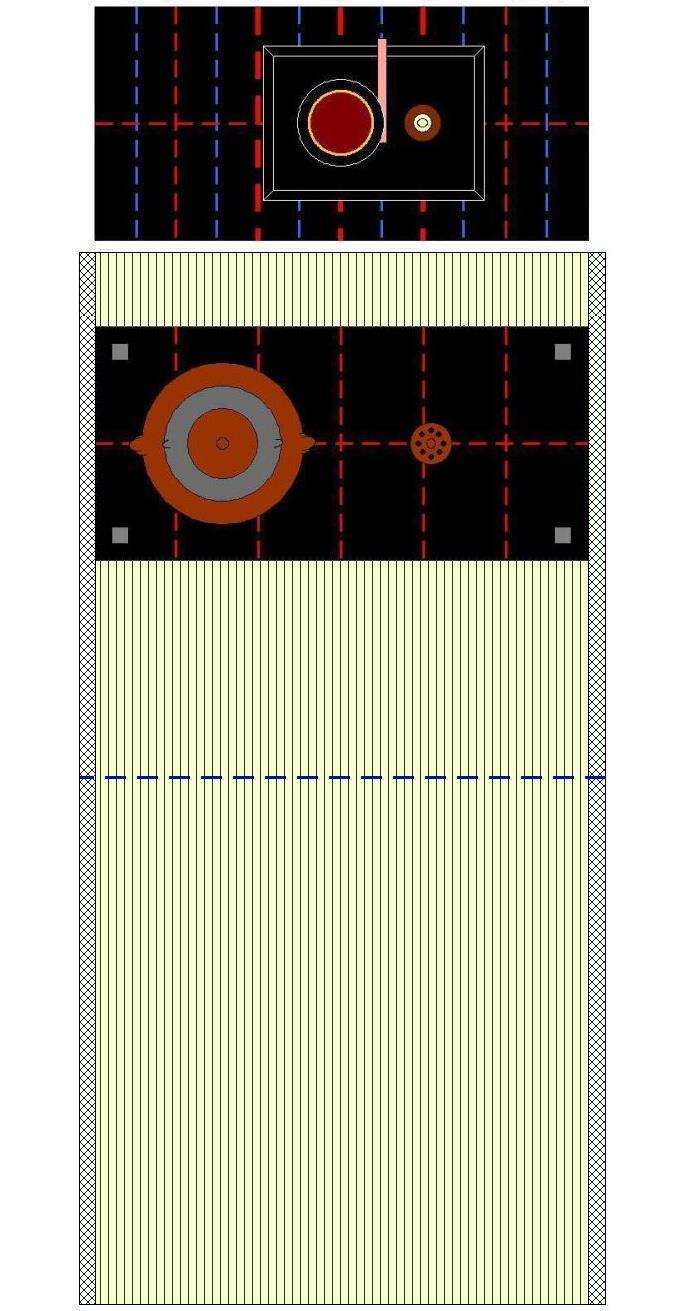
Here only the meibutsu pieces are arranged on the daisu:
◦ on the ten-ita, the Gassan-nagabon [月山長盆]† has been positioned so that the dai-temmoku and chaire both rest squarely on the central and first kane, respectively, with the chashaku (in its shifuku‡) placed in between so that it rests squarely on the interstitial yin-kane;
◦ on the ji-ita, are arranged the furo and kama, and the hoya only -- the hoya overlapping the first yang kane** by one-third.
According to Shibayama Fugen’s commentary, this is the way the daisu would have been arranged when the shōgun Ashikaga Yoshinori entered the room. After looking at the daisu, Yoshinori would have taken his seat, and then Akamatsu Sadamura would have begun what we might call his “pre-temae” -- readying the daisu for the actual service of tea††.
While both Shibayama Fugen, and Tanaka Senshō, discuss this sketch together with the one that follows‡‡, the length of my commentary has precluded my following their lead. Furthermore, studying the two sketches together seems to be more confusing than enlightening, thus I believe that there is something to be gained by looking at them one by one (while clarifying matters by redrawing the sketches to show precisely what is intended in each instance where they are mentioned in the kaki-ire). ___________ *Also, the actual positions of the utensils are somewhat ambiguous, perhaps deliberately so: if the person inspecting the sketch understands the details, then it will suffice; but if he does not, it becomes extremely difficult to reproduce what it shows correctly.
†The face of the Gassan-nagabon [月山長盆] was 1-shaku 2-sun by 8-sun; and it measured 1-shaku 3-sun 2-bu by 9-sun 2-bu across the rims.
Sometimes this tray is referred to as the Gassan-nagabon (or, simply, the Gassan-bon), and sometimes it is called the Tsuki-yama naga-bon (Tsuki-yama bon), alternate readings of the same kanji compound -- the latter being a “secret pronunciation” that was supposed to segregate the initiated from the ignorant. “Gassan” is the usual pronunciation of this compound.
‡The chashaku was tied in a shifuku that was shaped like a miniature cover for a sword.
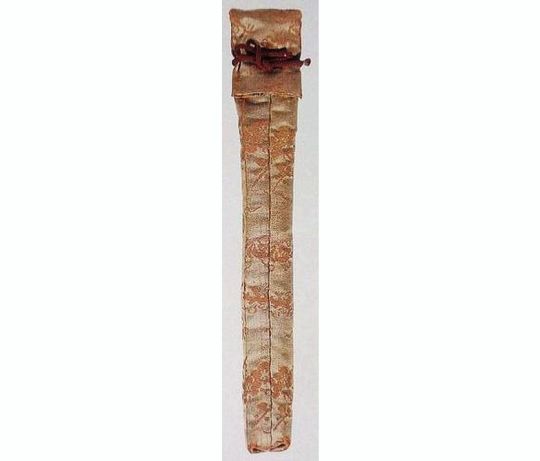
This is rather different from the hood-like shifuku that some schools use during their cha-bako [茶箱] temae.
While there are several possible ways that the shifuku-clad chashaku can be placed on the tray, the most common way is that shown in the sketch (with the bowl-end of the scoop resting against the far rim of the tray).
**The kane are counted outward from the center.
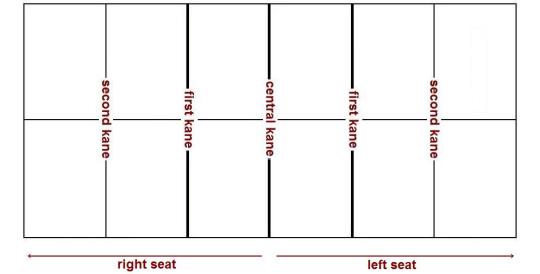
In other words, the yang-kane immediately to the right of the central kane is called the first kane; the right-most kane is called the second kane, as shown above. (In the Nampō Roku, the kane on the right side of the central kane are referred to as the left kane; and those on the left side of the central kane are called the right kane -- because the authors considered the utensils arranged on the daisu to be facing toward the host, a sort of reasoning that was intended to confuse the uninitiated. However, in my explanations I use the natural designation -- so left means left, and right is right.)
††It is this “pre-temae” that is being narrated here (albeit with many of the details eliminated).
‡‡Tanaka, especially, seems desirous of keeping his comments on these two sketches as sparse as possible -- probably because his school traditionally offers a special training course in this temae every year during the summer vacation season (for which the lesson fee is, frankly, beyond the reach of the ordinary student of tea).
¹Kore o-kimase mae no kazari nari [コレ御著座前ノカザリ也].
The Sadō Ko-ten Zenshū [茶道古典全集] edition of the Nampō Roku contains an error in this line. The second word should be o-miza [御看座], rather than o-kimase [御著座] (which, while the compound kimase is used as a name, it does not seem to have a meaning that can be applied here). However, whether this mistake was present in the Enkaku-ji manuscript (which is doubtful, since none of the other versions have this word), or a printer’s error, is unclear.
O-miza [御看座] would refer to the initial inspection of the room by the principal guest*.
O-miza mae no kazari [御看座前の飾], then would mean the arrangement (of the daisu) before said guest had entered the room†. __________ *In the episode that is being described here, this would seem to have been Ashikaga Yoshinori -- who is referred to throughout by his kaimyō [戒名] (the Buddhist name given to an individual after his or her death) of Fukoin-dono [普廣院殿] throughout this entry.
†Za [座], which means “seat,” is used in the sense of shoza [初座] (“opening seat,” in other words, the first part of a chakai) and goza [後座] (“the latter seat,” that is the part of the gathering when the tea is served) -- though this explanation is anachronistic (since the shoza-goza dichotomy did not exist before Jōō's time), and so has been translated “room.”
²Kayō no jūjū naru kazari no sai-sho no kazari ha, itsure ni te mo mōke no kazari to iu nari [カヤウノ重〻ナルカザリノ最初ノカザリハ、イツレニテモマウケノカサリト云也].
This is a rather difficult statement to translate, on account of its complexity (and, frankly, the repetitive use of the word kazari [飾]).
Jūjū-naru kazari [重々なる飾] literally means something like an overlapping series of arrangements -- that is, each succeeding arrangement is begotten by the first (through the process of adding something to it).
Mōkeru [儲ける] means to beget, generate, engender*. In other words, one arrangement engenders the next (by means of adding a new utensil); thus moke no kazari [儲けの飾] means the begotten or derived arrangement
The initial arrangement was modified by the addition of the hishaku to the objects displayed on the ten-ita of the daisu†.
Depending on the circumstances‡, the hishaku is either placed in between the kane**;

or, the hishaku is placed so that it overlaps the left-most yang-kane by one third, as below††.
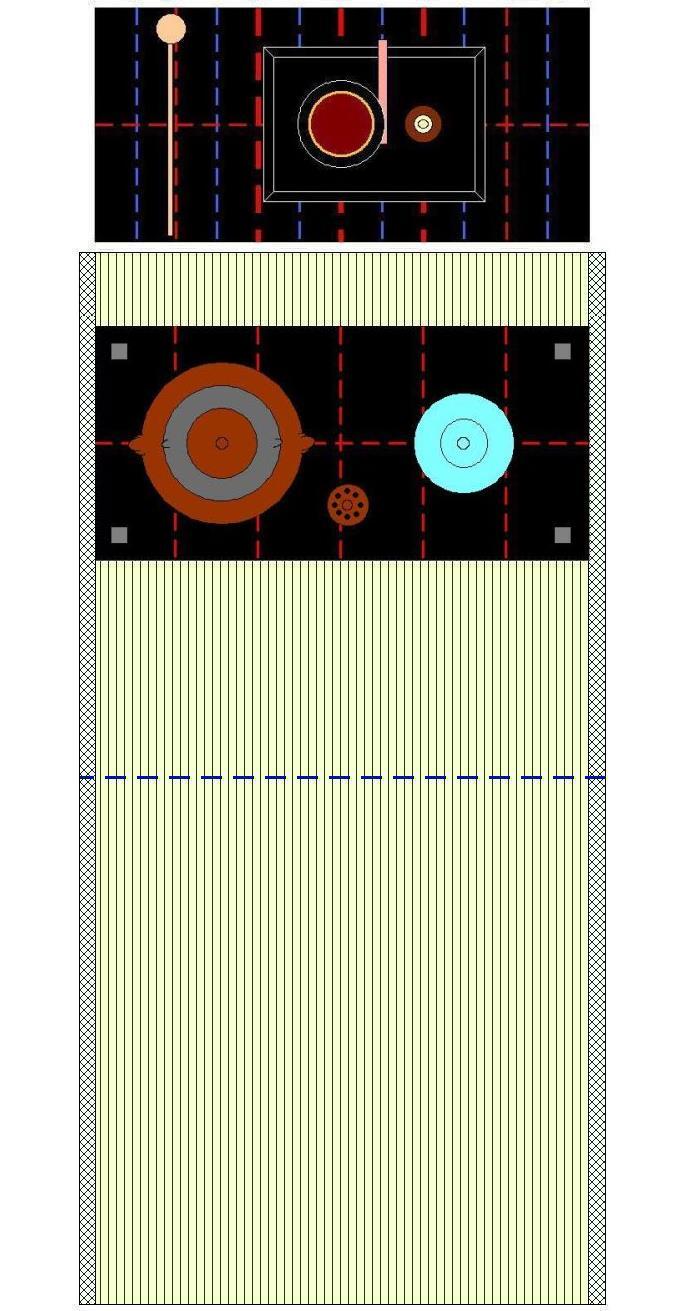
__________ *Today this word is most commonly used with respect to financial matters, and so means profit, obtain, earn, make (money).
†The hishaku was carried out separately, at the beginning of the temae, because doing so would allow the person who would be serving tea to greet the guest who would be drinking the tea. (If the mizusashi were to be carried out first, it would be impossible for the host to pause elegantly for this exchange of greetings. We must remember that, in the early days, the server was usually one of the dōbō-shū [同朋衆] -- and, generally, the one who was most intimate with the shōgun -- while the person served was usually the shōgun himself, or someone invited by him to receive this honor.)
‡Specifically, the demands of kane-wari, and keeping the total count for the goza yang. This is usually the reason behind such variable orientations.
**The intention is that the daisu should always be yang at the beginning of the temae. When only the furo and hoya are on the ji-ita, and the nagabon is on the ten-ita, the hishaku is placed between the kane, so it will not be counted. This keeps the total count yang.
††After the mizusashi has been brought out, the ji-ita will have three objects associated with yang kane, so the hishaku also has to be moved into an association with a yang-kane, in order to keep the daisu yang.
Note that while I have shown the hishaku overlapping the kane from the left (as it is shown in the Enkaku-ji manuscript, as well as in Tanaka Senshō’s commentary), Shibayama Fugen has it overlapping the kane from the right, as shown below (the dashed representation indicates the hishaku’s original position -- that is, where it was relocated from).

While there is really no rule that would give preference to one or the other, I am inclined to believe Shibayama’s interpretation might be preferred -- since it involves moving the hishaku toward the left only by a little (the subtle change in orientation is what the original text implies). This agrees with the way things are usually done in the Nampō Roku.
³Daisu ni te ha tabi-tabi aru-koto nari [臺子ニテハタビ〰アルコト也].
Tabi-tabi [度々] means oftentimes, frequently, time and again.
In other words, this kind of thing -- where the initial arrangement is subsequently modified over the course of the first several stages of the temae* -- was often seen in the old daisu temae, particularly when the idea was to “treasure,” or do honor to, one of the utensils. __________ *Most of these things came to be pushed into the naka-dachi as the modern period dawned, because they were considered to be too annoying to watch.
However, we must consider these things in terms of the original way that these temae were performed. In the early period -- as is true in this episode -- the host was usually a young man. And the guests took pleasure in watching such a person perform (in much the same way as we enjoy watching something like modern dance).
The host did not walk into the room and proceed to the temae-za, as now. Rather, after crossing the threshold (in several stages), he stood and walked (often across a distance of several mats) to the lower end of the utensil mat. There he sat down, and advanced toward the daisu on his knees (moving whatever he was carrying forward from that seated position). However, according to some scholars, rather than sitting on his knees, the host actually advanced in a squatting position (as was done when moving about the Imperial court), giving the appearance that the person was floating across the mat during this critical point in his temae. How elegantly this was done -- and an elegance of movement, almost feminine, was precisely the characteristic most deeply appreciated in the host's performance in this early period -- had a huge impact on the “success” of the temae.
The character of the performance is vastly different when a young man is doing the temae, in contrast to when an older man is doing it. (This is why it came to be said that “old men” should only officiate in the small room, where their physicality would not be put on public display to anywhere near the same extent as would have been the case in a larger room.)
⁴Seiko nado mo mōke ari [西湖ナトモマウケアリ].
Seiko [西湖] is a reference to a sort of box called a Seikoya [西湖家]*, shown below, in which a souvenir temmoku-chawan was packaged†.
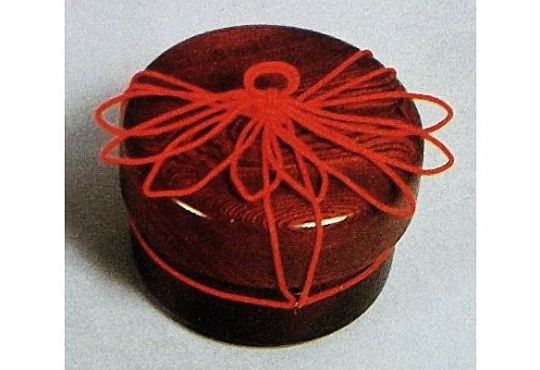
Be that as it may, the point is that in this temae (which will be narrated and discussed later in Book Six), first the temmoku, tied in its Seikoya‡, is displayed on the ten-ita of the daisu. Then, in the initial part of the temae, the host brings out a large round tray on which are arranged a chakin, chasen, and chashaku, and the bowl is removed from the Seikoya box and arranged on a temmoku-dai. Then the chaire is brought out, and the actual service of tea commences.
It is to temae of this sort, where the host performs a number of pre-service actions, that this sentence is alluding. __________ *Xīhú-jiā [西湖家] (Seikoya is the Japanese pronunciation) was apparently the name of a souvenir-shop, located at a scenic spot along the shore of the Xīhú [西湖], “Western Lake,” in Hangzhou, where this bowl and box combination was purchased. The name of the shop was written on the lid of the box (as is common even today -- though usually printed on stickers, rather than written in lacquer). The Xīhú has been a famous scenic area since at least the first century (the earliest known reference to this area is found in the Hàn Shū [漢書], written around 111).
†The original Seikoya is said to have been painted with black lacquer, with the name “Seikoya” written in gold lacquer. The bowl was apparently an ordinary Kenzan-temmoku [建盞天目], such as that seen below.

Another such box, this one owned by Ashikaga Yoshimasa, had the name Jìngshān-sì [徑山寺] (Kinzan-ji, in Japanese; the name of a famous temple located near the “Western Lake”) written on the lid -- apparently having been purchased at a souvenir shop located within the grounds of that temple. Yoshimasa’s Seikoya and its temmoku were destroyed when his storehouse was burned down (it is not known what happened to the other Seikoya, though it is presumed to have been lost during the wars of the Sengoku jidai as well).
It should be added that certain scholars (whose arguments are quoted by Tanaka Senshō in his commentary) state that the Seikoya, and the temmoku bowl that it contained, were used as packaging for special flavored miso (used as a dipping sauce for raw vegetables), that was sold in the gift shop (such things -- flavored with unique local ingredients -- were popular, and relatively inexpensive, souvenirs). This adds weight to the argument that the temmoku “chawan” were not used for drinking tea in China, but were actually made for some other purpose; and came to be used as chawan only in Korea and Japan, after their original contents had been used up, and the bowl was all that remained. In this case, they explain that the indentation, just below the rim, allowed a cover of oiled paper to be tied over the mouth of the bowl, to keep the miso from drying out.
‡As seen in the photo, an elaborate knot was used to tie the Seikoya closed. Untying this knot elegantly was a feat of dexterity in itself; and, at the end of the temae, the knot had to be recreated before the Seikoya could be returned to the ten-ita.
⁵Tsuzuki nari [ツヾキ也].
In other words, the utensils occupy successive kane: the dai-temmoku rests squarely on the central kane; the chashaku is placed squarely on the yin-kane immediately to its right; and the chaire, squarely, on the first yang kane to the right of the central kane.
⁶Hatsu ni ha kaku no gotoki mizusashi nashi ni hoya ha kari ari [初ニハ如此水サシ��シニホヤハカリアリ].
The hoya was placed on the right side of the ji-ita when the daisu was being set up (so that the ji-ita would not appear so empty), and remained there until the mizusashi was brought out from the katte during the first part of the temae.
⁷Mōke no toki ha hishaku kane wo hazushite-arishi ni [マウケノ時ハヒサクカネヲハヅシテアリシニ].
Mōke no toki [儲けの時] means “when (the hishaku) was added to (the ten-ita of the daisu).”
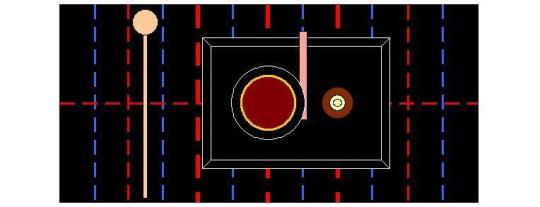
Kane wo hazushite-arishi [カネを外して在りし]: hazushite [外して] means was taken off, displaced; arishi [在りし] means to exist in the state of (having been displaced). This is the situation shown above.
⁸Akamatsu hakobite no kazari no toki, kazu wo kanben-shite kane ni san-bun kakari ni oki-shi nari [赤松ハコビテノカサリノ時、數ヲ勘辯シテカネニ三分カヽリニ置シ也].
Perhaps the wording of this sentence was made deliberately obscure, so that the uninitiated would not understand what was intended.
Akamatsu hakobite no kazari no toki [赤松運びての飾の時]: Akamatsu [赤松] refers to Akamatsu Sadamura; hakobite no kazari no toki [運びての飾の時] is alluding to the next step in the temae, where the seiji unryu-mizusashi is brought out from the katte and arranged on the ji-ita of the daisu.

The phrase is written in the past tense, because it is only after the mizusashi has been brought out, arranged on the ji-ita, then filled with water, and the hoya placed between the furo and mizusashi (as shown above), that the hishaku is moved onto the kane.
Kazu wo kanben-shite [數を勘辯して] means something like “in order to make allowances* for the [increased] number [of objects]....”
Kane ni san-bun kakari ni oki-shi nari [カネに三分掛かりに置し]: kane ni san-bun kakari [カネに三分掛かり] means to overlap the kane by one-third; oki-suru [置きする] means to (actively) place, or reposition, something.
This sentence is referring to the repositioning of the hishaku -- after the mizusashi and hoya have been arranged on the ji-ita.

This is the final step in the “pre-temae,” as it were. From this point on, Sadamura would have begun the actual service of tea for the shōgun Yoshinori. ___________ *Kanben-suru [勘辯する] literally means to pardon or forgive. Here the nuance is to make allowances for (the increased number of utensils), by changing the position of the hishaku, so it will not be counted.
1 note
·
View note
Note
Hey, could you tell me what Kirnamala’s story is because I was not able to understand Wikipedia’s version 😭
The actual ‘Arun Barun Kiranmala’ story right??? 😭😭
Yeah don't go to wikipedia it's shit there, and that serial thing also exist so not good
This is actually my favourite Thakumar Jhuli tale I love it sooooo much Kiranmala is a fucking Queen, she'd always be my favourite girl.
Now get ready cuz this post is gonna be LOOOOOONGGGG
Also trigger warnings: mention of infanticide... Kinda? and bitchass peoples all over, killing those bitchass people and swearings.
So the story is kind of simple, it starts with the King (like any other tales)
The king was out one day, roaming around the city in disguise to know what people's problems were and stuff and hears this three sisters talking with each other.
The eldest said how she if she married (I forgot what she said sorry TvT) she'd be the happiest
The second one said that if she married the royal cook she'd be the happiest
And the youngest said, she'd be the happiest if she married the king himself and became the queen (lol! confidence gurlie confidence) and the others laughed at her
.......
So the king leaves after hearing everything, and next day he calls for the sisters to his court. Now obviously the sisters are scared shitless cause whytf was the king calling for them... So they go to the court
And king dude asks them to say what they were talking about last night, and the older two fearfully tells him. But the youngest gets obviously embarrassed and scared thinking she's gonna get punished. So the king reassures them, that they'd get what they had wished for.
So yeah oldest sis got married to her man of dreams and the middle one also married the cook. And king dude married the youngest one and made her the queen (I mean that's some really impressive rizz game he got tbh 🗿💀)
Now they are married and should be happy just as they wanted right? Yeah no lol then how would the story progress...
.......
So some years pass and the queen is now pregnant and the king dude, makes a diamond studded gold gold marble room for her to give birth (what do you call that? In bengali we say Atur Ghor)
And now queen requests him to let her sisters visit cuz she was missing them and wanted them to be present in the Atur Ghor and be her midwives. And the king agrees cause he couldn't deny anything to his wife.
But but but when those sisters came to the palace, they were in awe of how luxuriously their sister was living as the queen, and grew jealous.
So now the queen gives birth to a beautiful baby boy and the what the sisters do? Puts him in a jar, stuffs his mouth with salf and cotton and floats him in the river 💀 (like the audacity!!!)
The king asks what happened and they reply with that the queen had given birth to a puppy 💀 and shows him a new born puppy.
He just stays silent, obviously heartbroken wondering what happened...
So next year the queen is again pregnant and the sisters again come, she gives birth to another beautiful baby boy and they again stuff his mouth with salt and cotton and puts him in a jar, again floating him in the river 💀
The king again asks what happened and this time they reply she gave birth to a kitten showing him a kitten fetus thing and he again stays silent wondering how all thus was happening.
Third year same shit, a baby girl is born and the evil bitches again puts the cutie in a jar and floats her in the river like her brothers... :(
And shows the king a wooden doll, a literal freaking wooden doll 💀💀
.....
This time the king sits in despair and his people tells him, the queen must be some bad omen, alakshmi, a monster since the same thing keeps repeating every year, and he wonders it mist be true she must be some witch or something.
The people tells him, he should throw her away and he decides he'd do that and actually throws out poor queen :( out of the kingdom, not before the people publically shames her and all.... Yk the typical beizzati karna... 💀
And those evil psycho bitches happily go back to their own houses.
......
Now this side, a brahmin was bathing in the river when he noticed a jar floating. Not just any jar but a jar with a baby crying in it. So he hurries to get the jar and sees a beautiful godly baby boy in it. He washes all the salt and stuff and brings the baby home with him.
Next year he sees another jar, this time another beautiful baby boy in it and yet again he brings it home with him
Again same things happen the following year and he sees another jar, this time a beautiful baby girl in it, and he as usual brings her home with him.
Since he had no kid he adopts the trio as his own and decides to raise them.
AND THE ARE THE ICONIC TRIO — ARUN, BARUN AND ✨KIRANMALA✨
......
The kids grow up under his care, and they were like dev shishu, beautiful talented brightening the whole house.
Since they came in his life, the brahmin became RICH. Like good crops, more than enough milk from the cow, and everything. He became successful. They were like his lucky charms.
So now the kids are grown up and they are exceptional in everything, the bestest children anyone can ask for 😌 They take care of the house, learn scriptures from him and does everything, helps others and animals, looks good (yes ik this is propaganda)
One day brahmin calls them and caresses their head, telling them to live properly and happily and a lot more emotional stuff and... dude... dies... 💀 (ahh sadness we love you)
So Arun Barun Kiranmala becomes sad and cry that their father is dead and decides to follow the instructions and live harmoniously together.
.......
So back to daddy dearest king, he's in dispression for all this years thinking his kingdom must be cursed or something, and decides he'd go for hunting.
But when he was hunting, some shit happens... Sky lord got angry and made a hell lot of storms and rain, practically ruining his little kitty party and making him lose his way.
Next day he's roaming around looking for any house because he's so thirsty and would probably die without water.
He finds a house (you guessed correct!) and goes there begging for some water, and Arun Barun Kiranmala stares at him like 😶 as they bring him water to drink. He drinks it and then looks at the trio in awe, wondering who these godly looking younglings are. He asks them and they say they are brahmin's kids. (Love ya papa 🗿)
Hearing them, he kind of becomes emotional as he feels his heart beating faster (instincts? Ig..?) and cries a little as he tells them he's the sad king of that kingdom and if they even need anything they should tell him. Then he leaves.
......
So, now our baddie Kiranmala, innocently asks her brothers that “what does a king have?” and they say that they don't exactly know but have read in the books that a king has elephants, horses and palaces. So Kiranmala says that, “fuck elephants and horses we can't find them but make me a palace” 🗿 (I love her so much)
So her pookie cookie brothers say “okay” and gets to work. They literally work hard for 1 year 36 days nonstop without caring about hunger or thrist and built the palace. On exactly 1 year 36 days the palace is ready (yayayaya!!!)
Now the palace is made of marbles and diamonds and many other stones, with silver doors, golden tops, gardens, flowers, trees everything you can imagine. It's beautiful af. ✨🗿🤌 (Arun Barun legendary people)
.....
Now one day a sanyasi comes to their palace and while they were talking to him, he rambles about great many things like silver tree with golden fruit, a diamond like water fountain and a golden bird saying only those things would suit such a beautiful palace like the trio's.
So they ask where the can find those things and the sanyasi gives them the location and leaves. It's in some mystic mountain and all i forgot the details lol
.....
Arun decided he'd go get those things, and instructs Barun and Kiranmala to stay home and wait for him, giving them a sword saying if the sword starts to rust they'll know he's dead.
So months pass and Arun hasn't returned and the other two check his sword each day to see. But one day Barun notices the rusting, and breaks down crying, as he decides to go for himself.
He gives Kiranmala a bow and arrow saying if the tip of the arrow becomes blunt and the bow string breaks she'd know he's dead too.
So now Kiran is left home grieving and Barun is on his way to the mountain.
As Barun reaches the mountain, he sees the most beautiful place on earth, apsaras dancing and singing and all the magical creature and fog and everything. But suddenly he hears some voices calling his name from behind him and he turns around and BOOM he's a fucking stone statue (that's why you don't respond to strangers 🗿💀)
Barun wonders who'd save them as he realises both him and Arun are stone now.
......
Back home Kiranmala notices the blunt arrow tip and broken bow string realising both her brothers are gone, but she doesn't cry.
My girlie does all her house chores and then gets dressed like a warrior then kisses that cow's (it's name was Kajal Lata btw) bachhra and sets out for the mountain 🗿
And she's a badass, she's going by the speed of lighting not even stopping at anything. It takes her 33 days to reach the mountain.
Once she's at the foot of the mountain it's as if all kinds of calamities break down on it. Monsters and demons and ghost and wild animals all surrounds her and those weird ass noices come from all angles asking her to look at them behind, mistaking her for a prince.
BUT my bbg literally stops at nothing and runs the horse straight to the top where the silver tree and the fountain was, gripping her sword and all. 🗿🗿 (I love her so much ugghhh)
......
Once she reaches the tree, the golden bird tells her (yes it talks) to take all the things— the tree, the fruits, the sword, the bow, the arrow, the gems, the bird itself. Every single thing over there and then to beat the drum. And Kiranmala does as the birby say and as she beats the drum, all the chaos stops at the mountain and it becomes quiet. (Ok yeah maybe listen to birds who knows... I still hate birds tho)
Then birby tells her to sprinkle the entire mountain with that fountain water and as she does that, all those stone statues of all the people who had been there for so long turns back into humans and they all pay respect to her 🗿 Bahubali style 🗿 calling her the greatest in 7 yugas (exaggeration but honestly she's the QUEEN 👑 🗿✨)
Then Arun and Barun gets emotional and hugs her and yay!
......
They get back to their palace (which now isn't a palace but a whole ass land of wonder) and plants the trees and it starts to grow diamond and and gold and pearl and all. And that birby sits at the diamond tree and starts to sing. Then they put the fucking fountain amidst all these. 💀
And then they start to live their happily (you thought it's the ending? Nahi climax abhi baki haiiii)
Then one day birby tells them that they should invite the king to eat. So Arun Barun and Kiranmala are like
The trio: but what will we feed him??
Birby: I'll see that, just invite him
The trio: ok
And so they send him invitation 🗿✨
.....
This side daddy dearest hears about the wonderland the trio had created and is surprised those kiddos did so much, and then he recieves the invitation and he's like “hmmm gotta go and see for myself now aight”
And so Rajaji sets for their palace. Once he's there he's literally shik shaak shock seeing all the treasures and things everything, he makes the shocked pikachu face as he slowly starts to get emotional again, and cries badly thinking about not having kids and how he wished Arun Barun Kiranmala were his own kids.
He tells them to take him inside, and he's even more shocked when he sees the inside of the palace.
.......
Then they make him sit at the dining hall, and brings out all the varieties of foods, and now king bro is excited to eat because he's smelling the good food (feel you bro feel you)
All types of sweets, and foods and everything imaginable. So he picks up a bite but drops it asap as he realises everything infront of him is made of gold coins and gems.
So now he asks them if they are making fun of him or joking with him, and he gets the reply “why can't you eat it???”
King dude: it's all gold!!
???: yeah but why can't you eat it??
He sees a golden bird is talking to him and
King: yeah but it's fucking gold!!!
Birby: can a human give birth to a puppy??
King: huh?
Birby: tell me can a human give birth to a kitten??
King: ...huhh??
Birby: tell me king if a human can give birth to a wooden doll why can't a human eat gold???
King: ..... you're right.... Ohh how wrong I was!
.......
So basically the birby lectures dude about everything and makes him realises his mistake, as he breaks down crying (atleast bro ain't a toxic alpha male 💀🤌) as the bird says that these three beauties are his real kids, and those evil bitches masi(s) were the reason for all the puppy kitten wooden doll drama.
They all hug as the king cries in despair saying how he wishes his queen was with them right now. And birby tells Arun Barun Kiranmala that their mother stays in a hut on the other side of the river and instructs them to bring her as she's living her days in struggle and sadness (i mean that's obvious 💀)
.....
They bring back the queen, the king shifts his capital to that wonderland and everyone stays happily yay!
Aaaand as for those evil bitches, yeah king dude sends his men to burn down their houses and then nail them and bury them alive 💀💀
........
SOOOO THAT'S THE END OF THE STORY YAY
Im sorry it took me so long hehe,and even more sorry the post is so long (and not proof read so forgive the mistakes and typos ill see it soon)
Honestly it's my favourite story ever I love Kiranmala so much she's my babygirl shdggdbdsnndbd
#arun barun kiranmala#kiranmala#kiranmala is a queen#thakumar jhuli#bengali thakumar jhuli#bengali literature#banglablr#cutu cutu mutuals#shaku answers#desiblr#shaku tells stories#shaku does commentary#rupkothar golpo
41 notes
·
View notes
Text
Nampō Roku, Book 5 (8): the Ordinary Round Tray, with the Chasen Displayed Apart from the Chawan¹.

8) Tsune no maru-bon ・ chasen midare-kazari [常丸盆・茶筌乱飾]².

[The writing reads: (between the ten-ita and the ji-ita) shita jo-jō (下如常)³; (to the left of the drawing of the daisu) kaku no gotoki kazari ha tsune no chaire, chawan nari (如此飾ハ常ノ茶入、茶碗ナリ)⁴, chakin tatamite wan naka (h)e iri-oki (茶巾タヽミテ碗中ヘ入置)⁵, bon mo tsune no maru-bon nari (盆モ常ノ丸盆ナリ)⁶, chasen okuri-tari shu aru-toki, kaku no gotoki mo yoshi (茶筌贈リタル衆有時、如此モヨシ)⁷.]
_________________________
◎ For whatever reason, the five kane are not indicated on this sketch. It was assumed (by Shibayama Fugen, as well as this author) that the chawan and chaire are oriented in the same manner as in the previous arrangement.
He also points out that “the chasen here is oriented on the same kane as was the chashaku [when placed between the chaire and the chawan] in the previous arrangement.” (That orientation was, of course, not depicted in the sketch.)
¹Midare-kazari [乱飾] refers to the case where the chasen is displayed apart from the chawan.
Sometimes the chasen stands upright, and sometimes it rests on the chakin.
²Tsune no maru-bon ・ chasen midare-kazari [常丸盆・茶筌乱飾].
Tsune no maru-bon [常丸盆] refers to the naka maru-bon [中丸盆] described in the previous installment. The tray was 1-shaku 2-sun in diameter, though a raised band running around the middle of the side increased that to 1-shaku 2-sun 3-bu.
At the time when these arrangements were documented, the naka maru-bon was the copy made by Haneda Gorō for Ashikaga Yoshimasa, painted with kagami-nuri, without any other decoration (though the raised band was preserved in his copy), while many later copies were also available.
³Shita jo-jō [下如常].
Referring to the kaigu displayed on the ji-ita of the daisu, their arrangement was as usual.
⁴Kaku no gotoki kazari ha tsune no chaire, chawan nari [如此飾ハ常ノ茶入、茶碗ナリ].
“As shown [here], this arrangement is for an ordinary chaire and an ordinary chawan.”
An “ordinary chaire” was, at the time when the details of this arrangement were being finalized, usually a large katatsuki, measuring 2-sun 5-bu in diameter. Usually it would have been a karamono chaire, though, since the middle of the sixteenth century old Seto chaire were also being used in this way.
An “ordinary chawan” is more difficult to define, though it, too, would have been imported from the continent. Since Shukō’s day, the usual chawan for wabi-no-chanoyu (of which this is one arrangement) was a large chawan. Shukō’s large chawan were the Shukō-chawan [珠光茶碗], which measured 5-sun 2-bu in diameter, and his ido-chawan (the bowl now known as the Tsutsu-i-zutsu [筒井筒]), which measures 4-sun 7-bu across. The bowls which entered use during Jōō’s lifetime were generally 4-sun 9-bu, and so midway between the earlier extremes.
A chawan of a size similar to Shukō’s beloved ido-chawan could be used for this arrangement easily*, but as the chawan gets larger, things become more difficult, due to the size of the tray.
Small chawan were also available, albeit rarely seen (apart from the various types of temmoku)†. These bowls (which appear to be what is featured in the sketch found in Shibayama Fugen’s commentary) usually measure around 4-sun in diameter‡. ___________ *When arranged together on the naka maru-bon, there is a space of 1-sun 5-bu between the chaire and a chawan of a size similar to Shukō’s ido bowl. This is shown below.

The difference in where the tray is placed between what is shown above, and the arrangement using a small chawan, below, is very small (a matter of just over 1-bu). But as the chawan gets larger, the deviation increases.
†The separation between a small chawan and the chaire, on the tray, is 2-sun, as represented in the following sketch.
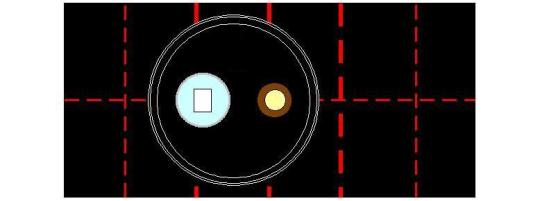
‡Small chawan became more and more available over the course of the sixteenth century, and they became increasingly the norm starting in the 1570s -- with the advent of locally made bowls. The apparent preference for a small bowl shown by the author of the kaki-ire is probably anachronistic, and reflective of Edo period sensibilities.
⁵Chakin tatamite wan naka [h]e iri-oki [茶巾タヽミテ碗中ヘ入置].
“After the chakin has been folded, it is placed inside the chawan.”
In the case of a temmoku (and, presumably, other chawan that are used in the same way), the chakin is folded as shown below.

The chakin was placed on the bottom of the chawan, as shown below -- flat, but with a slight pinch in the middle (to make it easier to pick up).

For a large chawan (such as an ido-chawan), the chakin was folded a little differently.

⁶Bon mo tsune no maru-bon nari [盆モ常ノ丸盆ナリ].
“The tray is also the ordinary (naka) maru-bon.”
It appears that the person responsible for this kaki-ire understood the adjective tsune no [常の]* in the title to refer to the collection of utensils as a whole. So they decided to add that the tray was also the usual one that was traditionally used with the daisu†. __________ *Tsune no [常の] means “ordinary,” “usual.”
†The original Haneda Gorō-made copy of the naka maru-bon is currently in the possession of the Nishi Hongan-ji [西本願寺] in Kyōto, where it is used to display the famous bonsan [盆山] Zan-setsu [殘雪] and Sue-no-matsuyama [末ノ松山] -- both of which eventually passed from Ashikaga Yoshimasa to the Ishiyama Hongan-ji [石山本願寺], and thence to the Nishi Hongan-ji, when that temple was reestablished (on Hideyoshi’s orders, as two competing congregations) in Kyōto.

Yoshimasa himself established the precedent for using this tray in this manner (because, among the original six meibutsu trays, only the original naka maru-bon had a brass plate inlaid into the face of the tray, which would protect it from being damaged by the granitic sand that was traditionally used in the display of a bon-san). And though Haneda Gorō’s copy lacked this brass plate, the copy continued to be used in the original manner.
By Jōō's time Haneda Gorō's copy had been so badly damaged that it could no longer be used for chanoyu. Consequently, high-quality copies of Gorō's tray had proliferated between the end of the fifteenth century and Jōō's day, since this was one of the most popular trays employed by the machi-shū chajin (whose usages are preserved in Book Five of the Nampō Roku).
Note that in the photo above, the viewing-stone (Sue no matsuyama) has been placed on a piece of coarse paper, rather than a bed of sand.
⁷Chasen okuri-taru shu aru-toki, kaku no gotoki mo yoshi [茶筌贈リタル衆有時、如此モヨシ].
“When the people who presented the chasen [to the host] are present [as the guests], it is appropriate to do things like this.”
The circumstances surrounding this statement are difficult to comprehend (since shū [衆] usually refers to a large group of people, the masses); and while it could possibly mean the group of guests, it can never refer to a single member of a group. Furthermore, if it does refer to the group of guests as a whole, it is difficult to imagine them all chipping in to buy the host a chasen (especially during the Edo period -- we must remember that these kaki-ire appeared sometime after 1690 -- when chasen were being mass-produced, so that their cost was no longer prohibitive). Perhaps it is addressing a situation where a chasen was presented to the host as a token on an auspicious occasion -- such as at the new year -- though I can find no references to any such historical practice. At any rate, this means that whenever the host is making use of the chasen that was presented to him by the people to whom he is serving tea, arranging the naka maru-bon in this way is appropriate -- since it, in a sense, it might be considered a way to focus the attention on the chasen. Possibly it was the result of a misinterpretation of the expression “chasen-kazari” [茶筅飾] (which was a wabi version of midare-kazari, albeit one intended to draw the guests’ attention, not to the chasen, but to the chawan or chaire) -- though this hardly seems the sort of mistake that we would expect scholars to commit.
Shibayama Fugen declines to make any comment on this statement at all.
While this line speaks about the chasen, no mention has been made in the kaki-ire, nor in the sketch, about what to do with the chashaku. However, both Shibayama Fugen and Katagiri Sadamasa (who included this arrangement in the second of his treatises on the use of the daisu in Jōō’s period) indicate that the chashaku should be displayed horizontally in front of the chawan and chaire, as in the previous arrangement. This idea is illustrated in a sketch from Sekishū’s manuscript (below).
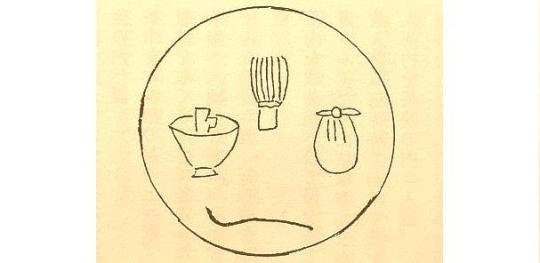
Here this illustration has been redrawn to show the arrangement of the objects on the naka maru-bon when a large chawan is used,

and when the chawan is a small bowl.

——————————————–———-—————————————————
◎ Analysis of the Arrangement.
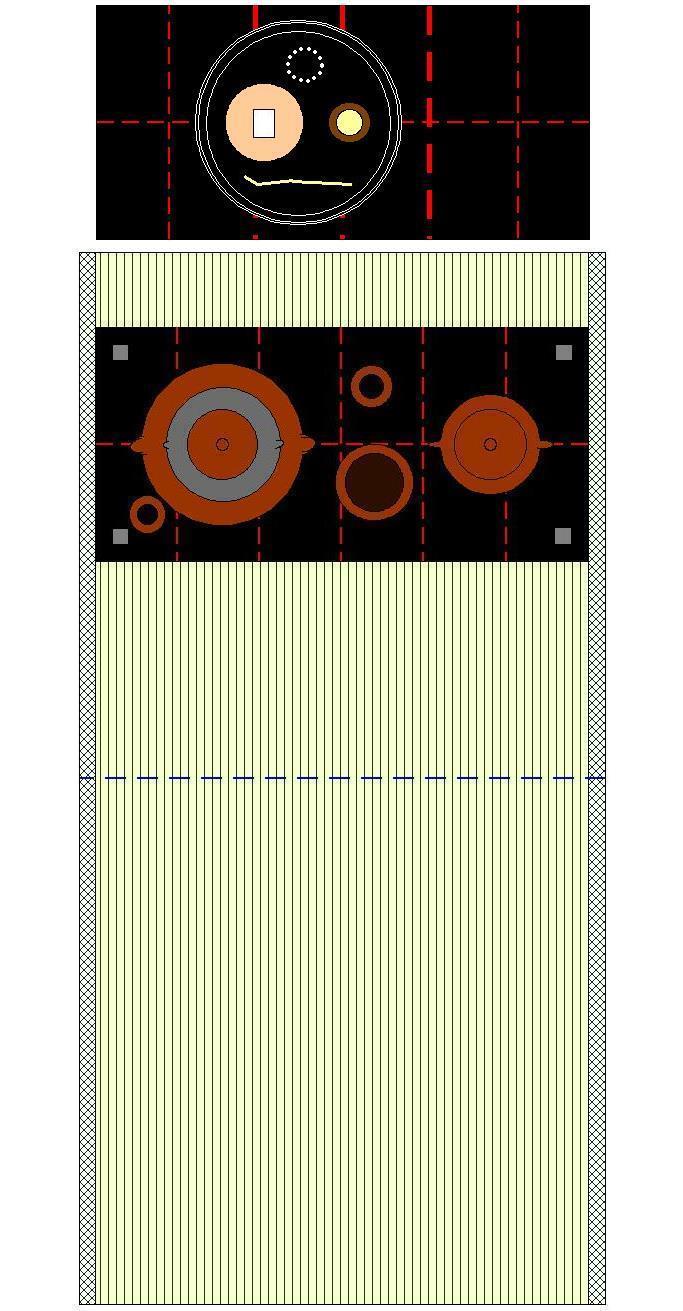
Above, the arrangement of the daisu is shown when a large chawan is used (the distance between the chawan and the chaire is 1-sun 5-bu); and, below, the temae.
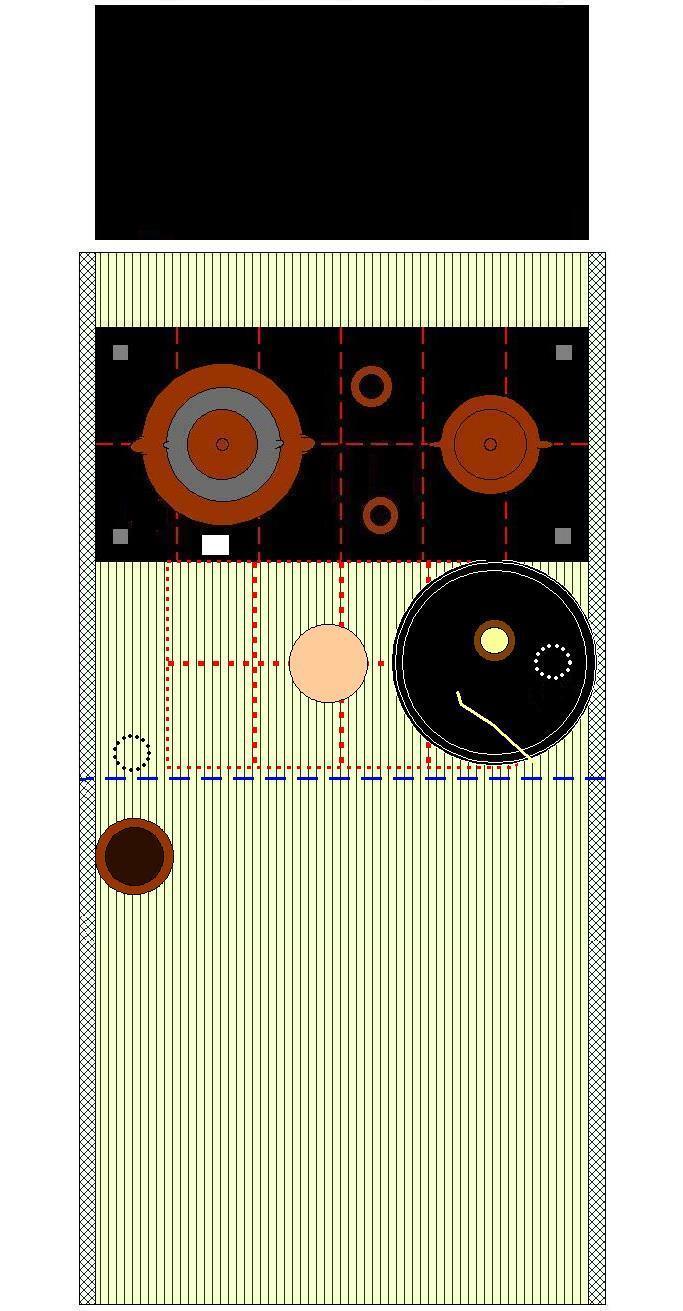
And here the same when a small chawan is used:
◦ the initial kazari (the space between the chawan and the chaire is 2-sun);

◦ and the arrangement of the utensils on the mat in front of the daisu during the temae.

5 notes
·
View notes
Text
Nampō Roku, Book 5 (25.1), Appendix: Pictorial Representations of the Utensils Mentioned in the Previous Post [Nampō Roku, Book 5 (25)].

◎ This appendix presents the collection of photographic images that should be associated with the post entitled Nampō Roku, Book 5 (25): the Display of the Sorori [ソロリ], Gōsu [合子], and Shishi [獅子].
Due to the length of the previous post, it was impossible to include images of all of the different utensils mentioned in the text. As a result, rather than show pictures of only some of the objects, it seemed best to create an appendix, wherein I can include photos of all of the utensils that were used in ancient times as the kaigu on the ji-ita of the daisu. It is important for the reader to understand that the matched sets of kaigu that are commonly sold today did not begin to appear until the second half of the sixteenth century¹, and even then, the preference seems to have been for pieces selected independently, so that they would complement each other both in terms of shape and decoration, and color.
While most of these things were made of bronze, this metal was available in a range of different colors during the fifteenth and sixteenth centuries. And while some of the colors were the result of natural oxidation, the Chinese and Koreans were expert at producing specific colors. Newly cast bronze is yellowish: this is called ō-dō [黄銅] -- and this name is used even when slight natural oxidation occurs. The most common rich brown color is called karakane [カラカネ]². Continuing to treat the metal³ results in a purplish shade, which is known as shi-dō [紫銅].
As bronze ages, it naturally turns black (this is called ko-dō [胡銅]⁴), and then green (sei-dō [青銅]). While the color can indicate a piece’s age, both of these colors, too, have been created artificially since antiquity.
I. Kama [釜].
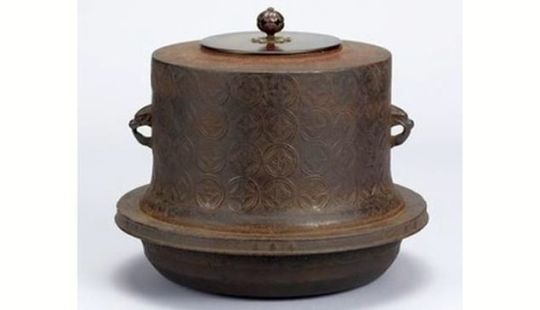
◦ Sha-jiku kama [車軸釜].

◦ Kiri-gama [桐釜]⁵.
II. Furo [風爐]⁶.

◦ Dai Chōsen-buro [大朝鮮風爐].
III. Mizusashi [水指].

◦ Mumon mizusashi [無紋 水指];
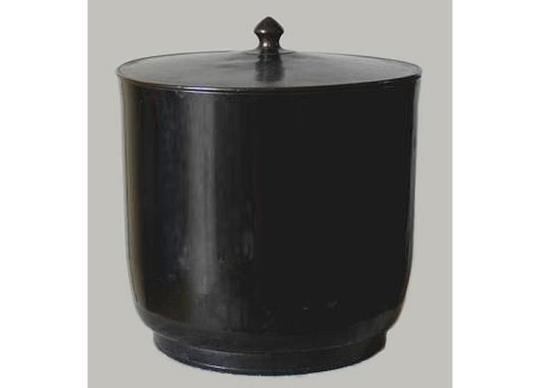
◦ Minna-guchi mizusashi [皆口 水指]⁷.
IV. Hishaku-tate [柄杓立].
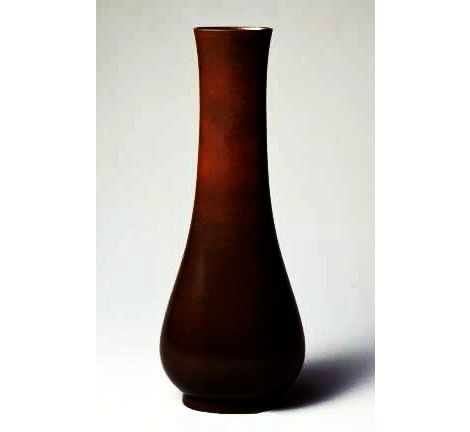
◦ Sorori [ソロリ, 曽呂利];

◦ Kōji-guchi [柑子口];

◦ Momo-jiri [桃尻]⁸.
V. Futaoki [蓋置].

◦ Ya-gaku shishi [夜學獅子];
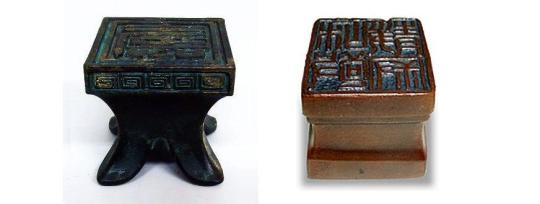
◦ Mikotonori-no-shirushi [勅印]⁹.
VI. Mizu-koboshi [水飜].

◦ Gōsu [合子, 盒子];

◦ Sori-guchi [ソリ口, 反り 口]¹⁰;
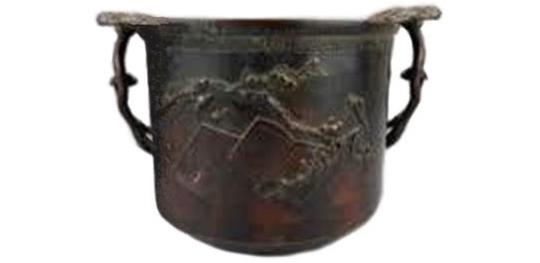
◦ Mimi-guchi [耳口]¹¹.
_________________________
¹The Hosokawa family owns one of the earliest sets known, procured (perhaps ordered) while Hosokawa Tadaoki [細川忠興; 1563 ~ 1646] (better known in chanoyu as Hosokawa Sansai [細川三齋]) was in Korea as part of the first invasion of the continent (in 1592). The kama, furo, and mizusashi all feature matsu-gasa kan-tsuki [松笠鐶付], imitating the kan-tsuki on Rikyū’s second small unryū-gama.
²The word is usually written karakane [唐銅] (“Tang” bronze”) -- though, since many of these pieces were actually cast in Korea, the homophone karakane [韓銅] (Korean bronze) would probably be the better name. Unfortunately, preferred Japanese usage seems to be based largely on a deliberate attempt to disassociate chanoyu (and everything else) from any association with Korea, in so far as that is humanly possible. In large part, this was because the Japanese government (in concert with the tea schools) deliberately associated chanoyu with ultra-nationalism during the early 20th century (which was at the same time that the occupation forces were perpetrating innumerable atrocities on the Korean peninsula, while the host of Western-trained Japanese anthropologists -- who were sent there because their investigations into the Japanese Imperial Tombs showed that virtually all of them were misattributed, resulting in the scholars being exiled to Korea as a group, since permission to do further work in Japan was refused -- were arguing that virtually every cultural element in Japan, from the Manyō Shu onward, and including chanoyu, came from Korea).
³The actual percentage of copper in the alloy, as well as other natural contaminants, also affects how the metal responds to oxidation, and the color that results. This is what often makes reproducing ancient bronzes difficult: even using the original techniques, it is frequently difficult to match the composition of the metal that was actually used.
⁴Ko-dō [胡銅] means “barbarian bronze” -- though the nomadic peoples to whom this designation was usually applied would not have the technological skills to produce bronze. Perhaps the name was coined because the nomadic tribes were found to be using bronze pieces (made by other cultures, often centuries before) that had oxidized black -- continued use prevents the bronze from developing the green patina.
⁵Note that at the time when the majority of the daisu-temae were originally created (which was during Yoshimasa’s lifetime), this kama was intact. It was a kiri-kake kama [切掛釜], made to rest on a bronze kimen-buro. The kama was subsequently damaged (the rusting out of the bottom suggests that it was stored improperly), and repaired (to its present state), presumably by Jōō -- who treasured it and used it as a tsuri-gama (contemporaneous accounts suggest that this was, in fact, the first tsuri-gama, appearing at the time when Jōō first began to use the ro) -- since the irregularity of its sides precluded it from being rested on a furo.
⁶In the second kaki-ire it says, with regard to the furo: furo ha, dai-chōsen mata ha shishi-no-dai nado tote arishi nari [風爐ハ、大朝鮮 又ハ獅子ノ臺ナトヽテアリシ也]. Apparently the shishi-no-dai [獅子ノ臺] was a type of furo, but it has not been identified (indeed, both Shibayama Fugen and Tanaka Sensho pass over this sentence without even acknowledging its existence).
There is some speculation that this means a furo shaped like (or perhaps even made out of) a large bronze censer (of the sort, sometimes seen in temples, that have a shishi crouching on its lid, two examples of which are shown below) -- perhaps with vertical handles rising upward from the sides of the neck.
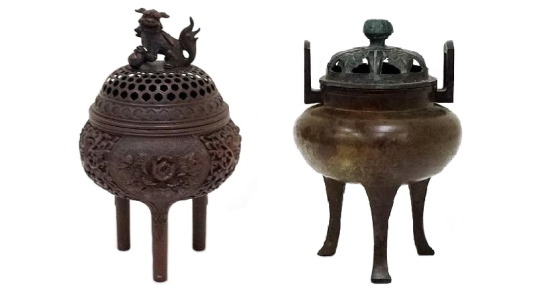
Others imagine that it was similar to a Ryūkyū-buro [琉球風爐] -- with (or, perhaps, without) the upright ears (this would also resemble certain Chinese kōro that are decorated with a crouching shishi on the lid).

Given the needs of the temae, the ears (if there were ears) would not project outwards on the sides (so that the diameter of the furo alone defined the space it would occupy on the daisu -- meaning that it would be placed so that the left edge of the body would align with the inner corners of the left legs).
However, since none of this is certain, I felt it would be better to leave this name out of the list entirely, rather than give the readers a misconception.
⁷Minna-guchi mizusashi [皆口 水指].
In the commentaries, this entry is described as referring a ceramic piece* -- probably because their authors believed that the contents of Book Five were made by Rikyū (even though the first entry clears renders that understanding false -- even if we choose to accept the fiction that the collection was reviewed by Rikyū at Nambō Sōkei’s request). And, while ceramic mizusashi were indeed being used on the daisu during the last decade or so of Rikyū’s life, there is no evidence to suggest that these kinds of pieces -- apart from the ō-meibutsu seiji unryū-mizusashi -- were being used by the mainstream tea world† during Jōō’s middle period (which seems to be the period when this collection of sketches were created). ___________ *Shibayama Fugen specifically mentions a Chinese seiji mizusashi with straight sides (probably the same mizusashi that is featured in the daisu-kazari arranged by Tanaka Senshō, below).

However, if it was to this mizusashi that this entry was intended to refer, then it would have had to be singled out for the same kind of special treatment as was accorded the seiji unryū-mizusashi (since, during Yoshimasa’s period, it was forbidden to display a ceramic mizusashi on the daisu as an ordinary part of the kaigu: the rule was that it had to be brought out after the guests took their seats) -- and there is no evidence either for that special treatment, or for another seiji mizusashi being used before the early fifteenth century (the above mizusashi seems to have been first used by the machi-shū -- as, indeed, were all of the other pieces). The list given here is specifically of the objects used by Ashikaga Yoshimasa.
As for the above arrangement -- which might be called a machi-shū version of the bon-dai kazari [盆臺飾] -- while the utensils are certainly beautiful, this set of utensils does not conform with the kinds of things that were being used in the early period; and, importantly, the height of the furosaki byōbu is much too low (according to the old writings, the byōbu was supposed to be equal in height to the top of the chasen, if it were stood upright, on top of the chakin, in the temmoku, and so should be several sun higher than the top of the temmoku in this photo). Also, the hibashi were never present when it was time to serve tea; and, while they were put into the shaku-tate at the beginning of the shoza (so they could be used for the sumi-temae), they were placed together, leaning to the right and slightly toward the front (so that they could be easily extracted in a single motion with the host’s right hand), rather than on opposite sides of the handle of the hishaku (the hishaku, too, was oriented on an angle, so that it faced slightly toward the furo).
†Wabi-chajin were, of course, doing things of this sort as early as the fifteenth century (and very possibly even earlier); but this collection of sketches was intended to show the formal arrangements, not the extreme examples of deviation from that standard.
⁸The momo-jiri [桃尻] came in two forms: the yū-mon momo-jiri [有紋桃尻] (this is the kind that is shown in the photo), and the mu-mon momo-jiri [無紋桃尻], which lacked the bas relief decoration, and, like the mu-mon mizusashi, was encircled by two raised bands.
The yū-mon momo-jiri was of Ming Chinese origin (these objects were being mass produced for use as flower vases that were kept on the family altars that were set up in the main room of most residential buildings). The mu-mon momo-jiri, like the mu-mon mizusashi, seems to have been made in Korea.
Pieces were chosen for use as shaku-tate based on their height: since the handle of the hishaku should be touched no higher than one finger’s-width above the node, vessels used as shaku-tate were supposed to be of a height that, when the hishaku was resting in it, the node would be just at the top of the rim. A shaku-tate that presents the hishaku in this way was called a meibutsu shaku-tate. (Unfortunately, some of the modern schools have drifted away from this kind of understanding, with the result that some people put sand or gravel into their shaku-tate, to raise the handle so that the node is one finger’s-width above the rim.)
⁹Because the name of the King or Emperor with whom the “mikotonori-no-shirushi” was associated, it is impossible to say what it may have looked like. For this reason, I have included photos of two examples of the most common types of bronze seals that were used on the continent.
Both seals are, of course, imitations. The left one bears the Chinese character shòu [壽] (meaning long life), while the simpler seal on the right has the phrase wa-kei-sei-jaku [和敬静寂] (this example was made in Japan specifically to be used as a futaoki; nevertheless this style of bronze seal was also found in both China and Korea).
It is said that the Rinzai-in [臨劑印], which was one of Nōami’s greatest treasures, resembled the seal on the right.
¹⁰Sori-guchi [反り 口] means the rim is folded outward. Many of these pieces seem to have come from Mogul India.
¹¹Mimi-guchi [耳口] means the ears are attached to, or project from, the rim.
3 notes
·
View notes
Text
Nampō Roku, Book 5 (18.1), Appendix: the Display of Two Utensils on the Naka Hō-bon [中方盆].

While the shin [眞] arrangement of two utensils on the naka-bon¹ employed the naka maru-bon [中丸盆]², it appears that certain influential members of the machi-shū tea community had been using the naka hō-bon [中方盆]³ for this kind of temae since the early sixteenth century.
Even though it is physically possible to arrange the meibutsu temmoku and meibutsu chaire on this smaller tray while still observing most of the conventions that were established by the naka maru-bon (namely, that the chaire should be located between the kane, while the temmoku should touch both a yang and a yin kane), there is one important difference (which is occasioned by the significantly smaller size of the face of this tray). Rather than placing the chaire so that it is immediately to the left of the yang-kane (as was the case when the naka maru-bon was being used), here it has to be oriented so that it is immediately to the right of the subsequent yin-kane. so that it is immediately adjacent to the yin-kane⁴.

As a result of this moving the chaire toward the left, the separation between the chaire and the dai-temmoku is reduced to 1-sun 5-bu. As a result, this temae can not be classified as a gokushin-temae. This moving of the chaire to the opposite side of the space in between the two kane is significant, and might be considered the most important detail in this temae (which is possibly why it was preserved, even as a footnote, in Book Five of the Nampō Roku). We will see a further development of this idea in the next entry, devoted to the same sort of temae performed with the Chōshō rai-bon [趙昌雷盆].
The modern reader might well ask what is the point of these different temae, since the present group all seem to use the same three utensils -- the Kamakura nasu [鎌倉茄子], the Kazan temmoku [花山天目], and the seiji unryū-mizusashi [青磁雲龍水指] (though, as in the previous instances, the mizusashi itself does not make an appearance until the very end of the temae, so that it can be used to replenish the water in the kama).
The answer is two-fold. First, the different temae allowed Yoshimasa to “play” with these precious utensils, and so enjoy them even more -- in a practical sense, this is extremely important because, if the same temae is repeated continually, one can easily become desensitized to the handling of the utensils, and as a result, become careless (the mind, loosing its focus, begins to wander -- and, in this case, could result to damage being inflicted on the special utensils). Changing things in this way keeps the temae “fresh,” so that the host’s mind remains intimately engaged with what he is doing⁵.
Secondly, if viewed from the perspective of chanoyu being an exercise in motion meditation, we find that each of the variations encompasses a slightly different “flavor” of meditative energy, allowing the practitioner to experience different aspects of his samadhi -- much as the different “cases” studied in the great Zen texts, such as the Bìyán Lù [碧巖錄] (Heki-gan Roku, in Japanese)⁶, and the Wú-mén Guān [無門關] (Mu-mon Kan)⁷, lead the student on a journey through the mental states that make up the Path itself. In a very real sense, the arrangement of the temae in Book Five of the Nampō Roku parallels the arrangement of the soku [則]⁸ in the above-mentioned “textbooks of Zen.”
_________________________
¹The original temae was termed the naka-bon ni-shu shin no kazari nari [中盆二種眞之飾也], which means “the shin arrangement of two utensils displayed on the naka [maru]-bon.”
²The naka maru-bon [中丸盆] measures 1-shaku 2-sun 3-bu in diameter.
³The naka hō-bon [中方盆] measured 1-shaku square, and was painted with shin-nuri. This tray was a wabi innovation, and had no connection with Nōami or Yoshimasa, and the orthodox school of chanoyu.
The naka hō-bon is also referred to as the shi-hō naka-bon [四方中盆], and it is under this name that it appears in the kaki-ire associated with this entry. Both names mean it is a square tray.
⁴As can be seen in the sketch, the yang-kane with which the chaire is usually associated is now passing through the rim of the tray.
⁵It appears that Yoshimasa first used these utensils in the san-shu gokushin temae [三種極眞手前], that was described in the post entitled Nampō Roku, Book 5 (16): the Display of the Seiji Unryū [青磁雲龍], Meibutsu Nasu [名物茄子], and Meibutsu Temmoku [名物天目]*. These other temae seem to have been created later†, as Yoshimasa began to explore their deeper meanings. ___________ *The URL for that post is:
https://chanoyu-to-wa.tumblr.com/post/621478104540528640/namp%C5%8D-roku-book-5-16-the-display-of-the-seiji
†Whether by Nōami, or by Yoshimasa himself, is unclear. Nōami died in 1471; while the Ōnin wars (during which the Kamakura nasu and the Kazan temmoku were destroyed, and the lid of the seiji unryū-mizusashi was broken -- after that it was felt that this mizusashi could no longer be used on the daisu) lasted from 1467 to 1477.
⁶The text of the Bìyán Lù [碧巖錄] was originally arranged by the Chinese monk Xuědòu Chóngxiǎn [雪竇重顯; 980 ~ 1052] (Setchō Jūken according to the Japanese reading of his name), who appended a poem to each of the episodes; with subsequent commentaries (on both the stories, and the poems) by Yuánwù Kèqín [圓悟克勤; 1063 ~ 1135] (in Japanese, Engo Kokugon). This collection of 100 “cases” is known as the Heki-gan Roku in Japanese.
⁷Wú-mén Guān [無門關] (Mu-mon Kan) was written by Wúmé Huìkāi [無門慧開; 1183 ~ 1260], a Chinese monk of the thirteenth century. Taking the Bìyán Lù as his model, each of the 48 episodes consists of a text, a poem, and commentary. Wúmé Huìkāi is also known as Mumon Ekai (from the Japanese reading of his name).
⁸Soku [則] literally means law or rule (and is used as the counting word for such). Usually translated “cases,” the point is that each episode illustrates or reveals one “rule” of Zen mastery.
——————————————–———-—————————————————
◎ Analysis of the Arrangement.

The arrangement of the daisu, when the naka hō-bon is displayed on the ji-ita, is shown above. As can be observed, the arrangement of the daisu is han [半] (the naka hō-bon, furo, and kae-chawan all rest on yang-kane, giving a total count, for the daisu, of 3).

The temae is performed in the same manner as when the naka maru-bon is used, with the most important differences being how the tray is oriented on the utensil mat (it is about 1-me from the right heri), and the place occupied by the chashaku (midway between the chaire and the left rim) during the temae.
2 notes
·
View notes
Text
Nampō Roku, Book 5 (7): the Ordinary Round Tray¹; and the Display of a Chaire and Chawan Together.

7) Tsune no maru-bon ・ chaire chawan futatsu kazari [常丸盆・茶入 茶碗二ツ飾]².

[The writing reads: (above) kono kazari chashaku wo chaire to chawan no ma (h)e tate ni mo oku (此カザリ茶杓ヲ茶入ト茶碗ノ間ヘ竪ニモ置ク)³, chaire no mae (h)e yoko ni oki ka ba soe-oki nari (茶入ノ前ヘ横ニ置カバソヘ置ナリ)⁴; (between the ten-ita and the ji-ita, from the right) shita jo-jō (下如常)⁵, chashaku, chawan no ue ni mo (茶杓、茶碗ノ上ニモ)⁶, bon no ue ni mo (盆ノ上ニモ)⁷.]
_________________________
¹Tsune no maru-bon [常丸盆].
This refers to the naka maru-bon [中丸盆], which measured 1-shaku 2-sun 3-bu in diameter.
As explained in the previous post, this tray was actually 1-shaku 2-sun across, but it had a narrow band attached to the middle of the side that increased the diameter at that point by 3-bu*.
The original Chinese tray was of shin-nuri, with a brass plate (in the shape of a dragon) inlaid into the face; the rim was finished with a brass fukurin [覆輪]. After Ashikaga Yoshimasa’s storeroom was fired, a replicate of this tray was made for him by Haneda Gorō [羽田五郎; dates unknown, but it seems he was active during the second half of the fifteenth century]. While Gorō’s tray was of the same size, and included the raised band around the side, it was finished with kagami-nuri [鏡塗] -- since it was not possible to reproduce the inlaid plate†. ___________ *The bottom of the tray, however, measured 1-shaku 2-sun in diameter. So, in Rikyū’s arrangement, when the tray is placed so that the right side touches the heri, this band actually projects over the heri by 1.5-bu (even though the tray does not rise up onto the heri).
†Kagami-nuri (mirror-finish black lacquer) was Haneda Gorō’s specialty, and his technique was considered superior to the same sort of lacquerware produced on the continent. This was another reason why Yoshimasa accepted this modification: Haneda replaced what were considered the highest forms of continental lacquer techniques with the highest form of Japanese lacquer technique, thus producing trays of comparable quality (even if they looked completely different).
However, since it was the size of the trays that was most important, Haneda Gorō‘s versions were perfectly functional.
²Tsune no maru-bon ・ chaire chawan futatsu kazari [常丸盆・茶入 茶碗二ツ飾].
The chaire used for this display was a large karamono-katatsuki (measuring 2-sun 5-bu in diameter), and either a small chawan measuring 4-sun in diameter, or possibly a smaller version of the large chawan (Shukō’s ido-chawan, shown below, for example, measures 4-sun 7-bu in diameter -- in contrast to the Shuko-chawan [珠光茶碗], at 5-sun 2-bu: the ido-chawan works beautifully -- it is the bowl modeled in the sketches -- but the Shukō-chawan would have been impossible)†.

And, as in the previous two entries, when used to serve tea to a nobleman, the chawan was usually placed on some sort of dai during the temae. -- though it is not clear from this entry whether such was intended here or not‡.
It is important to note, however, that Shibayama Fugen says nothing about either the chawan, or whether a dai was used during the service of tea or not, since these points may not have been clear to him from his sources. In his treatises on the use of the daisu, Katagiri Sadamasa states that this sort of temae uses an “ordinary chawan” (meaning a chawan that is not a temmoku)**, and his influence seems to have extended to the group of scholars who gathered in the Enkaku-ji. However, while he purports to be recreating the temae as it was done in Jōō’s day, we must remember that Sekishū seems to have been unable to separate his scholarly efforts from the usages of his day*, and so he may be guilty of introducing anachronisms. As mentioned above, it appears that this temae was intended to be used when serving tea to a nobleman. Furthermore, we must remember that the selection of chawan that was available during Jōō’s period was much more circumscribed that what we find after the 1580s. Furthermore, since this arrangement appears to adhere to the same conventions as the previous several temae, and in those the kaki-ire clearly state that tea may be served in either a chawan or a temmoku, and, in either case, it might follow that a dai of some sort would be used here as well††.
At any rate, the chawan would have to be a small bowl (around 4-sun in diameter), since there is not sufficient space on the naka maru-bon for a large chawan to be displayed in this way. ___________ *Albeit one that was imported from the continent. Indeed, he specifies a “Kōrai chawan” [高麗茶碗], though whether he means an ido-chawan, or one of the other types of bowl that originated in Korea is not clear from his text.
†When arranged on the tray, the separation between a small chawan (around 4-sun in diameter) and the chaire would be 2-sun; and between the chaire and a large chawan, 1-sun 5-bu.
However, something as large as the Shukō-chawan would be too large for this kind of arrangement.
‡As I mentioned earlier, the arrangements in Book Five are generally arranged according to a certain, more or less historical, logic: the presumed earlier forms are shown first, followed by the more derived forms -- which usually evolved, at the hands of the machi-shū, in (what they believed was) the direction of wabi.
The previous arrangement shows a chawan displayed, on the naka maru-bon, without a dai; but the kaki-ire indicate that a dai should be brought out from the katte at the beginning of the temae. But the arrangement that follows this one specifically uses a chawan that would not usually placed on a dai (and, in Katagiri Sadamasa’s commentary -- this arrangement is included in his second treatise on the use of the daisu in Jōō’s period -- he specifically notes that it should be an “ordinary chawan”). It actually seems that the present temae could go either way, and this may be the reason why it is located where it is in the series.

While there were chawan-dai (in addition to temmoku-dai) in use during Jōō’s period, the large chawan were not customarily placed on something like that. Rikyū’s use of a large, red-lacquered hiki-hai [引盃] as a base for the Shukō-chawan (above) was apparently the first time that something like that had been attempted.
**His explanations are replete with references to things like the secret ways to fold the fukusa -- apparently unaware that folding the fukusa in the tearoom only began with Rikyū, while Jōō, like earlier generations, folded it in the katte, and kept it in that way in the futokoro, only taking it out when needed to wipe something, and then returning it to the futokoro without refolding.
††This also agrees with the practices described in Rikyū‘s densho.
³Kono kazari chashaku wo chaire to chawan no ma [h]e tate ni mo oku [此カザリ茶杓ヲ茶入ト茶碗ノ間ヘ竪ニモ置ク].
The chashaku is displayed on the tray, but there are several ways that this can be done. The sketch shows the chashaku oriented horizontally*, and resting on the face of the tray in front of the chaire and chawan. This note, however, adds “in this arrangement, the chashau may also be placed between the chaire and chawan, [oriented] vertically†.”
Shibayama Fugen comments that when the chashaku is oriented horizontally, it contacts the kane on which the chaire and chawan rest, and so it also is counted as yang. But when the chashaku is placed vertically, between the chaire and the chawan, it does not contact either of the kane, and so is yin. In this way the host is able to control the value of the objects arranged on the tray, according to what is necessary for the kane-wari count. ___________ *Yoko [横], “horizontal,” means to orient something side-to-side.
†Tate [竪], “vertical,” means to orient something end on.
⁴Chaire no mae [h]e yoko ni oka-ba soe-oki nari [茶入ノ前ヘ横ニ置カバソヘ置ナリ].
“If [the chashaku] is placed horizontally in front of the chaire, this is [a case of] soe-oki.”
Soe-oki [副置]* is a special term employed in the Nampō Roku, to indicate a set of objects that are arranged together, usually across or in contact with successive kane†, and then dealt with as a unit (particularly for the purposes of kane-wari)‡.
The implication is that, when the chashaku is displayed horizontally in front of the chaire and the chawan, all three utensils are considered to be a unit, and so the things arranged on the naka maru-bon only add 1 to the kane-wari count. In contrast to this, Shibayama Fugen points out that if the chashaku is rested on the chawan, then the objects on the tray count as 2. ___________ *This explanation was, for the most part, taken from the post entitled Nampō Roku, Book 4 (24.1): Four Arrangements for the Dashi-fuzukue [出文机] (Tsuke-shoin [付書院]), Part 1. Its URL is:https://chanoyu-to-wa.tumblr.com/post/611693645010173952/namp%C5%8D-roku-book-4-241-four-arrangements-for
Some modern scholars suggest that soe-oki [ソヘ置] correlates with sue-oki [据え置き], which means “installing;” “an installation.”
The meaning is more or less the same -- since the expression deals with a group of objects handled as a single unit -- though soe-oki [副え置き] seems to have a more active nuance (the point is not the installation, but the effect that the “installation” has on the kane-wari – which is important only before the temae begins, and after the temae has been concluded: the arrangement, in the case of soe-oki, is not an end in itself, which seems to be what sue-oki implies).
†The word “successive” is very important to this definition: one of the elements is always carefully positioned (relative to the kane) first, and then the second utensil is added to it.
‡Shibayama Fugen provides us with a list of the kinds of things to which this refers: the hishaku and the futaoki; the kōgō and habōki; the suzuri and the other bun-gu; and the kōro and the other incense utensils.
In the same way, when the chaire is displayed in front of the mizusashi, the mizusashi and chaire are counted together as a single unit.
⁵Shita jo-jō [下如常].
The things on the ji-ita are arranged as usual.
⁶Chashaku, chawan no ue ni mo [茶杓、茶碗ノ上ニモ].
“The chashaku may also be [placed] on top of the chawan.”
The chawan also contains the chakin and chasen.
⁷Bon no ue ni mo [盆ノ上ニモ].
“[The chashaku] may also [be placed directly] on the tray.”
Apparently this kaki-ire [書入], and the one written above the daisu (discussed in footnotes 3 and 4), came from two different sources, and were perhaps combined on a single sketch by Shibayama Fugen. This is further evidence that the kaki-ire were not part of the original sketches, but were added by the various scholars who assembled in the Enkaku-ji to study these documents.
——————————————–———-—————————————————
◎ Analysis of the Arrangement.
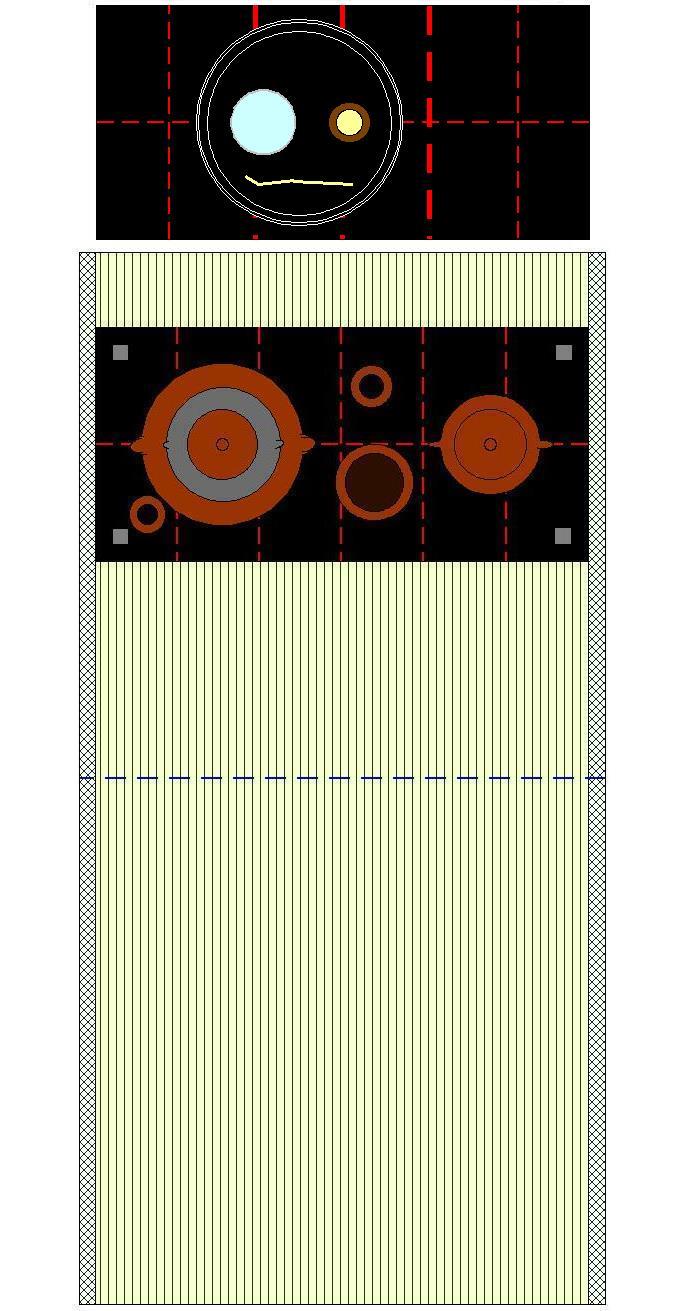
The sketch in Shibayama Fugen’s commentary shows the naka maru-bon arranged on the ten-ita of the daisu. The chaire is associated with the central kane*, and the chawan is associated with “the first kane on the right seat†.”
When the host enters the room for the service of tea, if he brings a chawan-dai of some sort out from the katte‡, it would be placed on the left side of the utensil mat, near his knee. Then the chawan would be lifted off the tray and placed on the ten-ita of the daisu, about 2-sun to the left of the tray, and the chashaku is picked up and rested on the chawan. The chaire is moved to the center of the tray.
Then the chawan-dai is moved in front of the furo, and the chawan lowered onto the dai. Next, the tray, with the chaire resting on it, is lowered to the mat and placed in front of the mizusashi.
Finally, the chawan, resting on the dai, is moved to the left of the tray.

During the temae, the naka maru-bon is placed so that it touches the front edge of the daisu and (in the original orientation**) with its right side resting on top of the heri. The chaire is placed behind the midline of the tray††, while it is centered between the left and right sides of the tray.
This way to orient the chaire during the temae is also used with the other larger trays (including the “ordinary” nagabon‡‡).
On account of its size, the chasen would be stood on the tray when placed on the right side of the mat (in line with the center of the chawan); and the chashaku would be rested on a diagonal in front of the chaire, as shown. The chakin would be placed either on the ji-ita, in front of the furo, or on the lid of the kama (when it was open and resting on the futaoki).
Also, a chawan-dai (or temmoku-dai) would be brought out as a base for the chawan***. ___________ *Because this is not a great meibutsu chaire, it is arranged (on the ten-ita) with its foot immediately to the right of the central kane, meaning that it “overlaps” that kane by one-third.
†Chawan wo migi-za dai-ichi no kane ni okeru-mono nari [茶碗ヲ右座第一ノ矩ニ置ケルモノナリ].
As was explained before, in the Nampō Roku, the daisu, and the objects arranged on it, are considered to be facing toward the host. Thus, the “right seat” (migi-za [右座]) is the half of the daisu on our left.
Furthermore, the kane are counted from the middle. Thus, the “first kane” refers to the kane on either side of the central kane.
‡Assuming that he is following the same sort of precedents as prevailed in the case of the two arrangements that precede this one in Book Five of the Nampō Roku.
It is also possible that the host could do without the dai, in which case he would come in empty handed. Putting aside the references to the dai, the rest of the procedure would remain as described.
**Which was based on the idea of the shiki-shi [敷き紙].
Later, after Rikyū removed this reference to the shiki-shi, the tray was moved 5-bu (1-me) toward the center of the mat -- so that its right edge would touch the right heri without rising up onto it.
††In other words, it is still 3-sun 5-bu from the front edge of the daisu. This is the important measurement.
‡‡Tsune-no-nagabon [常ノ長盆]. The sides of this tray were finished with guri-guri lacquer (the tray ws painted with alternating layers of red and black lacquer, with black as the final coat, and then a repeating geometric design resembling an “Ѡ” was carved with a burin). The face (which lacked any carving) measured 1-shaku 3-sun by 8-sun 2-bu ; and the tray measured 1-shaku 5-sun 2-bu by 1-shaku 4-bu.
Haneda Gorō’s reproduction was painted with kagami-nuri, without any carving.
***As mentioned previously, these temae were used when serving tea to a nobleman. Therefore, the chawan -- whether a temmoku or some other sort of bowl (of a similar size) -- would be placed on a dai.
2 notes
·
View notes
Text
Nampō Roku, Book 5: an Introduction to the Fifth Book of the Nampō Roku, Daisu [臺子] ; and an Apologia that Explains the Way this Book Will Be Interpreted.

I. The historical -- and modern-day -- importance of the daisu.
At the beginning of the densho known as the Tenshō ku-nen ki-mei densho [天正九年記銘傳書]¹, Rikyū wrote: “with respect to chanoyu, the daisu is its root. When the daisu is abbreviated, [it becomes] chanoyu with the furo. When the furo is abbreviated, it becomes [chanoyu with] the irori. If the ‘shin’ [眞] of the daisu is not understood, then [the correct way to use] the furo is difficult to do successfully; [and] if one can not discern [what is meant by] the ‘gyō’ [行] of the furo, then the ‘sō’ [草] of the irori is also impossible to bring forth, so you must understand. It should be like the flower, which blooms [upward] from its root².”

[Rikyū’s original manuscript of the passage that has been quoted in the text. ]
Rikyū, here, declares the essential nature of the daisu, not only from a historical perspective, but also with respect to its impact on the everyday temae. The “daisu” to which he refers means the collection of classical temae handed down from ancient times, that have been preserved in this book³, and to the idea of kane-wari [カネワリ]⁴ that was derived from them.
II. The format of Book Five.
The contents of Book Five of the Nampō Roku largely consist of a series of sketches (each drawn on a separate sheet of paper), that apparently were given to Nambō Sōkei by Jōō⁵; with kaki-ire added to many of them at a later date⁶. Each entry (several of which extend across two, or even three, double pages) closes with a title, followed by Rikyū’s “Sōeki kaō” [花押]⁷, and then Nambō Sōkei’s name (“Nambō” seems to have been Rikyū’s nickname for Sōkei)⁸, as seen in the example shown below.
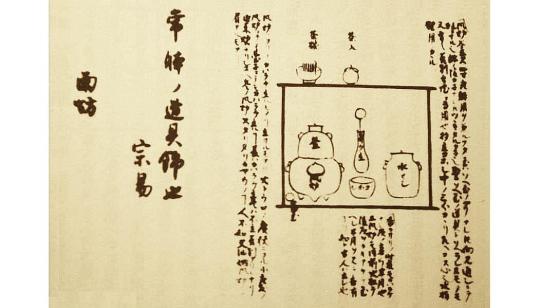
[The double page showing the first sketch, from the Enkaku-ji manuscript. The components are explained in the text.]
Many of the sketches are marked to indicate the relationship of the various objects to their kane, as may be seen in the example below. A single line means that the utensil in question is associated with a kane, but is not centered on it; three lines, however, indicate a mine-sure [峰摺り], where the object is carefully centered on the kane⁹.
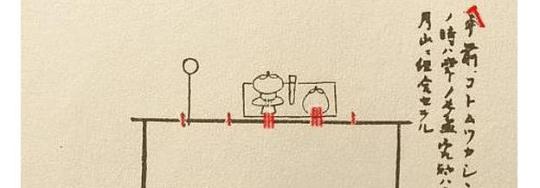
[A detail of the san-shu gokushin (三種極眞) arrangement, showing the way that the mine-suri (峰摺り) are indicated.]
In this translation, all of the pages related to a single topic will be covered together in the same post. As will several other arrangements that have been lost from the Enkaku-ji manuscript, in their appropriate places (relative to Jitsuzan’s original version of the material).
The final 15 text entries will be segregated into several groups, based on their content.
III. An apologia regarding the shiki-shi [敷き紙], and the interpretation of kane-wari that will be used in this translation.
As I have mentioned before, Book Five really lays the foundation for kane-wari. Yet, if someone is ignorant of the shiki-shi, then the conclusions that they will draw are, put simply, wrong.





[The shiki-shi (敷き紙): one side is gilded, while the other is silvered. The fully opened shiki-shi determined the temae-za in front of the daisu (top), while the half-opened shiki-shi determined the temae-za in the small room (middle). The fully folded shiki-shi (bottom) measures 6-sun by 5-sun, which is a convenient size to be inserted into the futokoro.]
A textually unidentified sketch of the shiki-shi is included in Book Five, as entry 48. This is followed by two sketches showing the shelves of the daisu divided by the kane -- first (entry 49) the small daisu, which is divided by seven kane, and then the large daisu (entry 50), divided by the eleven kane (five yang-kane, interspersed with six yin-kane). While the sketches in entries 49 and 50 are clearly proportional to the dimensions of the ten- and ji-ita of the daisu in question¹⁰, that of entry 48 (which I suggest is the shiki-shi) is obviously not. Below is Jitsuzan’s sketch, on the left, and the modified sketch from Shibayama Fugen’s commentary (Fugen deliberately stretched this sketch horizontally, so that it conforms with the dimensions of the daisu). The five marks were added to the upper edge later -- whether by Jitsuzan, or by one of the other scholars affiliated with the Enkaku-ji, once it was decided that (contrary to the visual evidence¹¹) this was a sketch of the subdivision of the ten- or ji-ita of the daisu.

[On the left is the sketch from Tachibana Jitsuzan’s manuscript, while on the right is Shibayama Fugen’s version -- which he modified to conform with the dimensions of the ten- and ji-ita of the shin-daisu.]
Here the shiki-shi is shown arranged in front of the large shin-daisu, on a kyōma tatami.

[This sketch carefully replicates the shiki-shi arranged in front of the shin-daisu on a kyōma tatami.]
The kyōma tatami (which measures 6-shaku 3-sun by 3-shaku 1-sun 5-bu) has a fraction more than 61-me between the heri (the width of the space between the heri is determined by the width of the shin-daisu, which is 2-shaku 9-sun 5-bu; the heri are always 1-sun wide), with the heri aligned with the edge of the first me on the side of the mat towards the guests’ seats -- in this case, on the right. Note that on that side the shiki-shi exactly matches the edge of the me, and that there are 9-me between the shiki-shi and the heri. Though the spacing is the same on the left, because the me do not exactly match the width of the mat, the left edge of the shiki-shi does not match the edge of the me on that side¹².
Because of the folds, the temae-za (which is determined by the shiki-shi) extends onto the two heri, as shown below, so that the uncovered spaces on the left and the right are equal to the panels of the shiki-shi itself.

[The temae-za is outlined with the dashed red line; the middle of the mat is shown by the dashed blue line.)
Meanwhile, the space between the front of the daisu and the middle of the mat was determined by the largest of the six meibutsu trays (which measures 1-shaku 3-sun in diameter). The space on the far side of the daisu is simply what remains, without any special reason.
Further discussion of these points will be put off until the commentary appended to the entries with which it is relevant (since Tumblr’s new format appears to be limiting the length of posts once again).
This introduction will be followed by an Appendix, wherein I will review Rikyū‘s own teachings on the use and arrangement of the daisu, from his densho.
_________________________
¹The person to whom this document was presented is unknown. It is believed that this version of the text was retrieved from Rikyū's personal archives, since similar densho (addressed to specific individuals) are known. It would appear that writing in Japanese was difficult for him, on account of his language dyslexia. Thus he wrote out a master copy of his densho, which he kept among his papers, making copies of them for presentation* (with situation-specific modifications) whenever these were needed.
Tenshō ku-nen [天正九年] was 1581. Consequently this densho was written at a time when Rikyū was moving in the higher circles of society, but before he was inducted into an official position within the government. __________ *One such surviving example of this particular densho was addressed to Nomura Sōkaku [野村宗覺; his dates of birth and death are not known], a machi-shū chajin from Sakai. His version of this densho was also dated 1581 in Rikyū's dedication.
²Hitotsu, chanoyu ha daisu nemoto nari, daisu wo ryakushite furo no chanoyu, furo wo ryakushite irori ni narashi, shin no daisu wo fu-chi ha gyō no furo mo nari-gataki nari, gyō no furo wo mo wakimaezu-shite ha, sō no irori mo nasu-bekarazu to shiru-beshi, nemoto ni hana no zakitaru gotoku nari ha shiru-beshi [一、茶湯ハ臺須根本也、臺子ヲ略しテ風呂ノ茶湯、風炉ヲ略しテイロリニナラシ、眞ノ臺子ヲ不知ハ行のふろも成可たき也、行のふろをもワキマヘスしテハ、草のいろ里も成ヘ可ら須と知るへし、根本ニ花の咲たるコとく成ハ知るへし].
The orthography of this passage is discussed in the post entitled Rikyū Densho — the Private Writings of Sen no Rikyū: IIIa. The Tenshō Ku-nen Densho (A. The Daisu is the Root of Chanoyu).
The URl for that post is:https://chanoyu-to-wa.tumblr.com/post/83456005982/riky%C5%AB-densho-the-private-writings-of-sen-no
³Though several of the arrangements illustrated in Book Five of the Nampō Roku have been appropriated by the modern schools, it must be understood that the original temae were very different from anything that the modern schools have conceived, or teach.
The classical temae was always essentially the same*. The way to fold the fukusa† -- which is one of the defining elements of the secret aspects of the modern “higher temae” (including those that employ the daisu), did not exist in ancient times: Rikyū was the first to fold the fukusa in the room, at the very beginning of the temae and before the eyes of the guests, and he did this in the most perfunctory manner possible. Prior to that, the fukusa was folded in the katte, at a time that the host deemed appropriate, and kept in the futokoro of his kimono. The fukusa was taken out for use, and then returned to the futokoro. It was never refolded, and discarded into the left sleeve at the end of the temae. __________ *There were two possible formats, depending on whether the host removed the shifuku from the chaire first, or whether he did this while the chawan was being warmed with hot water prior to the chasen-tōshi.
The decision turned on the importance (i.e., social rank) of the shōkyaku.
†The so-called shi-hō-sabaki / yo-hō-sabaki [四方捌き] ultimately derived from Sōtan's peculiar way of doing things, though in this case it was an attempt to discourage the government's interest by feigning incompetence: traditionally the fukusa was held with the wa-sa [輪差], the folded edge, on the right, before folding it diagonally into a triangle; Sōtan pretended that he could not even find the wa-sa, fumbling with the fukusa before “folding” it. His sons later “refined” this action into the shi-hō-sabaki. Consequently, any temae that features the shi-hō-sabaki -- or, indeed, includes the folding of the fukusa in the tearoom, in front of the guests -- could not be earlier than the chajin who initiated these practices.
⁴Kane-wari [カネワリ = 矩割り or 曲尺割り] is the system of subdividing the spaces used for chanoyu with five “lines.” While the original purpose was apparently intended as an aid to reproducing the arrangements elsewhere, this idea was also associated with balancing the “energy” of the system, so as to enhance the beneficial properties of the tea* that was prepared during the temae. __________ *According to the usual interpretation of the passage in the Medicine King Chapterᵃ of the Lotus Sūtra on which the idea of chanoyu was originally based, drinking tea cures the person who drinks it from the disease of saṃsāraᵇ.
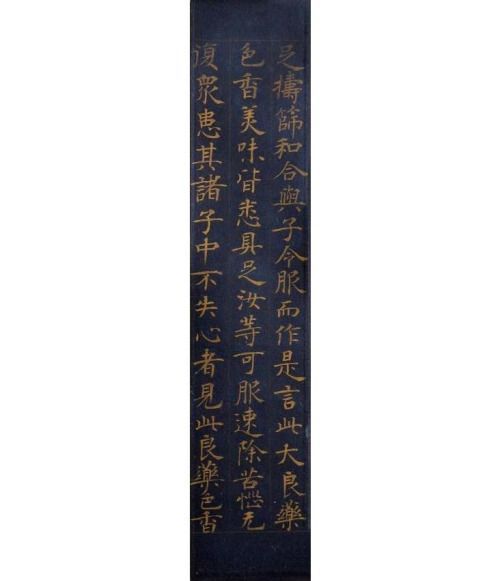
As chanoyu came to be understood as an exercise in motion-meditationᶜ, furthermore, the impact of the environment will either enhance or impede the attainment and prolongation of samadhi, hence the energy generated by the arrangement of objects was considered to be of critical importance. __________ ᵃThis is usually chapter 22 or 23 in this sūtra, depending on how it has been subdivided.
ᵇThe relevant passage was translated and discussed in the post entitled Some Random Thoughts on the Practice of Chanoyu (3): the Origin of the Use of Tea as a Pious Device is Said to be Based on the Saddharmapuṇḍarīka Sūtra [the Lotus Sūtra].
The URL for that post is:
http://chanoyu-to-wa.tumblr.com/post/126804725203/some-random-thoughts-on-the-practice-of-chanoyu
ᶜThere was probably a certain degree of temporal separation between the association of tea with the “medicine with a beautiful color, wonderful aroma, and delicious flavor” of the Lotus Sūtra (this seems to have been the farthest the evolution progressed in China), and the recognition that the ritualistic method of preparation could, itself, be utilized as a pious device that would aid in the cultivation of samadhi (which appears to have arisen in Korea, possibly at the Ssang-gye-sa [雙溪寺] or one of the other temples standing near the site of the first tea fields, at Hadong).
⁵The sketches, on kiri-kami [切紙] (individual pieces of paper, rather than drawn on a long scroll of paper, or in a notebook), are executed in the same style, and observe the same conventions, as those found at the end of Book Three and Book Four.
The fact that Rikyū verified the contents of each sketch with his signature clearly indicates that (contrary to the assertion of certain scholars) the sketches did not originate with him.
Nor is there any reason to suppose that Nambō Sōkei was responsible for them, since Sōkei was a collector of antique teachings, rather than an innovator or creator of arrangements.
⁶The fact that the sketches document usages that were employed up to a century before Jōō‘s birth* shows that these arrangements could not have been created by Jōō. Rather, it would appear that he collected them from various sources, and passed the collection on to Nambō Sōkei, perhaps during his final illness.
Furthermore, since a number of the kaki-ire [書入]† were written over the original sketches indicates that they must post-date both the original sketches, and Jitsuzan’s copies (since if this material had been present when he produced his copies, he would surely have allowed sufficient space for the comments).


This example shows the extent to which the kaki-ire occasionally obscure the sketches themselves, as well as being added in an odd way (the kaki-ire above the chaire and dai-temmoku was written with the paper turned sideways).
The above example is also important for another reason: this sketch (like several others) is not found in the Enkaku-ji manuscript of the Nampō Roku. Kanshū o-shō sama explained to me that, unfortunately, it seems certain people tore out pages as “souvenirs” in the past‡. The absence of these drawings in the Tankōsha edition of the Nampō Roku indicates that this was done prior to the 1950s, when the Sadō Ko-ten Zen-shu [茶道古典全集] was originally published. (It is interesting that Kanshū left me alone with the books on several occasions.) ___________ *The earliest datable of the sketches is the one illustrating the setup for the san-shu gokushin [三種極眞] temae, which (according to Book Six) was first performed publicly (in Japan) on the 18th day of the Sixth Month of Ōei 10 [應永 十年] (July 7, 1403). The performance shocked and awed the onlookers, who were members of the shōgunal court (as well as anyone who was able to peep in from outside), who had never seen anything of the like (which indicates that chanoyu was completely imported, rather than a locally evolved practice). What is also interesting is that the san-shu gokushin was a modified version of the gokushin temae (devised to allow for the use of a special celadon mizusashi), suggesting that the original of the original form was created much earlier (in Korea -- the appearance of chanoyu in Japan occurred shortly after the assassination of the last Koryeo king earlier the same year, following his forced abdication during the previous year).
†The language used in the kaki-ire in Book Five is identical to that used in the kaki-ire that were added to the sketches in Book Four -- which, Tanaka Senshō noted, his sources (among the group of scholars who gathered in the Enkaku-ji to study this document) revealed were known to have been added to the sketches during the second half of the Edo period, after Jitsuzan presented his manuscript to the Enkaku-ji. As a result, to then argue that the kaki-ire found in Book Five were approved by Rikyū is nonsense.
This is an important point, because many of the assertions bandied about regarding the teachings of the Nampō Roku -- and what they supposedly “reveal” about Rikyū’s “secret teachings” -- derive from these kaki-ire. (This is significant because some of these assertions directly contradict things found in Rikyū‘s own densho -- and this constitutes the “proof“ that the densho are spurious! In fact, what some of these kaki-ire actually reveal is that the group of scholars did not have a clue, and simply put their own speculations into Rikyū’s mouth.)
‡There was a certain vogue for mounting such fragments as kakemono during the nineteenth and twentieth centuries.
One of the maru-bon midare-kazari [丸盆亂飾] sketches still survives as a torn page. Alas, the remaining fragment is too small to enable us to reconstruct the missing content.
⁷A kaō [花押] is a stylized signature, added to a document as a seal. In this case, Rikyū’s kao certifies that he had reviewed the document, and supposedly verified its contents. A copy of Rikyū’s actual kaō is shown below.

Naturally, since the Nampō Roku consists of Tachibana Jitsuzan’s copies of the original documents, he chose to simply write “Sōeki” [宗易]*, rather than forge the actual kaō.
The appearance of this kaō -- and the reason for its appearance -- is problematic, because it appears to sanction the kaki-ire (which, of course, would have been impossible, since these were all added during the Edo period). This is one reason for much of the confusion that surrounds the contents of this book. ___________ *Sōeki [宗易] was the name that Rikyū was given when he “graduated” from his period of training (something in which most of the male population of Sakai participated during that period). He used this as his professional name thereafter (another common convention of the period).
⁸Nambō was apparently intended to indicate the recipient, in the same way that a letter concluded with the name of the person to whom it was addressed.
It is impossible to know when Rikyū reviewed documents (since the entries are undated). However, the introduction to the Nambō-ate no densho [南坊宛の傳書] mentions a previous correspondence between Rikyū and Sōkei, and it is entirely possible that Sōkei had submitted these sketches to Rikyū for his comments, and Rikyū’s reply sufficiently impressed Sōkei that he submitted additional questions that were answered in the above-mentioned densho.
Subsequent to the Nambō-ate no densho, Rikyū addressed two further documents of the sort to Sōkei. Though undated, the first of those (which may be referred to as the Tsuri-dana no densho [釣棚の傳書] -- both are usually included in modern versions of the Nambō-ate no densho without comment) must have been presented in 1582 or 1583 (since the tsuri-dana was created in the summer of 1582), while the second (Shin no dai temmoku, onaji daisu no koto no densho [眞の臺天目、同臺子の事の傳書]) was written around 1586, perhaps just prior to Hideyoshi’s prohibition on the unauthorized dissemination of information related to the gokushin temae. The text of the latter will be appended to this post, since it will give the reader a better idea of Rikyū’s teachings on the subject of the gokushin daisu temae.
⁹The different kinds of associations with the kane were discussed in an appendix to the post entitled Nampō Roku, Book 3 (18.5): Arrangements for a Meibutsu Futaoki, and for a Karamono Chaire.
Put simply, ordinary objects are associated with their kane by placing them so that their foot is immediately to one side of the kane. This is shown, in the Nampō Roku, by the kane located to one side of the object.

Important objects (usually meibutsu pieces) are aligned so that their center is located within the 3-bu wide space of one of the inner three kane (this 3-bu wide space is a consequence of the shiki-shi). This is shown in the Nampō Roku by the object being centered on a single line.
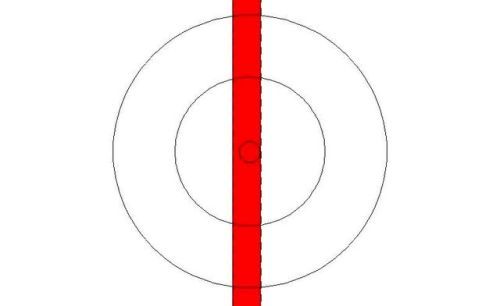
Mine-suri [峰摺り] objects, pieces of the highest rank (usually when being used to serve tea to an extremely important -- high ranking -- shōkyaku) are exactly centered on the 3-bu wide space. This is indicated by the object resting on three lines (the outer two indicate the edges of the 3-bu wide space, while the inner line shows the object aligned with the center of that space).

For additional information, please consult the post mentioned above. The URL is:
https://chanoyu-to-wa.tumblr.com/post/187172815712/namp%C5%8D-roku-book-3-185-arrangements-for-a
¹⁰In the Enkaku-ji version of the Nampō Roku, the quality of Jitsuzan's drafsmanship cannot be surpassed. Everything is drawn so carefully, that the intentions of each arrangement can be understood at a glance. Unfortunately, this is not true with any of the published editions, which use either re-drawn sketches, or sketches that were not reproduced carefully (so that they are usually more confusing than helpful).
The dimensions of the sketch of the shiki-shi in the Enkaku-ji manuscript exactly matches the actual shiki-shi; while the other two exactly match the two daisu. Consequently, it is impossible to conclude that the first was intended to show a daisu -- though Jitsuzan himself may not have been aware of this (he seems to have made careful copies of everything -- even when he did not understand what he was drawing).
¹¹This argument is really indefensible: in addition to the anomalous dimensions of the sketch, nowhere else in the Nampō Roku is this division of the daisu into eight sectors mentioned, and it adds another (and irrelevant) note of confusion into the subject of kane-wari.
Precisely why the scholars in question could not trust their eyes is at least partly a consequence of a sort of mentality that developed during the Edo period, as a consequence of “artistic purity” being held out as a goal. Because the shiki-shi was used by practitioners of incense, it could not possibly have any connection with chanoyu. Even though there is no other object that conforms to the sketches the way the shiki-shi does.
We must remember that, even in Rikyū's period (as well as in the decades before), none of these arts were truly distinct, the way they became in the Edo period. Rikyū practiced chanoyu, certainly, but he was also a skilled floral artist. And also well versed in incense. Jōō was as much a classically trained poet as he was a devotee of incense, and, only later, one of chanoyu. This sort of mindset was hardly unique to Japan. Indeed, it appears that this was also exactly the case on the continent, and describes the environment in which all of these arts evolved -- together.
How I came to identify the shiki-shi from the sketch is the result of circumstances to which I was exposed long before I ever went to Japan. A friend of mine had spent a year in Japan with her husband and children; and because her husband was a famous researcher, when they returned to the USA they were showered with all sorts of presents. One of the things that she was gifted was an antique shiki-shi (one that could never be used for chanoyu, since it had delicate watercolor paintings on both sides that would have dissolved at the slightest trace of water -- indeed, there is no evidence that the shiki-shi was ever used for chanoyu in Japan). One day she put her shiki-shi in front of the naga-ita on which her tea utensils were arranged, as a decoration (her level of chanoyu training was sub-basic -- at that point she could not even do the ryaku-bon temae -- and she had had only one experience of participating in an incense gathering; still she had seen the shiki-shi spread out in front of the kō-dana [香棚], and decided to do that in her own home.) This, and the unique shape of the object, stuck in the back of my mind somewhere; and when I first saw the sketch that is entry 48 in the Nampō Roku, the shiki-shi immediately came to mind (this was before I was able to read the text at all).
Serendipitous, perhaps. But I have found no other way to explain kane-wari -- especially the difference between this apparent system, and what Rikyū taught: while the shiki-shi seems to form the basis of the daisu arrangements (when objects are placed on the large trays, the trays always align the objects with the position they would have occupied on the shiki-shi), Rikyū's system reduced the three inner kane to simple lines, thus pulling the temae-za inward from the heri, so that it ends at the heri, rather than rising onto them on either side. And, as if to prove this true, when the large trays are moved inward, the objects placed on them then correspond with Rikyū's system.
More will be said about this later, in the commentary appended to the individual arrangements.
¹²To create the illustration, the dimensions of each of the elements were fixed separately, and then they were simply super-imposed on top of each other. Nothing was adjusted to fit afterward. In the absence of an actual kyōma tatami, this was the best evidence that I could give for the credibility of the assertion that kane-wari is based on the shiki-shi.
In a setting where the guests are seated on the host’s left, the orientation of the utensil mat will be reversed -- as shown below.
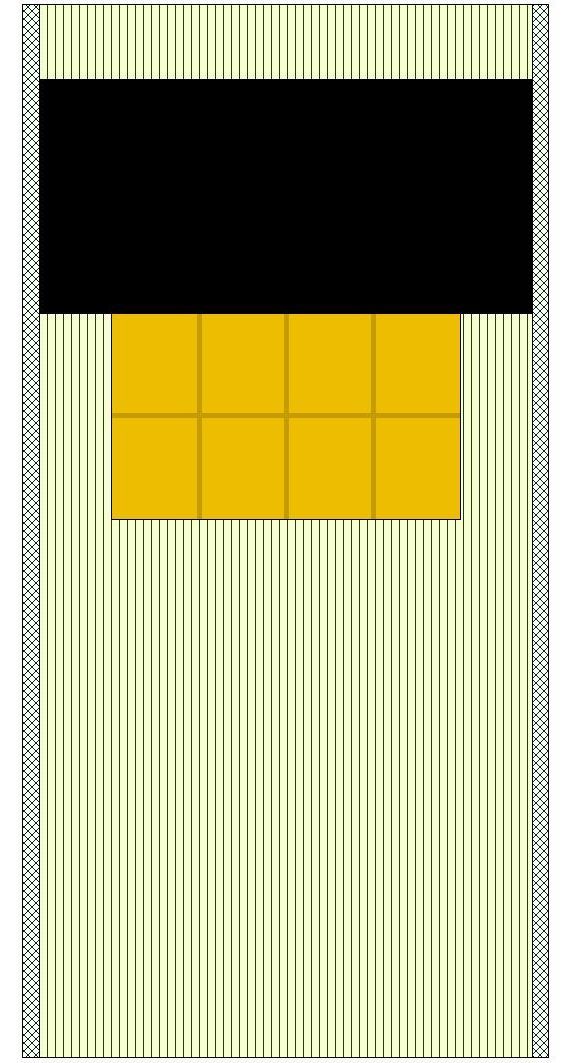
To understand this, the reader should look carefully at the me.
2 notes
·
View notes
Text
Nampō Roku, Book 5 (10): the Round Tray, with a Display of the Chaire, Dai, [and] Chawan¹.

10) Maru-bon ・ chaire ・ dai ・ chawan kazari [丸盆・茶入・臺・茶碗飾]².
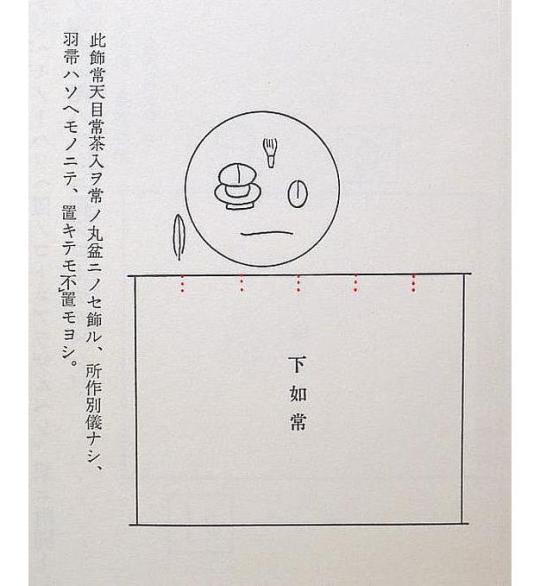
[The writing reads: (from right to left) shita jo-jō (下如常)³; kono kazari tsune (no) temmoku・tsune (no) chaire wo tsune no maru-bon ni nose-kazaru (此飾常天目・常茶入常ノ丸盆ニノセ飾ル)⁴; tokoro-saku betsu-gi nashi (所作別儀ナシ)⁵; habōki ha soe-mono ni te, okite mo okezu mo yoshi (羽帚ハソヘモノニテ、置キテモ不置モヨシ)⁶.]
_________________________
¹The name given for this arrangement in Shibayama Fugen’s commentary is the same as that of the previous entry -- apparently mirroring that in the original manuscript from which it was taken*. The relationship between entries 9 and 10 actually parallels that of 7 and 8; and, like part 8, the present arrangement is a form of midare-kazari [乱飾]†. The tray is the naka maru-bon [中丸盆].
In certain modern schools, a temae based on this model is known as gyō-no-gyō daisu [行之行臺子] -- though the details of the modern temae are quite different‡. ___________ *Shibayama’s teihon [底本] was one of the four authorized copies of the Enkaku-ji manuscript that were made while Tachibana Jitsuzan was still alive. The minimal number of rather succinct kaki-ire (and the lack of the extreme degrees of speculation that are found in many of the kaki-ire that have been added to the Enkaku-ji manuscript in the years since) allows us to imagine the state of Nampō Roku scholarship at that time. Here the focus seems to be on recognizing and preserving the historical aspect of these arrangements -- rather than at creating a new tradition to compete with the Sen family and the other schools.
†Midare-kazari [乱飾] literally means “disordered arrangement,” and refers to arrangements where the chasen is displayed apart from the chawan.
‡The modern approach is usually to leave the tray on the ten-ita of the daisu throughout the service of tea, with the chakin being placed on the tray during the temae (rather than on the ji-ita, or on the lid of the mizusashi). In the original version of this temae, however, the tray was lowered to the mat, and employed as a sort of chaire-bon, in imitation of the gokushin-temae.
Placing the chasen on the tray may strike us as counterintuitive, in its original context. Originally, when the guests were seated on the host’s left (and the katte located on his right), while the arrangement of the utensils on the mat in front of the daisu was essentially the same as now (the only real difference is that the koboshi was placed on the host’s right side, rather than on his left), the chasen was placed on the tray next to the chaire after it had been used to prepare the koicha. This likely strikes us as improper, since the chasen will be stained with the tea at this time, while we tend to regard the tray as a sort of ritually pure area. However, the real purpose of the tray was not to elevate the status of the utensils that are placed on it (at least, during the temae), but to protect the environment from being contaminated -- with matcha (this is why the chaire was originally handled on its tray: in the early days, at least, once a chaire was paired with a tray, the chaire was always handled on the tray, even when it was being filled with tea, or cleaned up after the temae), and, in this case, tea that might drip from the chasen. The tray is easy to clean, while removing matcha -- or, even worse, globs of koicha -- from the surface of the mat is extremely difficult, if not impossible.
Reversing the orientation of the room, however, might be said to make things seem “better,” at least to us in the present day -- even though doing so obscures the original purpose of the tray (and, indeed, the original logic of the way that the utensils are arranged on the daisu). In this setting, the chasen is stood on the tray (which is now found on the side of the mat closest to the guests’ seats) when it is clean, and then moved to the other side of the mat (adjacent to the wall), after it has been used.
²Maru-bon ・ chaire ・ dai ・ chawan kazari [丸盆・茶入・臺・茶碗飾].
In this arrangement, these refer to:
- maru-bon [丸盆]: the “ordinary” maru-bon -- i.e., the naka maru-bon -- which measured 1-shaku 2-sun 3-bu in diameter, and has been described several times before in this blog;
- chaire [茶入]: an “ordinary” large katatsuki (measuring 2-sun 5-bu in diameter);
- dai [臺]: either an “ordinary” temmoku-dai [天目臺]*, or a Korean-style chawan-dai [茶碗臺], such as has been described previously;
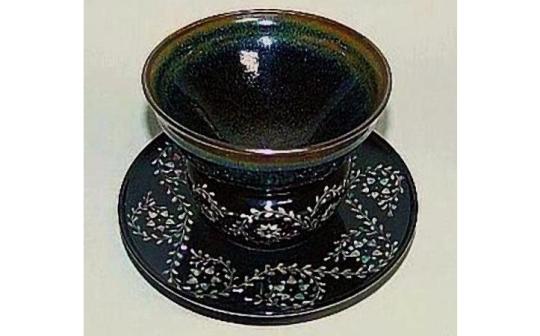
- chawan [茶碗]: either an “ordinary” Kenzan-temmoku [建盞天目] (as shown above), or another respectable† chawan, suitable for this usage‡. __________ *Possibly Japanese-made. The imported shin-nuri dai, which were usually named, were handled in a special manner.
Korean raden-dai [螺鈿臺] (mother-of-pearl inlay, such as the one shown in the photo), and Chinese tsui-shu-dai [堆朱臺] (carved cinnabar-lacquer -- though the Chinese temmoku-dai of this sort were often carved first and then lacquered) could also be used for this kind of temae.
†In this period, the chawan was almost always imported from the continent, and it is such a piece that is intended here. These bowls were usually around 4-sun in diameter.
‡Originally, the service of tea to a nobleman. Of course, the machi-shu chajin occasionally performed this kind of temae when serving tea to their social equals when the purpose was showing off their utensils. Nevertheless, according to Rikyū, serving a noble guest was the principal reason that the host would choose to include this kind of temae in his gathering.
³Shita jo-jō [下如常].
The objects arranged on the ji-ita are as usual.
Since the shin-daisu was only used with the furo, there is no question about any seasonal modifications.
⁴Kono kazari tsune [no] temmoku・tsune [no] chaire wo tsune no maru-bon ni nose-kazaru [此飾常天目・常茶入常ノ丸盆ニノセ飾ル].
“In this arrangement, an ordinary temmoku [and] an ordinary chaire, are displayed resting on an ordinary maru-bon.”
Ordinary temmoku, and ordinary chaire, refer to non-meibutsu pieces.
All of the naka maru-bon (including the one that had been owned by Ashikaga Yoshimasa) were copies, since the original had been destroyed when Yoshimasa's storehouse was burned down during the Ōnin wars. By Jōō's day recently made copies were easily obtained from the lacquer merchants of the day, since this was the tray traditionally preferred by the machi-shū chajin above all of the others (which is why there are so many maru-bon temae recorded here).
⁵Shosa betsu-gi nashi [所作別儀ナシ].
“[With respect to the host's] actions, there are no special considerations.”
In other words, since this arrangement uses ordinary utensils, there are no special modifications necessary, either in the host's preparations, or in his temae. For much of the time between the middle of the fifteenth century and the middle of the sixteenth century, this was the usual way that tea was served in the 4.5-mat room.
⁶Habōki ha soe-mono ni te, okite mo okezu mo yoshi [羽帚ハソヘモノニテ、置キテモ不置モヨシ].
“With respect to the inclusion of the habōki as an accessory, placing it [on the daisu], or [opting] not to place it -- either approach is acceptable.”
Soe-mono [副え物] means an accessory, something placed out to accompany the necessary elements in the arrangement. Shibayama Fugen discusses the significance of this expression, and its potential relationship to the notion of soe-oki [副え置], in his notes*.
The habōki was used to clean the utensil mat at the end of the temae, but it could just as easily be brought out at that time (for example, when the host returned from taking some other utensil back to the katte), as it could be displayed on the daisu throughout the temae†.
In general, including the habōki in the initial arrangement seems to have been done when the kane-wari required one more (yang) object. ___________ *I have translated his remarks in full at the bottom of the Analysis section, below. I have also provided a transcript of his words in Japanese, for those interested in dissecting the specifics of his argument.
†In the early days, it seems that the habōki was more often displayed than it was in the period documented by Book Five of the Nampō Roku. However, at that time most tearooms featured a go-sun-ita inserted between the utensil mat and the wall to its side, and the habōki was most usually displayed there. Only a habōki of exceptional quality was placed on the daisu (and it was usually relocated to the go-sun-ita at the beginning of the temae).
——————————————–———-—————————————————
◎ Analysis of the Arrangement.
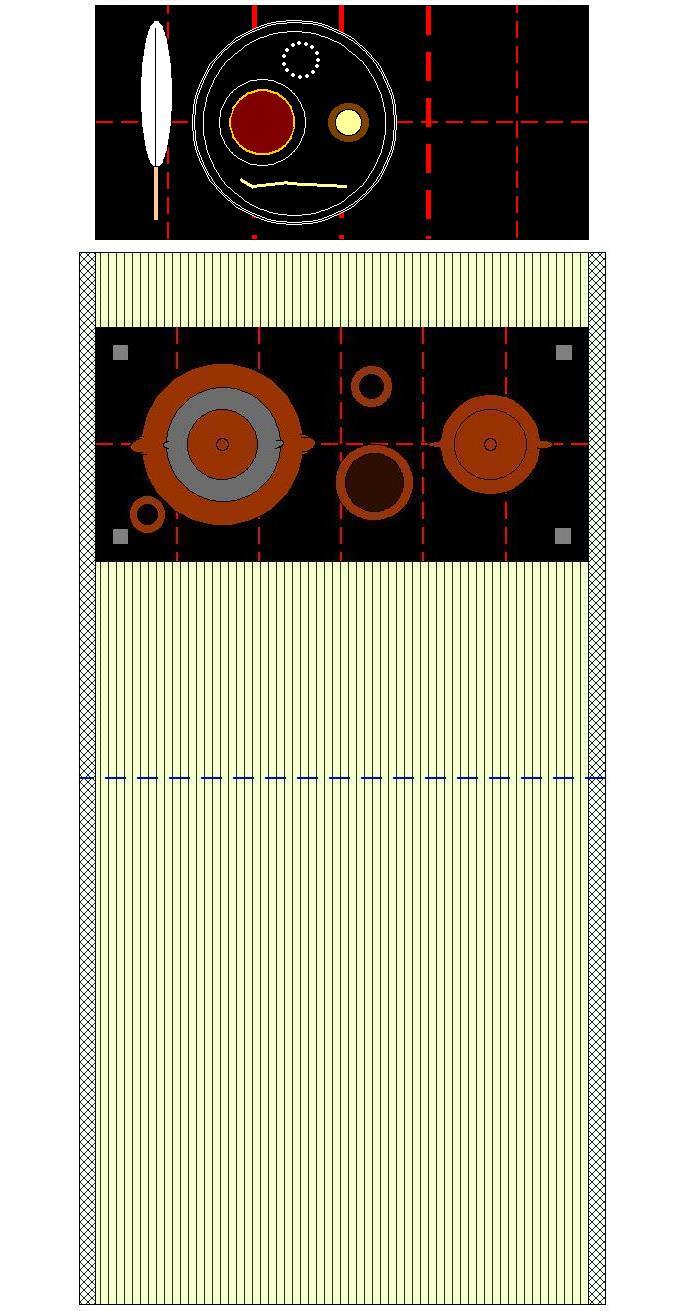
Here, the version of the sketch that is found in Shibayama Fugen’s commentary has been rendered accurately. Due to the proximity of the naka maru-bon, the habōki only contacts its kane.

And this is the version of the sketch without the habōki.

In his comments, however, Shibayama Fugen questions whether the habōki (when the host decides to include it in the arrangement) actually comes into contact with the left-most kane. He wrote*: “’with respect to the habōki being an accessory (soe-mono [副え物]),’ what does this actually mean? Placing it beside the maru-bon, as a case of soe-oki [副え置], seems to be impracticable†. But if that is the case, then the inclusion of this accessory should not be considered to be a soe-oki; but, rather, it should be thought of as merely accompanying [the other objects that are arranged on the ten-ita]. Consequently, this habōki should be [completely] disassociated from the [yang] kane‡.”
That said, if we allow Shibayama’s argument, then (irrespective of whether the habōki is technically considered to be associated with the first yin-kane, or not) it will have no impact on the kane-wari (which was the usual reason given for why the habōki might be displayed on the daisu in this way). Thus the reason for choosing to arrange it with the maru-bon resolves to the question of whether the habōki is of good enough quality to merit its being displayed -- yet this idea seems to go against the argument that underpins these arrangements, which appears to be that nothing should be displayed without there being a good reason for the host to do so (and showing off his treasures is not one of them): objects are arranged on the daisu either because they are needed for the temae, or because they are necessary in order to achieve the proper kane-wari count. Simply showing off the host’s valuable possessions was originally not a valid reason -- though it seems to have become one (and, indeed, the motivating factor) during the Edo period and thereafter. __________ *「 Habōki ha soe-mono 」to aru ha ika-naru koto naru ya, maru-bon ni soe-oki to naru-koto ha aranu no koto nari. Shikara ba kono soe-mono to ha soe-oki no koto ni arazaru-beshi. Tan ni fuzui to no kokoro naru-beshi. Shikara ba kono habōki ha kane hazushi ni oku-koto naru-beshi [「 羽帚ハソヘモノ」トアルハ如何ナルコトナルヤ、丸盆ニソヘ置トナルコトハ不可能ノコトナリ。然ラバ此ノソヘモノトハソヘ置ノコトニアラザルベシ。單ニ附随トノ意ナルベシ。然ラバ此ノ羽帚ハ矩ハヅシニ置クコトナルベシ。].
†Because there is not enough space for the habōki to fully “embrace” the kane (by overlapping it by at least one-third).
As shown in the first sketch, if we are to associate the habōki with the first (yang) kane at all, it would be to overlap it by just a little. And while this is actually what is shown in the original sketch, Shibayama is rejecting this option (by arguing that if the habōki cannot overlap the kane by at least one-third, then the relationship should be rejected).
‡And so associated with the end-most yin-kane?
Shibayama Fugen is not entirely clear about what relationship the habōki might have with the first yin-kane (though centering the habōki on that kane is the way I have depicted the state of things in the third sketch). His comments suggest that, in his opinion, it should simply be placed to the left of the yang-kane (an undefined distance -- perhaps 2-sun from the left edge of the tray, as shown below, though this is simply a guess at his thinking): yet elsewhere in the Nampō Roku, it is implied that there is no such thing as “overlapping the yin-kane by one-third,” which suggests that an object should either be placed on the yin-kane squarely, or it should be associated with the nearest yang-kane.
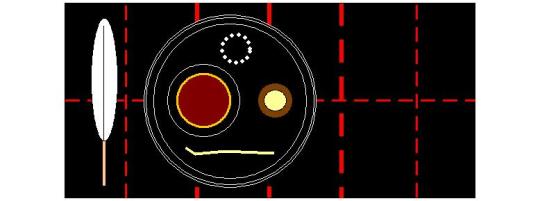
There is also an understanding that the entire space between the (yang-)kane (or between the end-most yang-kane and the heri) is, in effect, considered to be the yin-kane (rather than identifying these as a simple line, as the yang-kane are defined). Unfortunately, in the Nampō Roku, there seems no absolute preference for one understanding of the yin-kane or the other. It must be pointed out that “yin-kane” are not actually mentioned in any of the oldest teachings, and neither are they ever discussed by Rikyū (who seems to have thought only in terms of the five yang-kane -- which are associated with han [半] -- and the spaces between them, which are chō [調]). Yin-kane, then, may have been a(n unnecessary) creation of Tachibana Jitsuzan.
We must remember that, each object associated with a yang-kane adds a value of “1” to the kane-wari count, while those associated with the purported yin-kane add either “2” or “0” (either way of looking at it is perfectly acceptable) -- and so have no impact on the kane-wari total.
1 note
·
View note
Text
Nampō Roku, Book 5 (6): the Display of a Chaire on the Ordinary Square Tray.

6) Chaire・tsune no hō-bon¹ kazari [茶入・常之方盆飾]².

[The writing reads: (above the sketch) kaku no gotoki chaire bon ni nose kazarite (如此茶入盆ニノセカザリテ)³, chawan ni te mo temmoku ni te mo dai ni nose hakobu (茶碗ニテモ天目ニテモ臺ニノセハコブ)⁴; (between the ten-ita and the ji-ita, from the right) shita jo-jō (下如常)⁵, habōki soete mo soezu mo (羽帚添テモ不添モ)⁶.]
_________________________
◎ The reader is asked to take note of the simplicity and directness of the kaki-ire [書入] that are found in the block of entries that was purged from the Enkaku-ji manuscript of the Nampō Roku, since it gives us a window into the state of the commentary during the last years of Tachibana Jitsuzan’s lifetime. After his death, many of the “surviving” sketches acquired extensive bodies of commentary that often seem to serve no real purpose (they all too frequently have only a tangential relevance to the arrangement to which they were appended) -- other than to modify the focus of the narrative of the material presented in Book Five (as a whole) to something that was not a part of Jitsuzan’s scholarly intention.
¹Hō-bon [方盆].
This refers to the square version of the naka-bon [中盆]. The round version measures 1-shaku 2-sun 3-bu in diameter*, while the square version measured 1-shaku on each side†.
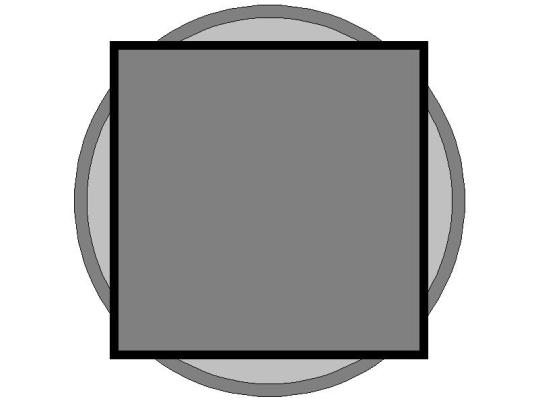
This sketch shows how the two trays compare with each other‡.
Notice that, when the chaire is placed on the kane with which it is associated, the naka hō-bon fits between the kane on either side, while the larger naka maru-bon will extend across all three kane**. __________ *The actual tray was 1-shaku 2-sun in diameter. However there was a band around the middle of the side that increased its diameter to 1-shaku 2-sun 3-bu.
It would seem that this tray had originally been made for carrying hot dishes of food from the kitchens to the residential apartments (the face had an inlaid brass plate which protected the lacquer from being scorched), and the raised band around the side functioned as a sort of hand-grip.
†According to entry 45 in Book Six of the Nampō Roku, while the round tray was a member of the original six meibutsu trays that were used by Ashikaga Yoshimasa, the square tray was not part of this set (mata kono naka-bon no kae ni, shi-ho no isshaku-bon mo ari, saretomo maru naka-bon ha roku-mai no kazu ni te, shi-ho naka-bon ha roku-mai no soto nari [又コノ中盆ノカヘニ、四方ノ一尺盆モアリ、サレトモ丸中盆ハ六枚ノ數ニテ、四方中盆ハ六枚ノ外也]).
That said, the square tray appears to have been in use since at least the late fifteenth century, making it one of the most venerable of the additions introduced by the machi-shū chajin. Nevertheless, no description of the original naka hō-bon survives, not even an indication of whether it was imported, or a product of the Japanese lacquerers.
‡In general, many of the arrangements sanctioned in Book Five for the naka maru-bon could also be realized using the naka hō-bon.
**When a tray crosses two or more kane, it is referred to as a kuguri-bon [潜り盆] in the Nampō Roku.
²Chaire・tsune no hō-bon kazari [茶入・常之方盆飾].
“The chaire -- the usual way it is displayed on a square tray.”
As mentioned above, the naka hō-bon [中四方] was introduced for use -- at least, in the tearoom* -- by the early machi-shū chajin, during the second half of the fifteenth century. This earliest group of wabi practitioners (the majority of whom were expatriates from the continent, who arrived in Japan after the middle of the century) frequently used chaire made at the Seto kilns (since their circumstances precluded their availing themselves of the rare and costly continental imports). The earliest Seto chaire were the large taikai‡ -- which had been made for use on the o-chanoyu-dana -- that measure around 3-sun in diameter; and it seems that it was a chaire of this sort that was supposed to be displayed on a naka hō-bon in this way.
Shibayama Fugen states that one of the manuscripts to which he had access shows this chaire [displayed] on the first kane on the right seat**. However, he says that this is a mistake. “[The chaire] should be [displayed] on the central kane. For, while it might be possible to place it on the first kane on the left seat, placing it on the right seat is a violation of the rules.
“In entry 20 in Book Nine††, it is stated that:
On the upper shelf of the daisu, it is the case that the chaire should be displayed on the left seat. When serving usucha, it might be possible to decide [to display the chaki] on the right seat...but [the container of] koicha must absolutely [be displayed] on the left seat. This is because, even though the board [on which the tea container rests] is rather far away from the steam emanating from the kama [that is found beneath the right seat], one must be concerned that the steam will, nevertheless, damage the tea‡‡.”
His remarks, then, have no real impact -- despite the fact that they occupy the first place in his commentary on this arrangement -- since he confirms that the version of the sketch that was (originally) found in the Enkaku-ji manuscript*** was correct. ___________ *Given that it was usual for things to be incorporated into the temae based on some sort of precedent (especially in the early days of chanoyu), it is more likely that the naka hō-bon had already been used as a base for the chaire elsewhere -- such as when preparing tea at the o-chanoyu-dana -- than that the machi-shū would have proposed its use “from scratch.” Indeed, this would have confirmed the relationship between this tray and the large taikai, since the taikai was the chaire that was traditionally used on the o-chanoyu-dana (according to Nōami).
†At this time -- as refugees fleeing the political upheavals that racked the Korean peninsula during the last decades of the fifteenth century -- there were, for a time, more people desirous of practicing chanoyu than there were utensils that would enable each to amass his own complete set of foreign-made pieces. The result was that many of these chajin were forced to turn to native craftsmen as a source for the missing utensils -- though, at this time, it appears that they were obliged to keep their requests as simple as possible.
But as the Japanese potters became more and more used to working on commission, it became easier to order things from them (it seems likely that agents were already setting up shop in the major cities, providing the liaison between the chajin and the potters, who whose kilns were always in the distant countryside). This is why Shukō, in his Kokoro-no-fumi [心ノ文], cautions beginners not to presume to do so without suitable experience. His admonishment involves both the idea that beginners should not be ordering custom-made pieces until they are fully aware of the most intimate details of what is necessary (which knowledge can be gained only from experience using the objects approved by previous generations); as well as to discourage people from entering chanoyu casually -- in other words, without being willing to demonstrate a suitable degree of commitment and dedication (which the financial outlay for continental pieces would necessarily involve: by the time of the Kokoro-no-fumi, the number of practitioners had already begun to contract as the generation of refugees began to die off, meaning that continental pieces were becoming increasingly easy to acquire -- and the easiest way for a beginner to do so would be through ones teacher, thus the letter also implies that one should, first of all, forge a close relationship with an experienced member of the tea community).
‡These chaire had been made as the containers for tea that were used on the o-chanoyu-dana in the days before the introduction of chanoyu to Japanᵃ. Thus they were large enough to hold sufficient matcha for a whole day’s useᵇ.
While imported pieces were always preferred, the fact that the majority of the utensils used on the o-chanoyu-dana were never seen by the guests encouraged the use of locally made pieces whenever continental examples were not available -- and the early Seto taikai [古瀬戸大海] were among these pieces. These large taikai-chaireᶜ, came to be referred to as ko-Seto chaire [古瀬戸茶入] by the people of Jōō’s and Rikyū’s day.

The large taikai measure around 3-sun in diameter, so that when they were centered on the naka hō-bon (which was 1-shaku square), they would be 3-sun 5-bu from the edges of the trayᵈ.
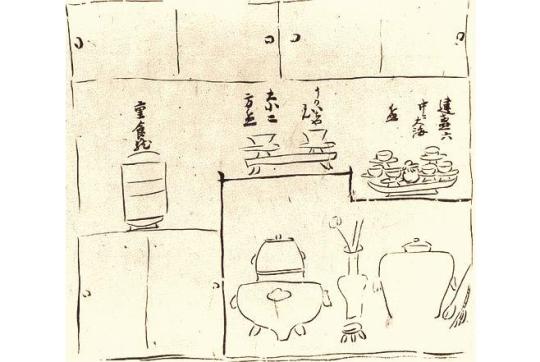
While the large taikai is clearly depicted in his sketch of the o-chanoyu-dana in the Kundai kan sa-u chōki [君臺觀左右帳記] -- and is labeled as such (the second column of characters from the right reads naka ni taikai [中ニ大海]) -- Nōami does not describe how the o-chanoyu-dana was actually used to prepare teaᵉ. It is entirely possible (even likely) that something like a naka hō-bon was placed under the large taikai to protect against spilled matcha, and this may have been the precedent on which the machi-shū based their usage. ___________ ᵃThe drinking of matcha (always as usucha), at least by monks, dates back to the Heian period (at which time the pre-ground powder seems to have been imported from the continent). To what extent the upper classes ever indulged in the practice in the early period, however, is unclear. Usucha does not seem to have become more or less common until the Kamakura period.
ᵇSince the residents of the household could call for tea (usucha) at any time of the day (and, to a certain extent, into the night), both matcha and hot water had to be available whenever they might be needed. A special person, who was traditionally decked out as a monk (whether or not he was actually tonsured) seems to have been stationed at the o-chanoyu-dana for this purpose. The taikai, as well as the kama and mizusashi, were all especially large, in anticipation of this need.
While these people were apparently preparing usucha according to a certain ceremony at the time of Ashikaga Yoshimasa (since he is said to have imitated their actions in his temae), it is not clear how far back in history this particular detail stretched: it is possible that their procedures were influenced by the introduction of chanoyu in the late fourteenth century; but it is just as possible that these methods had been part of the practice since the drinking of usucha became popular among the military and noble classes in the Kamakura period (tea seems to have been brought to Kamakura by the monk Myōan Eisai [ 明菴 榮西; 1141 ~ 1215] -- who left a trail of temples, at which tea was drunk, across Korea and western Japan, as he moved on toward the political capital of Japan: possibly his progress was slowed by the fact that tea seeds only remain viable for several days after picking, thus he would have had to plant his seeds, wait for them to grow, flower, and then fruit, before moving on to the next place...and this is something that Kanamori Sōwa’s argument that “Eisai brought tea to Japan from China” fails to take into consideration).
ᶜThe use of the large taikai seems to have preceded the specially commissioned pieces that were made to order for the early generations of expatriate chajin.
The latter chaire were usually referred to as katatsuki, though their simple cylindrical shapes, narrow shoulders, wide mouths, and rather heavy potting, differ markedly from the Chinese katatsuki.

Their sizes, too, seem to have been derived from the ko-tsubo chaire [小壺] that were used when serving koicha (usually the earliest of these are 1-sun 9-bu or 2-sun in diameter: the example shown measures 1-sun 9-bu) -- though their increased height meant that these early “katatsuki” could hold sufficient tea for the service of five or more guests. (While Edo period writings argue that 10 guests were entertained at the early tea gatherings, Jōō’s actual records suggest that their number was rarely more than six, and even that number was exceptional.)
ᵈThis concatination of details is how it is possible to deduce which chaire were actually intended to be used in this arrangement -- as well as the others in Book Five of the Nampō Roku. The commentaries, however, suggest that such details had been lost early on, and possibly even long before Tachibana Jitsuzan first gained access to the Shū-un-an material.
Traditionally these measurements were kept secret -- possibly because of ignorance on the part of those who were aware of them (since they did not know the reason for why these objects were consistently of a certain size, they did not wish to be confronted with questions regarding why such details were important). The result, however, was that, more and more, utensils began to be used inappropriately -- and technically unsuitable pieces began to be “favored” by the iemoto and other prominent chajin.
ᵉThe purpose of the Kundai kan sa-u chōki [君臺觀左右帳記] was only to show the shōgun’s retainers how to restore the decorations in the various rooms in the official residence after things had been put away for whatever reason (semi-annual cleaning, the shōgun’s prolonged absence and the subsequent closing up of his mansion, and so forth).
While a set of six dai-temmoku were placed with the taikai on a large round tray, the size of this tray made it unlikely that it was lowered to the floor and used as a base for the preparation of bowls of tea (indeed, doing so would have presented a number of difficulties -- including what to do with all of the other dai-temmoku that one was not using at the moment,or how to take them all off of the tray). Consequently, while the temmoku-dai would keep the chawan from touching the floor, something would have had to be placed under the taikai to achieve the same degree of protection.
The fact that all of the early temae employed some sort of large tray as a base for the chaire suggests that something of the sort was probably being used here, too.
**Traditionally, Nampō Roku scholars describe the objects arranged on the daisu as if the daisu (and so, they) were facing toward the host. Thus, “the right-seat” is on our left, and the “left-seat” is on our right.
This kind of thing is commonly seen in the “secret” writings of the Edo period -- a deliberate attempt, it would appear, to confuse the uninitiated. In this particular instance, it seems that it was also some of the scholars who became confused, resulting in the illegitimate interpretation to which Shibayama calls our attention. The dispute over whether it was better for the chaire to be displayed on the central kane, and the subsequent uproar over the correct interpretation of the side of the ten-ita on which it should be placed, is one possible reason why this sketch (and the others of its ilk) was torn out of Book Five of the Enkaku-ji manuscript (and then subsequently removed from the Tachibana family’s version as well).
Dai-ichi no kane [第一ノ矩] -- “the first kane” -- refers to the two kane on either side of the central kane (in other words, one counts outward toward the ends of the shelf) -- in this case, Shibayama Fugen is referring to the kane to its left.
††Book Nine is the book of secret teachings. It was not part of the original collection of documents that Tachibana Jitsuzan forged into the Nampō Roku . Rather, it was added later, produced by the group of scholars who were gathered in the Enkaku-ji, to provide additional information and guidance (regarding the interpretation of the obscure points that are found in the original material) to future generations -- probably when it became apparent that information was being lost as the older members of the group died off. In addition to admonitions such as this (the original text of which is quoted below in the next sub-note), it includes things like historical notes, as well as practical instructions (such as the details of how to tie some of the obscure knots that were used on the decorative boxes in which certain Chinese utensils were kept) and other matters of that sort.
Rather naturally, perhaps, the ninth book is not included in most of the published versions of the Nampō Roku -- since most of these editions were produced under the auspices of one or another of the modern schools, which prefer to keep this kind of information as inaccessible and mysterious as possible (often because they have their own interpretations, based on the details of their own traditional usages, that not infrequently conflict with the scholarly opinion that has emanated from the Enkaku-ji).
‡‡The passage quoted by Shibayam Fugen reads: daisu jōdan-no-ita, hidari-za ni chaire wo kazaru-koto, usucha tote mo migi-za [h]e yō-sha subeshi...koicha ha kanarazu hidari-za nari: kama no yu-ge ita wo hedatsu to ie-domo cha wo musu kokoro-ari iu-iu [臺子上段ノ板、左座ニ茶入ヲ飾ルコト、ウス茶トテモ右座ヘ用捨スベシ...濃茶ハ必ズ左座ナリ。釜ノ湯氣板ヲ隔ツト雖モ茶ヲ蒸ス心アリ云〻].
The ellipsis between subeshi [スベシ] and the word koicha [濃茶] is also present in Shibayama’s quotation of this text.
***This is one of eight arrangements that were removed from this place sometime between 1690, when Tachibana Jitsuzan presented his manuscript to the Enkaku-ji (or, more likely, sometime after Jitsuzan’s death, which occurred in 1708, since it is difficult to imagine that he would have sanctioned the desecration of his manuscript in such a monumental manner), and 1778, when the Gunsho Ruijū [羣書類] edition of the Nampō Roku was being prepared for publication (the printing of the encyclopedic Gunsho Ruijū commenced in An-ei 8 [安永八年], 1779) -- since they are missing from that version of the text.
³Kaku no gotoki chaire bon ni nose kazarite [如此茶入盆ニノセカザリテ].
“The chaire is displayed resting on the tray, as in this [sketch].”
The chaire is placed in the middle of the tray, and the tray is centered on the ten-ita of the daisu, so that the chaire rests on the central kane. However, it should not be placed as a mine-suri [峰摺り]*.
The naka hō-bon was probably Jōō’s immediate inspiration for the chaire-bon, despite Rikyū’s well-known story that proffers an alternative derivation†. ___________ *A chaire worthy of being displayed as a mine-suri would not be placed on a naka hō-bon; and, indeed, since the large taikai-chaire in question had been made for use on the o-chanoyu-dana, their antecedents would have precluded their ever being used in that way. Thus, the use of the naka hō-bon represented a first and deliberate step in the direction of wabi. We must not forget that, in the early days, the daisu was used on every occasion, even by those committed to the practice of wabi. Thus, when objects made for the o-chanoyu-dana came to be used in the tearoom itself, the simplifications were accepted as a matter of course.
†Rikyū, in several of his densho, relates how Jōō created the chaire-bon “by cutting the nagabon in half.”
In fact, Jōō seems to have arrived at the chaire-bon by eliminating the space for the chasen (which, in the early days, was usually stood on the tray when there was no kae-chawan present: this usage, which is no longer extant, is illustrated in the sketch). Whereas the naka hō-bon is 3-sun 5-bu larger than the taikai on all four sides, Jōō’s chaire-bon was just 3-sun larger. It seems to be for this reason that Jōō articulated the rule that the large taikai should not be placed on a chaire-bon (since the naka hō-bon already existed for this purpose) -- though the small taikai (ko-buri taikai [小降大海]), which measured 2-sun 5-bu in diameter (and so was too small to be used on the naka hō-bon) was excepted from this rule, and could be used on a chaire-bon just as a large katatsuki (indeed, the chaire-bon for these two were of a similar size).
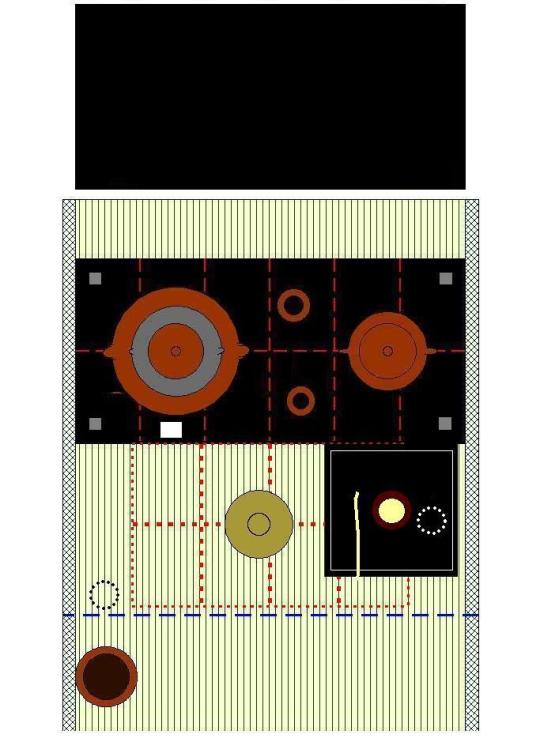
In this early period, the wabi-chajin used bowls like the Shukō-chawan as their omo-chawan. (Between ten and twenty bowls of this sort are mentioned in the old records, with the most obvious distinguishing feature being the number of marks that are found on the outside of each bowl, left by the hake [刷毛] -- a brush-like object made from a small bundle of reeds that was used to beat the slab of clay against a wooden mold that formed the interior of the bowl. These bowls were made for serving noodles at road-side food stalls in southern China, and so had to be of uniform size to prevent problems with the customers, hence the mold. Such bowls were probably sold in lots of 10 or more, hence the relatively large number of nearly-identical chawan of this sort that appeared in Japan in the late fifteenth century.)
⁴Chawan ni te mo temmoku ni te mo dai ni nose hakobu [茶碗ニテモ天目ニテモ臺ニノセハコブ].
“Whether it is a chawan, or a temmoku, [the bowl should] rest on a dai, and be carried [out from the katte, at the beginning of the temae].”
In other words, as in the previous arrangement, here tea will be served for a nobleman, and so the chawan -- or temmoku, as the case might be -- is placed on some sort of dai. Whether a Chinese temmoku-dai, or a Korean chawan-dai, or even something like a large sakazuki (such as Rikyū placed under the Shukō-chawan), the point is that the chawan should not rest directly on the floor.
The bowl is carried out from the katte at the beginning of the temae, with the chakin, chasen, and chashaku arranged in it as usual.
⁵Shita jo-jō [下如常].
The furo and the rest of the kaigu are arranged on the ji-ita in the usual manner.
⁶Habōki soete mo soezu mo [羽帚添テモ不添モ].
As was the case with the previous arrangement, whether or not to display the habōki on the ten-ita is up to the host’s discretion -- and would depend on the demands of kane-wari, as well as the availability of a suitable habōki.
——————————————–———-—————————————————
◎ Analysis of the Arrangement.

The sketch, as found in Shibayama Fugen’s commentary, shows the chaire, placed on a naka hō-bon [中方盆], displayed so that the chaire rests on the central kane. The fact that the three kane in the middle are 3-bu wide allows the host to associate the chaire with the central kane while avoiding giving the impression that it is displayed as a mine-suri [峰摺り].

Shibayama’s text also allows for the possible display of a habōki, as shown in the second sketch, above.
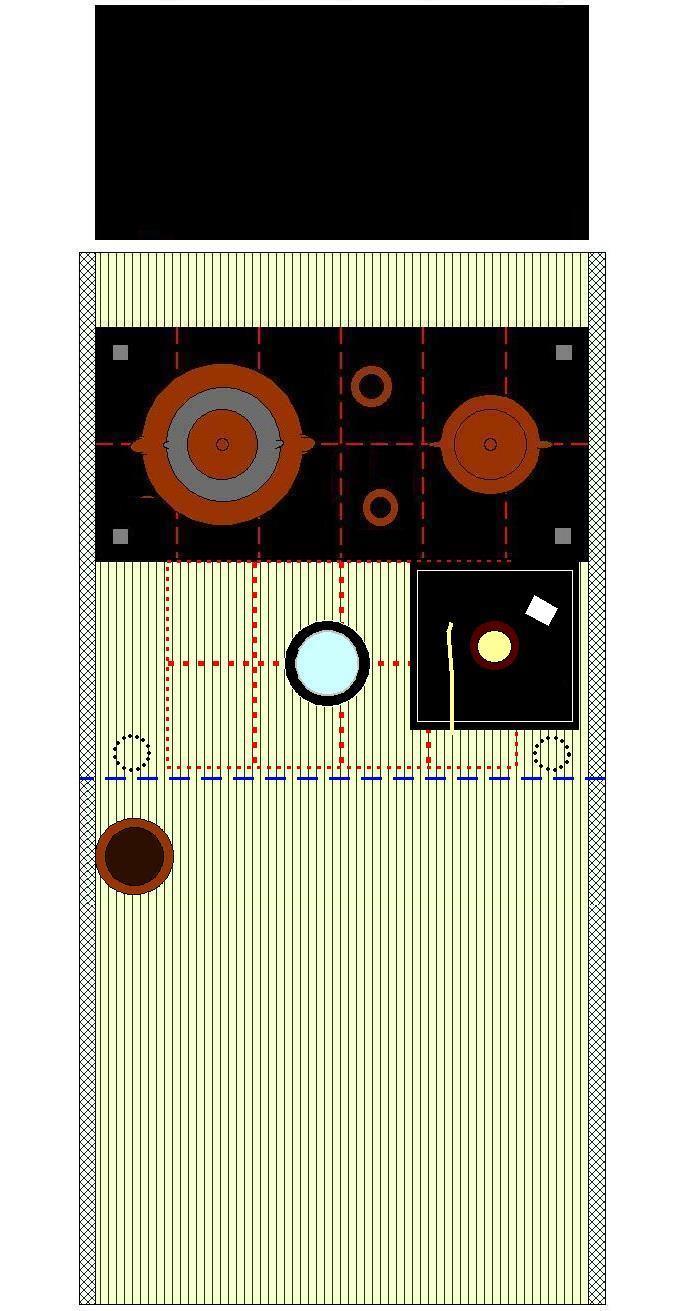
As for the temae, the naka hō-bon was placed on the mat so that it touched the front edge of the daisu (this was also true of the original nagabon, and the other meibutsu trays when used as a base for the chaire); the tray was oriented so it was 1-me from the right heri.
During the temae, the chashaku was centered between the chaire and the left rim of the tray.
1 note
·
View note
Text
Nampō Roku, Book 5 (4): the Ordinary Way to Display a Chaire and a Chashaku.

4) Tsune no chaire・chashaku kazari [常茶入・茶杓飾]¹.
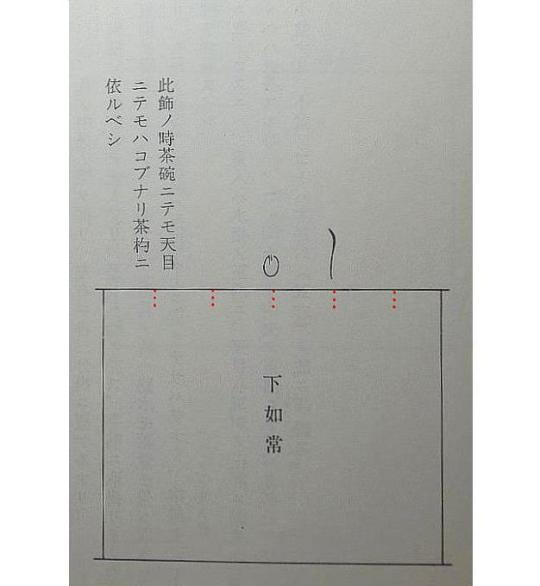
[The writing reads: (above the daisu) kono kazari no toki chawan ni te mo temmoku ni te mo hakobu nari (此飾ノ時茶碗ニテモ天目ニテモハコブナリ)², chashaku ni yoru-beshi (茶杓ニ依ルベシ)³; (between the ten-ita and the ji-ita) shita jo-jō (下如常)⁴.]
_________________________
◎ This is the first of eight arrangements* that are not found in the Enkaku-ji manuscript of the Nampō Roku; nor are these found in Tachibana Jitsuzan’s original copy of the Shū-un-an documents as published in the Gunsho Ruijū [羣書類]†. However, this does not mean that they are spurious. During Jitsuzan’s lifetime, four copies of the Enkaku-ji manuscript are known to have been made (this was done officially, with permission given by both Jitsuzan, and the Abbot of the Enkaku-ji -- probably with the intention of reducing wear and tear on the original document), and it was from the lineage of one of these that Shibayama Fugen’s source material derived.
Their absence from the other sources might be supposed to be the result of the fact that these kinds of arrangements -- though similar things are found in some of Rikyu’s densho -- were of a sort that was not approved by the Senke; and it may have been someone acting on their interests that was behind its removal‡.
As for why they are not found in the published version of Jitsuzan’s original collection of notes**, the Gunsho Ruijū was published in An-ei 8 [安永八年] (1779). This was a little less than a century after Tachibana Jitsuzan finished work on the presentation copy of the Nampō Roku. It would seem that the kiri-kami for this arrangement (as well as pages documenting several other arrangements) was removed rather early on, perhaps not long after Jitsuzan’s death (in 1708), and so was already absent when the editors of the Gunsho Ruijū applied to the Tachibana family for access to their documents.
Be that all as it may, I will go through these “missing” arrangements in this translation, primarily because they more logically lead from the bon・dai kazari to the nagabon kazari (and so can be considered as a sort of “wari-geiko” for the highest temae††). ___________ *From this part of the book. For some reason, this block of arrangements were apparently removed as a unit. Other arrangements have been removed from other parts of the book, but this is the most serious incident of what might be considered pro-Senke “censorship” (if that is what it, in fact, was).
†The block-printed facsimile edition was based on Jitsuzan’s original manuscript, rather than the Enkaku-ji version of the text, because access to the latter was refused. The Gunsho Ruijū version served as Tanaka Senshō’s teihon [底本] -- for a similar reason.
‡It is also possible (though somewhat less likely -- especially if we consider the collection of missing temae as constituting a unit) that another reason for its absence is because someone wanted a “souvenir” of the original, and surreptitiously tore it out of the Enkaku-ji manuscript (perhaps judging this arrangement -- since it was not sanctioned by the Senke -- to be irrelevant or superfluous).
It appears that the Tachibana family attempted to keep the manuscript in their keeping (which was the original copy that Jitsuzan had made with the Shū-un-an documents spread out before him) aligned with the Enkaku-ji version of the text. Thus, when kaki-ire were added to the Enkaku-ji manuscript, these were also transcribed into the family’s copy; and when, as here, a page was removed from the Enkaku-ji manuscript (for whatever reason), the corresponding page was also taken out of their copy.
Apparently not all of the curators of the other four copies were as diligent about following the same practice as was the Tachibana family. Thus at least some of these versions began to differ from the Enkaku-ji version over time -- and this was especially true of the contents of Book Five.
Naturally, when a page remained part of their version, the traditions connected with that arrangement continued to be handed down within the circle of scholars who gathered around that particular manuscript. And it was one of these people who, in his old age, finally imparted these teachings to Shibayama Fugen (perhaps when the final demise of the tradition was already rearing its head, as one generation of scholars began to die off, while their ranks were no longer being replenished, as Japan began to Westernize and modernize, and came to view these “ancient” traditions, more and more, with scorn and derision).
**According to the Enkaku-ji manuscript, the Tsune no bondai kazari [常盆・臺飾] (which was discussed in the previous post) is followed by an entry known as the Son-kyaku shoza no kazari nari [尊客初座之飾也], which, as the title suggests, is the way the daisu was arranged during the shoza when serving tea to an extremely exalted shōkyaku (though the goza arrangement is not found under that name in the present version of the Enkaku-ji manuscript).
In Tanaka Senshō’s commentary (which is based on the version of Jitsuzan’s original notes that were published in the Gunsho Ruijū), the Tsune no bondai kazari is followed by an arrangement named the Nagabon tsune no mitsu-kazari [長盆常ノ三ツ飾也], which is an arrangement where the dai-temmoku, chashaku (also tied in a shifuku), and chaire are arranged together on an “ordinary” nagabon (measuring 1-shaku 5-sun 2-bu by 1-shaku 4-bu). In this temae a chaire-bon is brought out for the chaire, and the temmoku and its dai are handled together on the nagabon. This is the “shin no shin” [眞之眞] temae of several of the modern schools, and in at least two of them it is considered to be their isshi sō-den [一子相傳], a knowledge of which is supposedly reserved to the iemoto alone. (Since it involves a chaire-bon, the temae can be dated no earlier than Jōō’s middle period, since Jōō was the creator of the chaire-bon; it was popularized by the machi-shū, and thus came to the hands of the Senke -- who, since they were ignorant of the actual gokushin temae, imagined this one to be “highest,” because it was the most complicated.)
††The organization of Book Five was apparently much more logical than it appears today -- when viewed in its entirety, with the missing temae restored to their original positions, the initial part of the book progresses from the basic arrangement, to the use of the bon-chaire and dai-temmoku, and then, through various permutations, arrives at the nagabon kazari, and so on to the gokushin futatsu-gumi temae and the san-shu gokushin temae (which was, historically speaking, the first temae publicly performed in Japan -- on the 18th day of the Sixth Month of the year corresponding to 1403).
Certain of the “missing” temae (and variants) are first documented in Katagiri Sekishū’s little known collection of treatises on the practice of the daisu, Ro-daisu no koto [爐臺子之㕝], Sō no shin・gyō・sō [草之眞・行・草], Gyō no Shin-daisu・gyō・sō [行之眞臺子・行・草], and Gokushin-daisu・ryō-kijin [極眞臺子・兩貴人] -- which he wrote as part of his study of Jōō’s chanoyu -- which predated the Nampō Roku by several decades. Perhaps it was for this reason -- to make the contents of this present collection appear wholly unprecedented -- that these temae were removed? This was all at the time, we must remember, when, while publicly making their secrets even more secret, the various schools were privately comparing notes, in an effort to establish their own lines of orthodoxy.
While I had originally intended to deal with these missing temae as an appendix to the book (in much the same way as I handled the missing gatherings that are found in the Rikyū hyakkai-ki [利休百會記] when translating Book Six of the Rikyū Chanoyu Sho [利休茶湯書]), on deeper reflection it seemed more logical (in light of the way that the series of temae build upward from the simpler forms to the gokushin temae) to restore them to their original places here; and so I will do.
¹Tsune no chaire・chashaku kazari [常茶入・茶杓飾.
This arrangement shows the way to display a chaire* that is accompanied by a chashaku that was made for it† by a mei-jin [名人]‡ of bygone days. The specific purpose of this arrangement is to draw attention to the chashaku.
Displaying the chashaku to the right of the chaire -- which, in the original configuration (where the guests are seated on the host’s left, and the katte is located on his right), is the higher seat -- indicates that the chashaku somewhat outranks the chaire. Thus the chaire is probably what we would consider an ordinary piece (rather than a meibutsu), and it is the fact that the chashaku was carved by someone important in the history of chanoyu that sanctions its being displayed in the higher place**.
A chashaku made by the host would never be displayed like this. ___________ *Because the chaire is not on a tray, and because it is not centered on its kane (let alone displayed as a mine-suri [峰摺り]), this indicates that it is a rather ordinary one.
†Traditionally, the chashaku was made to be used with a specific chaire (or, at least, with a chaire of a specific size -- a 1-sun 9-bu ko-tsubo, a medium-sized, 2-sun 2-bu, nasu, or a large, 2-sun 5-bu, katatsuki: all of these sizes were fairly standard, and most of the classical chaire fit into one of these categories).
In the early days this was because the chashaku had to be long enough to extend beyond the rim of the tray (during the temae), while still contacting the tray in line with the far edge of the foot (and with the bowl extending as far as the back side of the chaire). This is why, for example, the meibutsu ivory chashaku came in three different lengths.
‡A master. For example, Ashikaga Yoshimasa is said to have carved chashaku with his own hands. The same is true of Shukō.
**Possibly an ivory chashaku could be displayed like this, but only one that had been owned by a famous tea master of the past -- and preferably one that he had personally used with this chaire.
²Kono kazari no toki chawan ni te mo temmoku ni te mo hakobu nari [此飾ノ時茶碗ニテモ天目ニテモハコブナリ].
“When employing this arrangement, whether [the host] uses a[n ordinary] chawan, or a [dai-]temmoku, [the bowl] is carried out [from the katte].”
³Chashaku ni yoru-beshi [茶杓ニ依ルベシ].
“[Whether it is an ordinary chawan, or a dai-temmoku, that is carried out from the katte] depends on the chashaku.”
In other words, the host must be sensitive to the circumstances for which the chashaku was created. If it was made by someone like Yoshimasa (whose style of chanoyu generally involved serving tea with a dai-temmoku), then it might be best to use a dai-temmoku; if the chashaku was made by Shukō, then perhaps an ido-chawan (or other large bowl) might better suite the mood of the chashaku.
The chashaku is displayed on the daisu in this way because it was made (or favored) by a certain mei-jin [名人]*, and so the current use should mirror that person’s intentions. ___________ *According to the Yamanoue Sōji Ki [山上宗二記], “[he who] owns karamono, and is an expert at both appraisal [of the objects used as tea utensils]ᵃ and [the technical aspects of the practice of] chanoyuᵇ; one who is already possessed of these three, plus has a deep aspiration for this one Wayᶜ: it is said that such a one is a mei-jin”ᵈ.
Sōji, elsewhere, further clarifies that a mei-jin is someone worthy of being called “the greatest under heavenᵉ.”
At any rate, the point is that the chashaku should not be one made by ones teacher, or someone like that. It is displayed in this way because it is important, not to the host, but to chanoyu itself. ___________ ᵃThis means that he is not only able to look at an object and estimate its value, but also deduce the suitability of a new object for use as a tea utensil.
ᵇHe is expert not only in the rules and system that govern the temae, but is able to expand these (based on precedent and experience) to encompass the use of things previously never used as tea utensils.
ᶜKokorozashi-fukai [志深キ] means not only a deep aspiration, but also a deep commitment, and a deep motivation to dedicate his life to the practice of chanoyu, to the exclusion of all else.
That said, here we see the intrusion of Edo period “norms” where the arts are to be kept strictly apart. One who practices chanoyu must not be involved (at least professionally) with any of the others. To what extent the Yamanoue Sōji Ki was an independent creation, or whether it was purpose-made to support these Edo period sentiments (while also providing the Tokugawa bakufu with a solid precedent upon which to base their valuations of the meibutsu tea utensils -- largely taken directly from Hideyoshi’s personal collection -- that they were intent on turning into cash to pay off Ieyasu’s war debts, or using as awards to their daimyō supports in lieu of increases to their fiefs) is open for discussion.
ᵈKaramono shoji, me-kiki mo chanoyu mo jōzu, kono san-ka mo totonoi, ichi-dō ni kokorozashi-fukai ha mei-jin to iu nari [唐物所持、目利モ茶湯モ上手、此三箇モ調ヒ、一道ニ志深キハ名人ト云也].
ᵉTen-ka ichi [天下一]. Some have translated this, in the present context, as “the greatest [tea master] of his generation;” or “the greatest master in the world.”
⁴Shita jo-jō [下如常].
The kama・furo and kaigu -- the objects arranged below (on the ji-ita) -- are (in number and orientation) as usual.
——————————————–———-—————————————————
◎ Analysis of the Arrangement.

The sketch shows the chaire overlapping its kane by one-third*, and the chashaku placed on its kane (though not as a mine-suri [峰摺り])†.
As for the temae, the chawan‡ is brought out from the katte and rested on the mat in the lower left-hand corner of the temae-za. Then the chashaku is picked up and rested on the chawan, as usual. Next, the chaire is lowered to the mat and placed in front of the mizusashi, and then the chawan is placed beside it.
Thereafter, the service of tea is performed as usual.
In his commentary, Shibayama Fugen adds that, according to his sources, if the chaire is actually a meibutsu piece, then perhaps the chashaku should be displayed on the first kane on the lower side of the daisu (so that it will be visually subordinate to the chaire**). ___________ *In other words, the chaire is placed so that the right side of its foot is immediately to the left of the central kane. Thus the chaire’s bulk will appear to overlap the kane by approximately one-third.
†The chashaku is placed flat on its kane (not laid on its side, as the sketches might suggest -- this was done, in both my own and Shibayama Fugen’s sketches, so that the resulting image would not simply show a straight line), but the host should generally not make an effort to position it squarely on the kane, since, while the chashaku is important (because of the person who made it), it is not (usually) a great meibutsu that is worthy of mine-suri placement. This distinction should be clearly understood.
‡Whether this is an “ordinary” chawan (such as an ido-chawan), or (an “ordinary”) dai-temmoku depends on the chashaku, as explained above under footnote 3.
**There is no difference to the temae, however. After bringing out the chawan, the first thing the host does is lower the chashaku to the chawan.
1 note
·
View note
Text
Nampō Roku, Book 4 (19): Displaying a To-shiba [鳥柴].

19) A to-shiba [鳥柴] should be displayed, as it was received, on the engawa [of the shoin]².
If there is a letter or tanzaku, or something of that sort³, the way to attach these things [to the to-shiba], and the way that the knots should be tied -- there are various ways [to do these things]⁴.
[It is also possible to display the to-shiba without a base or a tray.]⁵
_________________________
◎ The final text entry in Book Four of the Nampō Roku is, like the rest of the sections that were tacked onto the end of Jōō's original memorandum, completely spurious, and designed to further the Edo period need to encourage a return to practices associated with what was perceived to be a high period of shōgunal culture in the fourteenth and fifteenth centuries.
The fact that the wealthy merchants were more likely to be concerned with the display of a to-shiba* than members of either the aristocracy or military classes, suggests that it may have been for their benefit that this entry was added to the end of Book Four. ___________ *Since it would show their peers that the recipient had certain close ties with the shōgun or other high government official or court noble.
¹Tori-shiba [鳥柴].
To-shiba [鳥柴] means a bird (tori [鳥], here abbreviated to “to”) attached to a piece of brushwood (shiba [柴])*, for presentation to someone, as a trophy of the hunt.
This curious object of display -- where one (or, by the sixteenth century, several) fowl, taken by the shōgun’s† hawkers, was presented to someone to whom he wished to show special favor‡, formally tied to a reed or branch -- appears to be taken directly out of the chronicles of Japanese chivalry.
The following block-print shows a pair of kabuki actors recreating the exchange of to-shiba in the kabuki [歌舞伎] drama Yuzuriha Kongen Soga [楪根元曾我] (the sketch was taken from the Kabuki Nendai Ki [歌舞伎年代記], a periodical that chronicled the famous plays year by year). The reader should note carefully the condition of the branches**, as well as the way that the birds are positioned on the branches, since these were important points.

The practice of tying the birds to the supporting branch is described in some detail in Section 66 of Yoshida Kenkō's [吉田兼好; c 1283 ~ 1350] Tsurezure-gusa [徒然草]†† -- and it may have been the revival of interest in this material that inspired the creation of the present entry. A translation of this and another historical document related to the arrangement of the to-shiba will follow this post, as appendices‡‡. ___________ *Shiba [柴], “brushwood,” is the general name for the various small trees and shrubs that populate the understory of a forest. The wood from these plants is too small to be used for anything but fuel -- and Japanese woodcutters were employed to cut the shiba and process it into firewood (since the shiba represents a significant fire risk during the dry season).
†Or other high military figure or court noble. In the account mentioned in the Tsurezure-gusa, the donor is the kampaku [関白], the premier or senior adviser to the Emperor, while the author of the other collection of comments was a hereditary court noble and direct descendant of one of the major branches of the Fujiwara clan.
‡While his kaiki suggest that Rikyū often received birds from Hideyoshi’s hawkers (who is said to have enjoyed riding with them in the Eastern Hills almost every day), there is no indication that they were ever presented in any such manner. Rather, their intended purpose was to be used in Rikyū’s kaiseki, and so they were likely sent to him in a state that would facilitate his preparations.
Nevertheless, the fact that Rikyū was apparently never so honored (we must remember, his kaiki relate to official gatherings that he hosted for Hideyoshi’s guests, or on behalf of Hideyoshi, thus the intended recipients of this largess were those guests, not Rikyū; the only “honorarium” of any sort mentioned in the kaiki is the gift of tea from Hideyoshi, and such gifts are only mentioned on occasions when Rikyū chose to share the tea with his guests) does not mean that Hideyoshi never sent a to-shiba to others. Indeed, since indulging in this kind of practice was intended to paint the donor (Hideyoshi) with the same brush as the great shōgun of the past, it is very likely that HIdeyoshi employed the to-shiba as much in his propaganda efforts as the Tokugawa did later, in their own era.
**While the branches are considerably shorter than what is described in the Tsurezure-gusa, this seems to conform with the norms preferred from at least the sixteenth century onward (see the three sketches that were taken from Tanaka Senshō’s commentary, below). The fact that the other elements of the two to-shiba conform with Yoshida Kenkō’s explanation (which he puts into the mouth of the royal huntmaster, Shimotsukeno Takekatsu), indicates that these precedents were well known, and still being observed at that time.
Shibayama Fugen says nothing at all about this entry (beyond a rudimentary explanation of a couple of the special terms that are used) -- his lack of interest is not really surprising, given that he was a cleric -- while Tanaka Senshō only writes that “when birds are tied to a to-shiba, if they are a female and a male, the male should be above; this is a rule, so it has been handed downᵃ;” after which he attached the three sketches shown below. He does not cite any source for the sketches -- or even imply that they were taken from some other work.
The sketches, were, in fact, abstracted from a manuscriptᵇ written by Shijō Takashige [四條隆重; 1507 ~ 1539], a court noble whose house was directly descended from the northern branch of the Fujiwara family. His writings, then, open a window onto the practices that were current during the sixteenth century that can only be grasped faintly through the sketchesᶜ (the writing on the sketches is explained immediately beneath each of them):
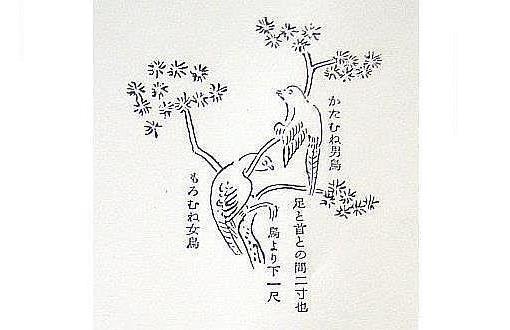
- (from right to left) katamune on-dori [かたむね男鳥] (the male bird [is oriented] with its breast sideways [toward the branch])ᵈ; ashi to kubi to no ma ni-sun nari [足と首との間二寸也] (the distance between the legs [of the upper bird] and the neck [of the lower bird] is 2-sun); tori yori shita isshaku [鳥より下一尺] (below the [lower] bird, [the branch extends] 1-shaku [more]); moromune me-tori [もろむね女鳥] (the female bird [is oriented] with the whole of its breast [facing toward the branch])ᵉ;
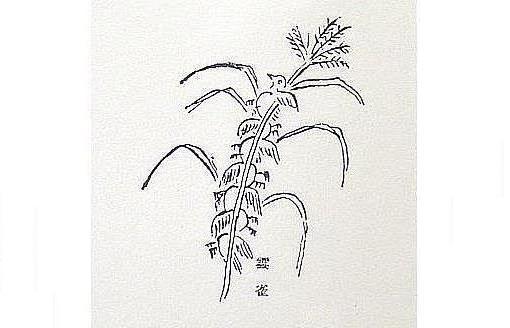
- hibari [雲雀] (skylark);
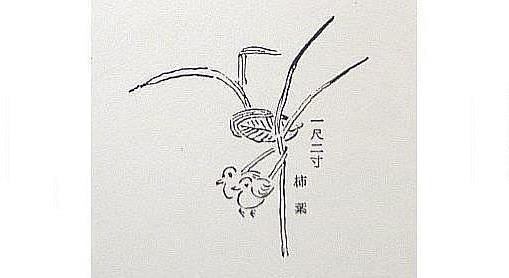
- (from the right) isshaku ni-sun [一尺二寸] (1-shaku 2-sun)ᶠ; kaki-ba [柿葉] (persimmon leaf). ___________ ᵃTo-shiba ni tori wo musubu-toki ni, shi-yū nare ba, osu wo ue ni nado, hō no aru koto to tsutaerarete iru [鳥柴に鳥を結ぶ時に、雌雄なれば、雄を上に抔、法のある事と伝へられてゐる].
ᵇHis writings were printed in the Gunsho Ruijū (Vol. 19) [羣書類、第19輯], which was originally printed in An-ei 8 [安永八年] (1779); and it was from a facsimile edition published between 1898 and 1902 that the sketches in Tanaka Senshō's commentary derive.
ᶜNevertheless, without Shijō Takashige’s accompanying explanations, the sketches are probably more misleading than informative -- and certainly the reasoning behind what is shown cannot be apprehended except by reading ones way through the text.
ᵈSee Appendix II, Part 1, for the full explanation.
ᵉSee Appendix II, Part 2, for the full explanation.
ᶠIt is not entirely clear to what this measurement refers, at least in so far as the sketch is concerned.
††The Tsurezure-gusa enjoyed a certain degree of popularity during the early Edo period, when people (both members of the military class, and the wealthy merchants) began to consult it as an authentic introduction to traditional Japanese manners and customs.
‡‡The passage from the Tsurezure-gusa will be translated as Appendix I; and the (much longer) material from the Gunsho Ruijū, as Appendix II, Parts 1 and 2.
²To-shiba wo sono-mama o-engawa ni kazaruru-koto [鳥柴を其まゝ御縁かわに被飾事].
Sono-mama [其ま〻 = 其儘] means “as it is;” “without changing anything.”
The point is that the to-shiba should be displayed in exactly the same state that it was received, since this would intimate the donor's intentions. Because a to-shiba was given from a superior to someone socially below him*, preserving the display in its original state was important.
O-engawa [御縁かわ]: the engawa [縁側]† is the wood-floored “veranda” that (usually, completely) surrounds the tatami covered inner rooms (from which it is always separated by a bank of shōji). While today the engawa is often enclosed by glazed sliding doors along its outer edge, in the past it was frequently open to the elements (or sometimes separated from the outdoors by shutters, which traditionally folded upward and were held open by metal latches that extended up to the under-structure of the roof, so the veranda could be exposed during the daytime).
According to the text of this entry, the to-shiba was supposed to be displayed on the engawa, either leaning against the balustrade‡, or perhaps resting on or against a type of stand**. __________ *Indeed, only persons of the highest rank would consider giving such a gift -- since only they commonly indulged in hawking. Consequently, the receipt of a to-shiba, while of little actual value, was a great honor -- and one that a wealthy merchant would not only deeply cherish, but would take great pains that his associates view it as well. This is, ultimately, the point of this entry.
†O- [御] is an honorific. In this case, its presence has no impact on the meaning of the word engawa whatsoever.
‡This was the original way in which the to-shiba was displayed.
**I have been unable to find any clear description of this to-shiba-dai [鳥柴臺], though presumably it was similar to the stand against which a bow was leaned. However, since the length of the branch to which the bird was tied decreased significantly between the classical period and the Edo period, perhaps the Edo period's to-shiba-dai was more like the stand for a flag pole -- a weighted base with a hole in the middle, into which the lower end of the branch was inserted.
The final sentence in the entry (which was accidentally transposed to the end of the previous section in the Enkaku-ji manuscript of the Nampō Roku) suggests that a large tray was also placed underneath, probably to catch any blood or other fluids that might drip from the dead bird. (While originally the bird was supposed to be removed and prepared for eating shortly after the to-shiba was received, it appears that in the Edo period the to-shiba was viewed as a kind of decoration, and so left standing on the veranda for as long as possible: the fact that to-shiba were often dispatched during the cold months of the year would have aided in preventing the bird from starting to smell for up to several weeks; and meanwhile, flesh from the same kind of bird, procured in the market, could be served in the kaiseki.)
³Arui ha fumi ・ tanzaku nado [あるひハ文短尺など].
Tanzaku [短尺] means tanzaku [短冊], the special piece of high-quality writing paper, cut to a size of 1-shaku 2-sun long by 2-sun wide*, on which a waka poem could be written in a single line of characters.
Because the to-shiba was always a gift, it was polite for it to be accompanied by a letter, or at least a poem, written by the donor. While in the classical period the poem might be chanted by the servant who delivered the to-shiba†, by the Edo period things had to be written down.
While kaishi was the usual paper for doing so in the early days, by the Edo period it was apparently more common to write ones poem on a beautiful tanzaku (probably beforehand -- it is hard to imagine someone doing this on horseback while hunting in the mountains, since the results were going to be displayed and admired, after all), which could be dispatched together with the to-shiba. And since, by then, it was understood that the bird affixed to a branch would be displayed (rather than consumed), there arose various systems detailing how the tanzaku was to be attached to the to-shiba, and what knots should be used when doing so‡. __________ *The reason for this precise size is explained in footnote 4, sub-note “‡,” of the post entitled Nampō Roku, Book 4 (16): Rikyū’s Account of the Display of the Bun-dai [文臺] Beneath the Chigai-dana [違棚]. The URL for which is:
https://chanoyu-to-wa.tumblr.com/post/190330994020/namp%C5%8D-roku-book-4-16-riky%C5%ABs-account-of-the
†Japanese poems were always intended to be chanted aloud, rather than simply read (or, worst of all, read silently). Only then do the word-plays become clear. As a result, servants with good voices appear to have made a nice supplemental income by delivering messages for their masters (since it was customary for the recipient to give the porter a tip).
‡The important thing was that the tanzaku should hang freely (rather than touching the floor), and be attached in such a way that the poem could be seen and read easily without making it necessary for the viewers (who would have been the recipient's guests) to catch hold of it, or otherwise fiddle with the arrangement.
When a flower to which a tanzaku had been attached was displayed in the tokonoma, the same points had to be kept in mind
⁴Tsuke-yō ・ musubi-yō shina-jina kore-ari [付様・むすひやう品〻有之].
Tsuke-yō [付け様] refers to the way -- and where -- that the tanzaku* was to be attached to the to-shiba.
Musubi-yō [結び様] means the way that the cord (which was used to attach the tanzaku to the branch) should be tied.
Shina-jina kore-ari [品々有これあり] means various ways (of attaching and tying) exist. Indeed, the different schools of etiquette all had their secret methods -- which could be learned (for a fee)†.
The tanzaku or other missive was supposed to be attached by the sender, not the recipient‡. __________ *Letters were prepared and attached differently again -- for example, folded into a long strip, which was then tied around the branch in a strategic (and sometime hidden -- depending on the contents of the letter and how public those details were intended to be) location.
†That people did not always feel that the etiquette schools were entitled to make a profit off of such nonsense...was the cause of the infamous falling out between Asano Naganori [浅野長矩; 1667 ~ 1701] and Kira Yoshinaka [吉良義央; 1641 ~ 1703].
‡Which does not mean that things were always done in that way -- particularly when the recipient was making more of a fuss about the receipt of a to-shiba than the sender had intended. Thus the merchants often had to consult experts, so that the method of attachment was appropriate for the lord who had sent the to-shiba to them.
⁵Dai bon nado naku de mo [臺盆等なくても].
This sentence was inadvertently moved to the end of the previous entry (where it was irrelevant) when the texts were copied. I have restored it here, based on Shibayama Fugen’s arguments.
The purpose of the dai [臺] was to hold the to-shiba upright, so it would not fall over. The bon [盆] was placed underneath to catch any blood or other fluids that might drip from the dead bird.
On account of the length of the branch that was supposed to be used, however, the to-shiba would remain stationary, if it was placed carefully. Furthermore, since the bird was taken by a hawk, there would be little chance of any fluids dripping from the carcass -- at least if the to-shiba were only displayed for a short time*.
That said, since the receipt of such a thing was considered a great honor (and since the Japanese usually did not eat meat), the inclination to keep the to-shiba standing outside of ones shoin for as long as possible was probably overwhelming to people of a certain social class†, hence the need for these precautions. __________ *The to-shiba was an elegant way to present someone with game taken during the hunt. The flesh of the bird was intended for human consumption, rather than decoration. Nevertheless, people being what they are, the inclination to keep the to-shiba standing outside of ones shoin for as long as possible (while serving the same kind of fowl -- acquired at the market -- during the kaiseki) was probably overwhelming.
The receipt of a to-shiba could well have provided the host with an excellent pretext for holding a chakai, depending on the social status of the recipient.
†The machi-shū, whose wealth meant that they were occasionally honored in this way by daimyō who owed them money, or were seeking other financial favors.
1 note
·
View note
Text
Nampō Roku, Book 3 (18.25): the Ō-ita [大板], Part 1.

18.25) the ō-ita [大板], two sketches for the shoza.
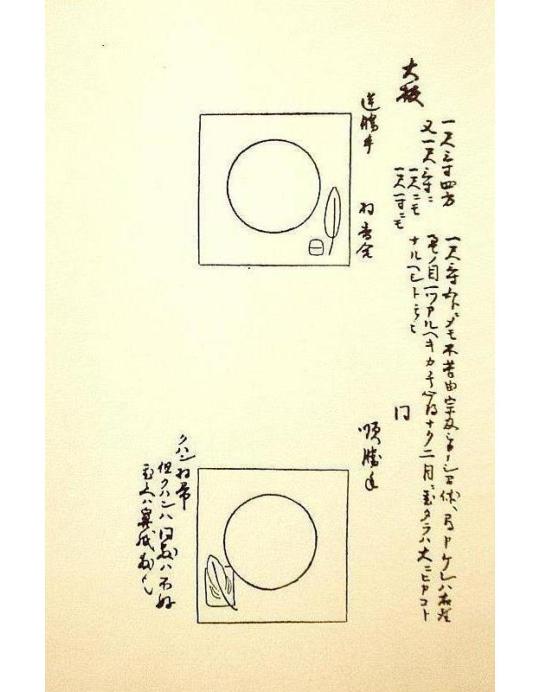
[The writing reads: (to the right of the upper sketch) ō-ita (大板)¹; isshaku san-sun shi-hō (一尺三寸四方)², mata isshaku san-sun ni isshaku ni mo ・ isshaku issun ni mo (又一尺三寸ニ 一尺ニモ ・ 一尺一寸ニモ)³; gyaku-gatte (逆勝手)⁴; (to the right of the lower sketch) isshaku san-sun go-bu ni shite mo kurushikarazu yo, Sōkyū kakete mōshi-soro aida, [Ri]kyū [h]e tazune mōshi-kereba, migi-za tatami no me hitotsu aru-beki ga, sono kokoro-e naku ni-me ni oki-tara ba, ōi ni higa-goto naru-beshi to iu-iu [一尺三寸五分ニシテモ不苦由、宗及被申シ間、休ヘ尋申ケレハ、右座疊ノ目一ツアルヘキカ、其心得ナク 二目ニ置タラハ、大ニヒカコトナルヘシト云〻)⁵; onaji (同)⁶, jun-gatte (順勝手)⁷; (to the left of the lower sketch) kan・habōki (カハン ・ 羽帚)⁸; tadashi kan ha onaji shiki ha mazui, oku-sore ba, hana-kami shiki nari (但クハンハ同敷ハ不好、置候ヘハ、鼻紙敷也)⁹.
_________________________
◎ This, and the following, pair of installments constitute another “mini-densho” (shown, intact, below) probably also written by Jōō. Which is to say that the sketches were drawn by him, and in the specific order in which they appear in Book Three of the Nampō Roku. The kaki-ire [書入] were, of course, added by other hands, and not necessarily those intent on representing Jōō’s authentic teachings, with regard to this shiki-ita.
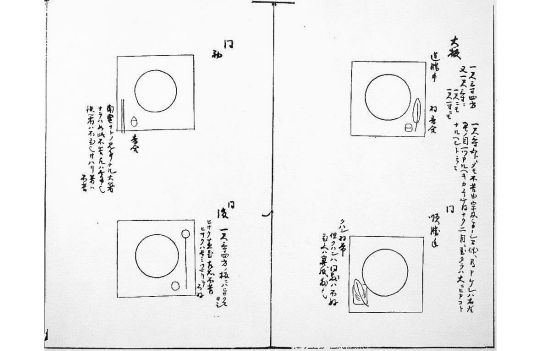
Both Shibayama Fugen and Tanaka Senshō deal with all four sketches (two on each page) as a unit, but the length of the footnotes and commentary preclude my following their format here. Tanaka, in particular, limits his own comments to a rather brief summary at the end of this section, leaving the kaki-ire to stand without any attempt at interpretation or explanation at all.
¹Ō-ita [大板].
According to Rikyū's account, the ō-ita was created by Jōō, as a temporary base for the small bronze kimen-buro (this furo is usually around 8-sun in diameter) when it was taken off of the small shin-daisu for the sumi-temae. At that point in time, the daisu, decorated with the rest of the kaigu (and the temmoku and chaire on the ten-ita), was displayed in the tokonoma during the shoza, while the furo was placed (in this case, on the ō-ita) on the utensil mat, where the host performed the sumi-temae. This helped to prevent damage to the daisu caused by charcoal dust and sparks. The daisu was moved to the utensil mat during the naka-dachi, and the furo (with the now-boiling kama) was lifted up onto it at this time*.
The ō-ita was originally placed on the left side of the utensil mat (irrespective of the actual orientation of the tearoom), since that was the side of the mat that the furo would occupy when restored to the daisu during the naka-dachi. (The sumi-temae was performed much as if the daisu were actually present on the utensil mat.)
Later, as Jōō's inclination toward wabi deepened, he put the daisu and the rest of the kaigu away, and left the small furo on the ō-ita for the duration of the chakai -- with the mizusashi placed directly on the mat at its side.
The size of the ō-ita was derived from that of the small daisu. The 1-shaku 3-sun square represented the space occupied by the small furo on that daisu. The original ō-ita, however, seems to have been made from the ten-ita of an old large daisu -- since this kind of daisu would have been much more common†.
In Rikyū's densho he wrote that the ō-ita should be placed 5-me (2-sun 5-bu) from the heri, and either 9-me (= 4-sun 5-bu) or 11-me (= 5-sun 5-bu) from the far end of the mat‡; and, according to his kaiki, it seems that the ō-ita was being placed on the side of the utensil mat closest to the guests’ by the 1580s**. __________ *This idea basically imitated the Shino family's practice: the Shino-dana [志野棚] (which was basically a fukuro-dana that had a pair of hinged doors enclosing the ji-fukuro: the doors had a locking mechanism that kept the guests from looking at the host’s collection of kyara incense that was stored in the ji-fukuro) and other incense implements were arranged on the utensil mat during the shoza. Afterward, during the naka-dachi, the tana was lifted into the tokonoma, and a daisu, kaigu, and furo (with charcoal and a boiling kama already arranged in it) were brought out from the katte and placed on the utensil mat.
†Though there are certain indications that the inakama setting had already been used on the continent, the small shin-daisu only appeared (in Japan) when Jōō began to use a 4.5-mat inakama as his tearoom. Consequently, there were no ten-ita from “old and damaged” daisu of this sort that could be recycled as shiki-ita.
Since the ten-ita of both sizes of daisu have rounded edges, it would be impossible to cut an ō-ita measuring 1-shaku 3-sun square (with the perfectly perpendicular edges seen on all shiki-ita) from the ten-ita of a small daisu. The other sizes mentioned -- 1-shaku 3-sun by 1-shaku or 1-shaku 1-sun -- could have been cut from the ten-ita of a small daisu, and it seems likely that there would have been a number of these available by the early Edo period (since the preference had briefly shifted back to the kyōma 4.5-mat room during Hideyoshi’s lifetime -- though when the capital was removed to Tōkyō, the inakama room returned to favor as a consequence of the lack of space in the cramped quarters of that city). These smaller versions of the ō-ita were made by machi-shū chajin years after Jōō's death.
With the advent of the inakama setting, the kyōma fell out of fashion with many of the machi-shū chajin of Sakai and (to a lesser extent) Hakata, hence the ready availability of ten-ita from old daisu that had been originally made for use in that setting.
‡In the Nambō-ate no densho [南坊宛の傳書], this entry (which is the first to be discussed in the document) reads ō-ita no koto, hidari no waki tatami no me go-me, saki kyū me ・ jū-ichi me, dai-jō to tsune-no-datami to nari [大板之事、左のわき疊の目五目、先九目 ・ 十一目、大疊と常の疊と也]. This means “concerning the ō-ita: on the left side, 5-me; and in front [of the ita], 9-me ・ 11-me -- [depending on] whether it is a large mat or an ordinary-sized mat.” These arrangements are shown below, drawn to the same scale (with the kyōma tatami shown on the left, and the inakama -- the “ordinary tatami” -- on the right): in both sketches, the katte is assumed to be on the host's left.

When Rikyū wrote the he was still operating fully within the limitations imposed by Jōō’s teachings. Thus, though Rikyū does not cite a source for this teaching, it is most likely that this represented the way that Jōō arranged the ō-ita on the utensil mat.
At this point in time, the inakama tatami was still commonly used (for the 4.5-mat room), which is why Rikyū refers to it as the “ordinary mat;” and, under the influence of Nobunaga, the orientation where the katte is located on the host's left was coming to be preferred. (This densho, which is the earliest of Rikyū's writings to survive, was apparently the second such to be addressed to Nambō Sōkei, and Rikyū appears intent on guiding Sōkei in the most socially acceptable -- and least dangerous -- way of doing things possible.)
**Since the furo cannot be located underneath the tsuri-dana (which, in his room, was a Shū-un-an dana, meaning a tsuri-dana attached to the wall on the left side of the utensil mat), the only possibility was if the ō-ita was placed on the right side of the mat, near that heri.
²Isshaku san-sun shi-hō [一尺三寸四方].
This, as mentioned above was the size of the original ō-ita that was made by Jōō. While made as a base for the small bronze kimen-buro, and derived from the size of the small shin-daisu, the actual ō-ita seems to have been cut from the ten-ita of an old large daisu.
³Mata isshaku san-sun ni isshaku ni mo ・ isshaku issun ni mo [又一尺三寸ニ 一尺ニモ ・ 一尺一寸ニモ].
These smaller ō-ita, as mentioned above, could have been cut from the ten-ita of an old small shin-daisu (which would have been available for this purpose in the early Edo period, as a result of the return to the kyōma 4.5-mat room, and the preponderance of wabi-no-chanoyu, which made all daisu superfluous*).
Ita of these sizes were made by the machi-shū, and had nothing to do with either Jōō or Rikyū. ___________ *The daisu ultimately made a return in the Edo period, under the theory that receiving guests of different social ranks demanded different forms of chanoyu service.
⁴Gyaku-gatte [逆勝手].
Gyaku-gatte [逆勝手] is usually translated (and presently understood to mean) “reversed” katte -- that is, the katte is found on the opposite of the room from that seen in the original orientation. As used in the present entry, this arrangement is shown below (note that the katte is located on the right side of the utensil mat).
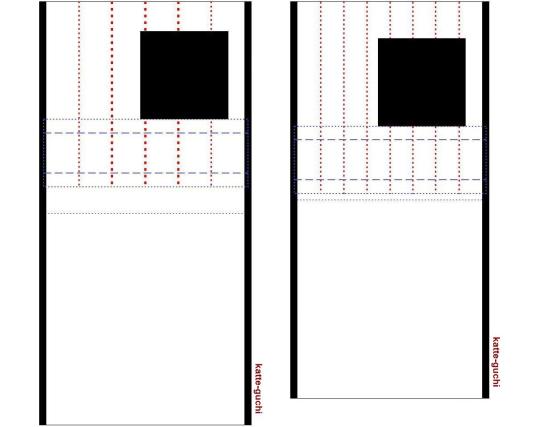
However, the kanji that is read gyaku [逆] actually has a more sinister meaning -- to disobey, to rebel -- and this sense of the word likely stands in the background of the question of why what was originally the hon-gatte [本勝手] (the arrangement where the katte is located on the host's right, with the guests seated on his left -- as seen in the Dōjin-sai [同仁齋] and other classical shoin-style tearooms) suddenly became the “reverse” (or “traitorous”) setting. The idea seems to have arisen with Nobunaga, because arranging the room with the guests seated on the host's left means that the guests will be unable to see what the host is doing*. From this arose the bad feelings that persist over what was the original way to arrange the room in which chanoyu was to be performed‡.
It might strike the modern reader as rather odd that the “reversed” position is reviewed first, while the jun-gatte [順勝手]** is considered second. But this was likely because Tachibana Jitsuzan simply copied the sketches in the order that they were found in the original document -- which, in the source documents, appear to consistently present the material in its proper historical sequence -- with the terms “gyaku-gatte” and “jun-gatte” added later, to reflect the Edo period norms that were descended from Hideyoshi's edicts. __________ *Most of the early chajin (including Jōō and Rikyū, and their principal disciples -- both Japanese and Korean) were, at least nominally, affiliated with the Ikkō-shū [一向宗] -- the dangerous religious movement that held that all men, regardless of their social position or birth, were completely equal after a single repetition of the nen-butsu [念佛] (the incantation “namu Amida-butsu” [南無阿彌陀佛]). This is the source of the so called “democracy in the tearoom” of which many writers have made note.
It appears that the social revolution that brought down the Koryeo dynasty in Korea was championed by followers of this sect, hence the unease with which Nobunaga, and then Hideyoshi, viewed its adherents. It was also because of this that, while interacting with these people was increasingly necessary (since their ranks included the leaders of the machi-shū of Sakai and Hakata, whose cooperation was absolutely necessary for the success of their respective plans), neither Nobunaga, nor Hideyoshi, ever completely trusted their tea masters. (Rikyū's being invited to take a second wife -- a trusted woman out of Hideyoshi's own harem, who then acted as Hideyoshi's spy in the deepest recesses of Rikyū's home -- once he became a member of Hideyoshi's household, clearly shows how far Hideyoshi was prepared to trust this “most trusted” adviser.)
‡The original orientation, with the daisu on the right, and the chief guest on his left, was derived from the arrangement of the altar in the temples where chanoyu arose: the Buddha is seated in the middle, with the image of Yakushi nyorai [藥師如来] (the “Buddha” of Healing -- who was the patron of both the tea plant, and the practice of preparing and serving tea) seated on his left hand. The daisu was set up in front of the statue of Yakushi, and the bowl of tea was placed out on the host's left, where an assistant received it and carried it directly forward, so it could be placed at the foot of the Buddha. In no temple arrangement was this ever reversed; and it was based on this precedent that the original shoin where tea would be served were laid out.
**Jun-gatte [順勝手]: jun [順] is the literal opposite of gyaku [逆], and means to obey, to submit to, to go along with, and so forth. In other words, this orientation -- with the katte on the left, and the guests seated on the host's right, was a physical manifestation of the chajin’s submission to Nobunaga's, and then Hideyoshi's, will.
⁵Isshaku san-sun go-bu ni shite mo kurushikarazu yo, Sōkyū kakete mōshi-soro aida, [Ri]kyū [h]e tazune mōshi-kereba, migi-za tatami no me hitotsu aru-beki ga, sono kokoro-e naku ni-me ni oki-tara ba, ōi ni higa-goto naru-beshi to iu-iu [一尺三寸五分ニシテモ不苦由、宗及被申シ間、休ヘ尋申ケレハ、右座疊ノ目一ツアルヘキカ、其心得ナク二目ニ置タラハ、大ニヒカコトナルヘシト云〻].
This statement is not entirely lucid (and the several versions differ from one another in terms of both wording and punctuation, resulting in no good consensus as to what the actual text should be)*.
Translating it as the text is given in the Enkaku-ji version of Book Three of the Nampō Roku, the meaning is “on a certain occasion, Sōkyū volunteered that there would be no difficulty if the ō-ita measures 1-shaku 3-sun 5-bu [square†]. When [I‡] placed this matter before [Ri]kyū, he speculated that this would mean either that, on the right-seat of the mat, there would have to be but a single me -- something unsupported by the authority of any of the [associated] practices**; or, if 2-me, this would result in a gross violation [of the rules††], so it has been said.” ___________ *In fact, since it deviates from Rikyū’s own words regarding how the ō-ita should be oriented on the utensil mat (the original text was quoted above under footnote 1, sub-note “‡”), this kaki-ire may well be spurious -- since it offers oblique support for the machi-shū way of doing things.
†This is a guess. For all we know, Sōkyū could have been referring to another rectangular board, like the two alternative versions mentioned to the right of the upper sketch. All that we can be sure of is that this board measured 1-shaku 3-sun 5-bu from side to side.
‡Probably Nambō Sōkei is the intended speaker.
Since the original sketches were probably drawn by Jōō himself, there is little reason why Sōkei would have interpolated comments such as this -- since they were irrelevant to the classical way of doing things. Since placing the ō-ita 2-me from the heri was the machi-shū way of arranging it on the utensil mat -- based on the argument that the “seat of the furo” on the kyōma tatami extends 1-shaku 4-sun from the heri, thus the ō-ita (which measures 1-shaku 3-sun from side to side) should be placed 1-sun (= 2-me) from the heri, so that the other side does not extend beyond 1-shaku 4-sun from the heri. (In an inakama room, the ō-ita would be placed against the heri, since in that setting the seat of the furo extends only 1-shaku 3-sun from the heri.) This machi-shū argument is elaborated upon in Book Six of the Nampō Roku.
The point of all this was to reinforce the idea that Sōkei was the author of this collection of Rikyū’s teachings. In fact, the material in Book Three originated primarily with Jōō (and the fact that Rikyū apparently discarded this densho when he relocated his Sakai household to Mozuno -- this was how it came into Sōkei’s hands -- suggests that he had long since left Jōō’s teachings behind).
**The “practices” associated with the ō-ita to which reference is being made here are, according to Shibayama Fugen, that the ita is placed immediately adjacent to the heri when arranged on an inakama tatami, and 2-me from the heri when it is placed out on a kyōma tatami. The argument suggests that it may be one of these, or it may be the other, but not otherwise.
Note that this deviates from Rikyū’s own explanation regarding how the ō-ita should be oriented on a utensil mat of either size.
††If placed 2-me from the heri, the ō-ita will extend 5-bu beyond the edge of the “seat of the furo” -- which, according to this argument, is a gross violation of propriety. Rikyū, in other words, does not seem very impressed with Sōkyū’s pronouncement (which he apparently offered to his interlocutors without incitement).
That the ō-ita, when arranged as Rikyū said, extends 1-sun 5-bu beyond this supposed limit suggests that this statement had nothing to do with him. (In fact, Rikyū’s ō-ita extends beyond the middle of the mat to the same degree that the ko-ita [小板] falls short of the middle -- 3-me in both cases.)
⁶Onaji [同].
“The same.” The second sketch also depicts the ō-ita.
⁷Jun-gatte [順勝手].
In the present context, this refers to a room that is oriented so that the katte is located on the host’s left, and the guests are on his right, when he is seated on the utensil mat.
The term jun-gatte seems to have first appeared in the Edo period.
⁸Kan ・ habōki [カハン ・ 羽帚].
The lower sketch shows the kan [鐶]* arranged together with the habōki on the ō-ita.
The idea (in both this sketch, and the one above) is that the charcoal utensils should be placed on the side of the ō-ita away from the guests’ seats. ___________ *K’wan [カワン] -- or possibly kwan [カヮン] (with the rendering changed when it was copied) -- was an archaic phonetic rendering. The kanji is rather complicated, and the clarity of the phonetic representation of the name makes it unnecessary to recall the kanji.
⁹Tadashi kan ha onaji-shiki ha mazui, oku-sore ba, hana-gami shiki nari [但クハンハ同敷ハ不好、置候ヘハ、鼻紙敷也].
“However, if one dislikes placing out the kan [directly on the ō-ita] in this way, when [one] is going to put them down, they may be placed with [a piece of] hana-gami underneath.”
The word hana-gami [鼻紙] -- nose[-wiping] paper -- refers to what we call kaishi [懷紙] today. Rikyū’s kaishi was the size of what is sold as women’s kaishi, though made from much thinner paper (more like tissue-paper); and, when used as suggested here, one piece would have probably been cut into a (doubled) square.
Originally the rule was that only bronze kan could be displayed on the ō-ita, never kan made of iron. Whether the host’s unease over placing the kan directly on the ō-ita stems from the lapse of this rule*, or whether this is simply apprehension that even bronze kan might damage the ō-ita†, is not clear from the context.
Tanaka Senshō, however, provides us with an interesting insight, arguing that the piece of paper here is analogous to that placed under the shin-nakatsugi (when it is displayed, without a shifuku, on the fukuro-dana): namely, that the paper allows the kan to contact the kane even when, by themselves, they are too small to do so. According to this way of looking at the matter, the determining factor is the size of the kan (rather than any question about what they are made of), and whether or not the host wishes the kan to contact the kane‡. ___________ *In other words, unease with placing iron kan directly on the ō-ita -- iron kan being much more likely to damage the lacquer than polished bronze.
†Though this does not really accord with Edo period sensibilities. Great concern over damaging something like a shiki-ita would be more appropriate in the early days -- when these boards were made from the ten-ita of antique daisu (and so were handled as if they were relics of a bye-gone day). In the Edo period, shiki-ita were being mass-produced (to keep up with the burgeoning demand caused by a rather sudden increase in the number of people practicing chanoyu), using previously unused wood (though generally still wood that was rather old, so it would be dried out to the point that it would not easily warp).
‡Because the ō-ita was created for the inakama setting, and because it is less than half of the width of the mat, it is divided by three yang-kane (the seven-kane system does not recognize yin-kane in any case). Naturally depending on their size, the kan would possibly sit between the left-most of the three kane and the left edge of the ita (according to the way this sketch is oriented). By placing the pair of kan (stacked one on top of the other) on top of a piece of paper (Rikyū‘s kaishi, when folded in half as is usual, measure 2-sun 9-bu by 4-sun 8-bu, and one supposes that the surplus length would be cut away, leaving a 2-sun 9-bu square), the paper will overlap the kane slightly to the right of the kan, thereby associating the kan with the kane -- if that is what the host wishes.
==============================================
◎ As mentioned above, both of these sketches show the ō-ita arranged for the shoza.
I. The first arrangement -- in a room with the gyaku-gatte [逆勝手] orientation.

The first sketch is confusing, since it shows the gyaku-gatte [逆勝手] arrangement*. In this case, the guests are seated on the left, while the katte is on the right. Below is a drawing of a gyaku-gatte yojō-han tearoom.

The utensil mat in such a room is shown in greater detail below. (Note that the left sketch shows a kyōma tatami, while that on the right is of an inakama tatami.) In either case, the ō-ita employs the same system of kane, which is derived from the original inakama setting for which this ita was created.
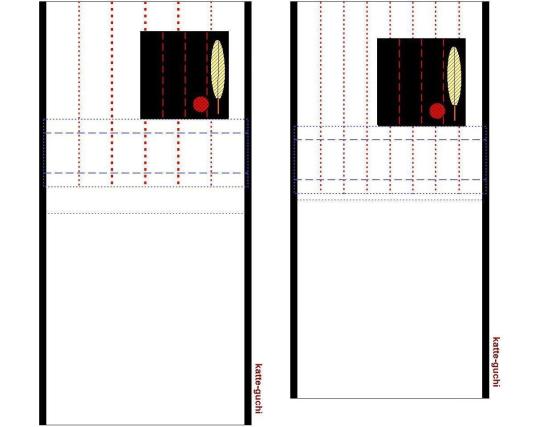
The next pair of sketches show the same arrangement in a jun-gatte [順勝手] setting -- a room where the katte is on the left, and the guests sit on the host’s right side.

And, finally, the same arrangement in a jun-gatte room where the ō-ita has been placed on the right side of the utensil mat. It is this kind of arrangement that was being used by Rikyū during the 1580s.
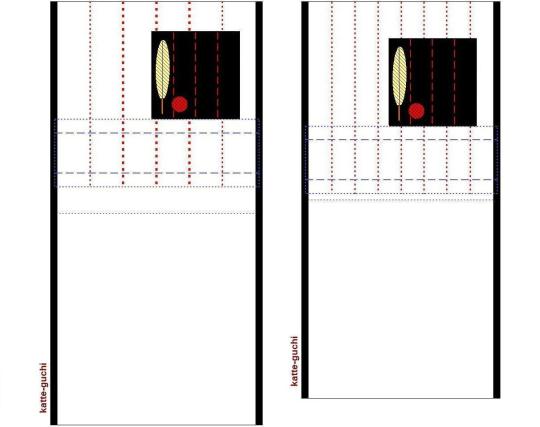
Note that, irrespective of where the ō-ita is positioned on the utensil mat, the kōgō and habōki are always found on the side of the board closest to the katte, according to this document. ___________ *Interestingly, in Rikyū’s Nambō-ate no densho [南坊宛の傳書], his sketch for the ō-ita is identical to the one shown here -- perhaps reflecting the fact that it was for this setting (where the katte is on the host’s right) that Jōō originally created the ō-ita.
——————————————–———-—————————————————
II. The second arrangement -- in a room that has a jun-gatte [順勝手] orientation.
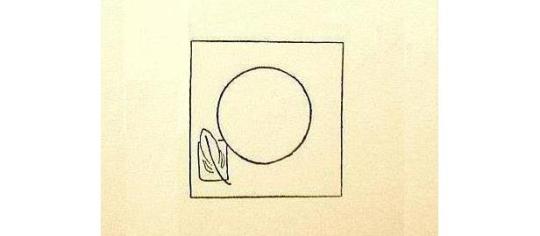
The second sketch shows the jun-gatte [順勝手] arrangement -- where the katte is on the left, and the guests seated on the right side of the utensil mat. Below is a sketch of a jun-gatte yojō-han.

The utensil mat depicted above is shown below in greater detail. Once again, a kyōma tatami has been drawn on the left, while the right sketch shows an inakama mat.
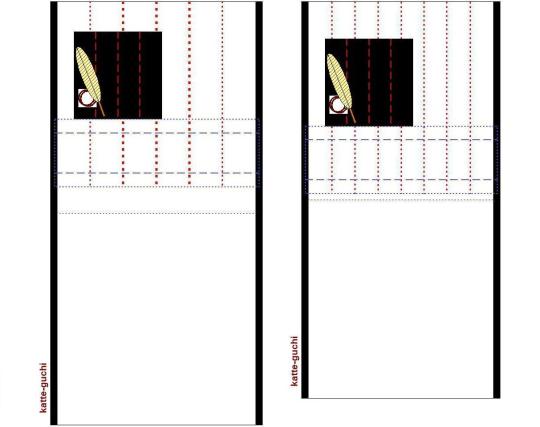
Here the same arrangement is shown in a gyaku-gatte room (a room where the katte is on the right).
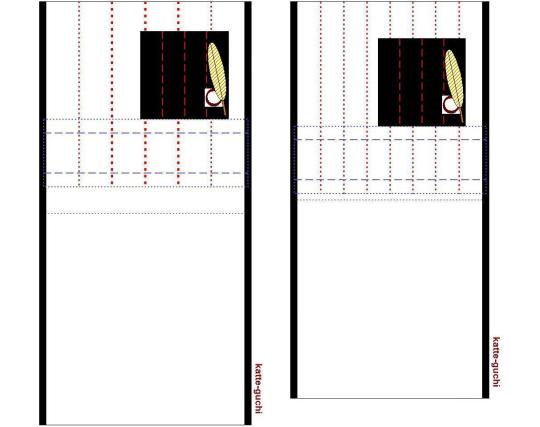
And, in a jun-gatte room, where the ō-ita has been placed on the right side of the utensil mat.

Once again, and irrespective of the orientation of the room or the location of the ō-ita on the utensil mat, the kan and habōki are always located on the side of the ō-ita closest to the katte. This is the rule that the reader was expected to deduce from these illustrations.
2 notes
·
View notes
Text
Nampō Roku, Book 3 (18.1): Fukuro-dana, Two Arrangements for the Shoza.

18.1) Fukuro-dana: two arrangements for the shoza¹.
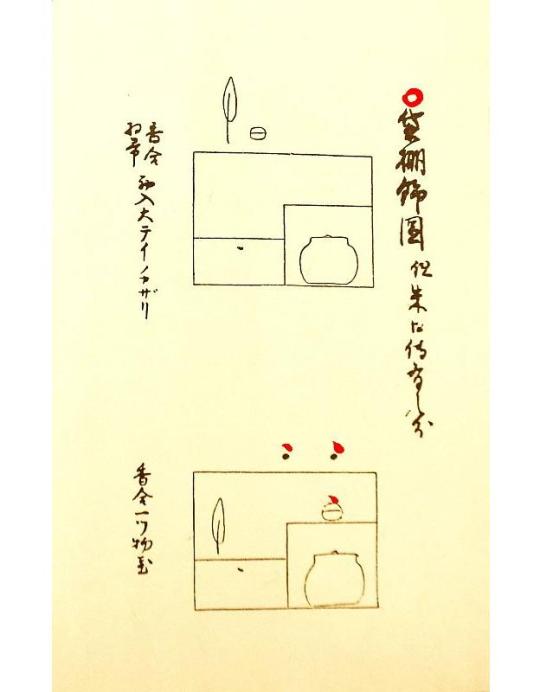
[The writing on the sketch reads: (on the right) ◎ Fukuro-dana kazari zu tadashi shu ﹆ ku-den kore-ari bun (袋棚飾圖 但朱﹆口傳有之分)²; (on the left, with reference to the upper sketch) kōgō habōki hatsu-iri dai-tei no kazari (香合 羽帚 初入大テイノカザリ)³; (and on the left, referring to the lower sketch) kōgō hitotsu-mono oki (香合一ツ物置)⁴.]
_________________________
¹I have added this title, which briefly describes the two sketches found on the page. As I mentioned before, each page contains two sketches, which may or may not be sequential (in this case, they illustrate parallel cases showing the way that the objects may be arranged on the fukuro-dana when the guests enter the room for the shoza).
Such titles will be added to each of the sections, for the purpose of making them easier to index; and, in the future, this will be done without notice.
²◎ Fukuro-dana kazari zu tadashi shu ﹆ ku-den kore-ari bun [袋棚飾圖 但朱 ﹆ 口傳有之分].
The (red) circle ( “◎”) indicates that this is a new and independent entry (rather than part of, or directly related to, the previous entry -- which dealt with the question of whether the guests should move on to the shoin, or another room, for usucha and sweets, or a formal banquet, after the service of tea in the small room has been concluded).
Fukuro-dana kazari zu [袋棚飾圖] means “sketches of the arrangements for the fukuro-dana”; and tadashi shu ﹆ ku-den kore-ari bun [但朱﹆口傳有之分], means “however, the red ‘﹆’ marks indicate secret teachings that should only be transmitted orally*.” The first statement is written† in such a way that it should be understood to be the title of this part of the book (the entire collection of sketches was included in a single entry‡.)
The reader will notice that I have restored the red color to the sketches, so that they more closely resemble those found in the original.
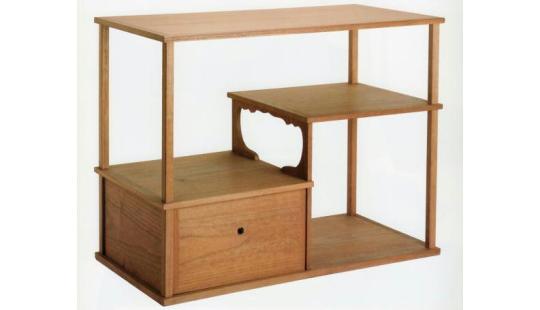
The fukuro-dana [袋棚], as has been mentioned before, was created by Jōō, albeit derived from a very similar tana that had traditionally been used by the Shino family during their incense-appreciation gatherings**. ___________ *Tanaka Senshō, however, suggests that the expression ku-den [口傳] was used in the sense of “things told (to Nambō Sōkei) by Rikyū” (and so the purpose of the red marks was simply to recollect to Sōkei of these pieces of information) -- rather than implying that the information was (necessarily) part of a secret corpus of orally transmitted teachings (this being the usual sense when the expression is found in the old writings): we must remember that Sōkei was annotating these documents for his own edification, without any intention of disseminating this material to others. More will be said on this later.
†In Shibayama Fugen’s commentary, the title (Fukuro-dana kazari zu [袋棚飾圖]), along with the statement on annotation that follows, are handled as a separate entry, apart from the sketches which follow; and he says nothing about how the page was formatted in the manuscript to which he had recourse.
Tanaka Senshō includes a discussion of the title line, and statement on annotation, together with his comments on the first sketch.
As was mentioned previously, Tanaka Senshō consulted several different (and, apparently, unrelated) manuscripts. In three of those, the formatting is identical to what is seen above -- the title, followed by the comment regarding the red marks, clearly extends beyond the lower edge of the first drawing (indicating that it is, indeed, the title for this part of the book -- and that, in the original, two sketches were found on each page of Jōō’s manuscript). In one of the manuscripts, however, the length of this line has been shortened so that the entire text extends no farther than the lower edge of the first sketch. Tanaka then devotes almost a full page of his commentary to a discussion of the significance which the two styles of formatting suggest.
Tanaka Senshō does not seem to have considered that the formatting of any version drafted, from memory, by someone who had not actually seen the way the original documents were done is, in fact, irrelevant. The formatting used in his teihon matches that of the Enkaku-ji manuscript, suggesting that both were done deliberately. (This is also true with regard to the sketches themselves: Tanaka Senshō also includes the sketches from his other sources, even though these almost always deviate from the sketches drawn by Tachibana Jitsuzan -- often markedly so -- implying, rather than “variations,” that the people responsible for these other sketches inadvertently distorted the material before they had the chance to set it down on paper, meaning that such illustrations have no real validity. Jitsuzan’s sketches always conform with each other and, as has been pointed out above, he was the only one who made sketches with the original documents spread out in front of him. As a result, I think it is best not to go into these other sketches here, since they will only serve to confuse the reader.)
‡The entries are not numbered in the original (I added the numbers to make referencing the different sections less confusing). However, they are indicated -- by a circle “◎” -- so that each entry’s contents remain clearly distinct from each other. A circle of this type is seen at the beginning of the two statements that are taken to be the title of this part of the book, but no further circles like this are encountered in the remainder of the material. Thus, (apparently) according to Tachibana Jitsuzan, this collection of sketches constitutes a single entry.
**The Shino-dana [志野棚] was created by the first (or possibly second) generation of the Shino family (in Japan), Shino Sōshin [志野宗信; c 1406 ~ 1490, or 1441 ~ 1522]. The father and son (both of whom used the same name -- though the son probably only assumed it following his father’s death) emigrated from Korea at the beginning of the second half of the fifteenth century.
The only real difference between the Shino-dana and Jōō‘s version was that Jōō replaced the pair of hinged doors (provided with a locking mechanism) with a single, lift-out door, to close the ji-fukuro. While the Shino family stored their collection of precious kyara [伽羅] incense in the ji-fukuro (meaning that it was off-limits to the guests), Jōō used the ji-fukuro as a place to cache those utensils that he did not want to include in the kane-wari count (though he did encourage his guests to open the ji-fukuro, and glance at the objects that had been placed therein -- so that the host’s temae would not cause any surprises). Both the Shino-dana and Jōō’s fukuro-dana came in a lacquered and an unpainted version -- though it is the kiri-kiji [桐木地] versions of both tana that are best known today.
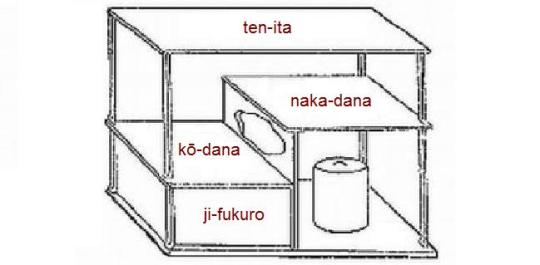
The parts of the fukuro-dana are named in the above sketch. And, according to Shibayama Fugen, the dimensions of the fukuro-dana are as follows (the translations have been written on the sketch in the same manner as in Shibayama Fugen’s original -- which, like all his sketches, was redrawn for publication):
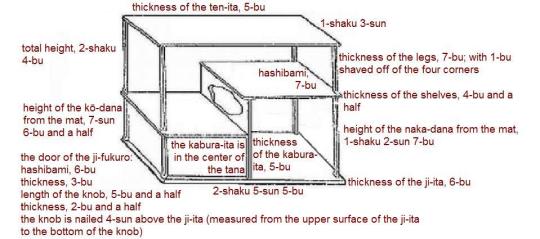
The ten-ita and ji-ita both measure 2-shaku 5-sun 5-bu by 1-shaku 3-sun., while the tana stands a total of 2-shaku 4-bu high. The kabura-ita [蕪板] is the upright board that forms the right side of the ji-fukuro, and supports the naka-dana (and in which the kōzama-sukashi [格狹間透] is cut between the kō-dana and the naka-dana).

Hashibami [端食み] -- the word literally means a bite taken out of the edge -- refers to pieces of wood inserted onto semi-triangular cuts at each end of a shelf (as can be seen on the right and left in the above sketch), with the grain perpendicular to the grain of the rest of the shelf, the purpose of which is to help prevent warping. Hashibami were also attached to the left and right sides of the door panel that closes the ji-fukuro, for the same purpose (a warped door might be difficult to open, or close; or, at the very least, would make a loud sound when it was being handled).
³Kōgō habōki hatsu-iri dai-tei no kazari [香合 羽帚 初入大テイノカザリ]*.
Kōgō habōki [香合 羽帚] name the two objects of concern here -- the kōgō and the habōki (which are arranged on the ten-ita of the fukuro-dana†).
Hatsu-iri dai-tei no kazari [初入大テイノカザリ] seems to mean “the usual way‡ things are displayed the first time (the guests) enter the room.” ___________ *In Shibayama Fugen’s teihon [底本] (source book), the names kōgō and habōki are written above the objects in the sketch.
While Tanaka Senshō’s teihon (which was the manuscript that Tachibana Jitsuzan made with the Shū-un-an documents spread out in front of him) is as shown (the sketches that I will use throughout this section come from that source, since the only real difference is the degree of care used when executing the sketches: the original copy was taken quickly, while Jitsuzan spared no effort when preparing the presentation copy), in two of the other manuscripts these words are written above the ten-ita, but to the left of the sketches of the utensils that they name; and in the fourth manuscript, the names were omitted entirely (that sketch is sufficiently detailed that the names are not necessary -- though this is also true of the sketches in which the names were included).
Even when notations are found in the Enkaku-ji manuscript that seem to be supported by their presence in Jitsuzan’s original copy, this does not necessarily mean that they were part of the original documents. According to what Kanshū oshō-sama told me, it is almost certain that things have been surreptitiously added to the Enkaku-ji manuscript; and, once there, it would be incumbent on the family of Jitsuzan to add them to his other manuscript as well (so as to preserve the authenticity between the two).
†While most contemporary schools say that it is a rule that tea utensils must never be placed on the ten-ita of the fukuro-dana, this rule (which appears to be based on Rikyū’s own preferences that began to be expressed during the last decade of his life) did not exist at the time when Jōō wrote this book.
When Jōō began to use the fukuro-dana, it represented the first departure from the tea of the daisu. And his arrangements were all clearly based on, and mostly derived (often directly) from, those earlier conventions. Consequently, it would only have been remarkable (to his contemporaries) if he chosen not to place tea-related objects on the ten-ita -- and, in the case of a number of his kazari (which employ the large trays that were originally considered indispensable when tea was served using the daisu), there would be no other way to realize them if the ten-ita was eliminated from consideration.
‡While there are a number of ways that dai-tei [大テイ] could be interpreted, Shibayama Fugen narrows the list down to two possibilities:
- daitei [大抵], meaning “for the most part,” “commonly,” “ordinarily,” and things of that sort. In other words, “‘as a rule’ this is how the fukuro-dana would be arranged the first time (the guests) enter (the tearoom);”
- the kanji “大躰,” which is usually pronounced dai-tai (rather than dai-tei), means things like “generally,” but also “from the start.” That is, “‘from the start’ (the fukuro-dana) would be arranged (as shown) when (the guests) first entered (the tearoom).”
Shibayama Fugen also notes that the parallel case (where common utensils are arranged on the daisu) is termed jōtai-kazari [常躰飾] in Book Five. Jōtai-kazari means “the regular (or ordinary) way of displaying objects” on the daisu (this was the closest approach to something like wabi-chanoyu that was available in the early days). His implication is that perhaps the text of this entry may have become corrupted as a consequence of deterioration in the source material.
While Tanaka Senshō does not bother to analyze the language, he nevertheless interprets the phrase hatsu-iri dai-tei no kazari as suggesting that “the first time (they) enter, because the sumi-temae will be performed immediately, this kind of arrangement is shown as being the most usual (way to display things on the fukuro-dana).” He follows this by noting that this statement is unnecessary (and so, by implication, was likely added by someone else -- rather than Jōō, Rikyū, or even Nambō Sōkei). Tanaka’s approach seems to be that most (if not all) of the things written on the sketches were added by other hands, and at a later date (possibly even later than Jitsuzan, and so not by him).
⁴Kōgō hitotsu-mono oki [香合一ツ物置].
Hitotsu-mono oki [一ツ物置] is a style of arrangement that is discussed in detail in Book Six of the Nampō Roku. Put simply, it was a way to draw attention to the utensil in question (as if it were displayed in the center of the ten-ita of the daisu), and was almost exclusively used for very special meibutsu utensils when the setting was inherently “more wabi” than one would have expected to be appropriate for the use of such utensils.
The three red spots (one in the center of the ten-ita, one in the center of the right side of the ten-ita, and one in the center of the naka-dana above the drawing of the kōgō) indicate that all of these are possible “hitotsu-mono oki” positions for the kōgō: it was up to the host to decide which would be the most appropriate for his circumstances*.
The associated ku-den [口傳]† will be discussed below, in the commentary associated with the second sketch. ___________ *In the Enkaku-ji manuscript, Jitsuzan did not include the red spot which marked the kōgō that is placed on the naka-dana. In fact, this mark is not strictly necessary, since the kōgō has been rendered realistically in the sketch. Thus, any additional indication that that is one possible spot where a meibutsu kōgō might be displayed is superfluous -- except (as, perhaps, the mark was intended) to remind Nambō Sōkei of Rikyū’s explanation. (The original sketches reproduced in this series came from Jitsuzan’s original copy of the material, which he made with the Shū-un-an documents spread out in front of him. While it appears that he was working under pressure -- his access to the original documents was being strictly limited -- the sketches that he made at that time surely represent our best view of the now-lost original material. I am of two minds regarding whether I should modify these sketches so that they better conform with those in the Enkaku-ji version of the text.)
We must always keep in mind that Sōkei’s notations were intended for his own reference; Jitsuzan, on the other hand, was consciously producing a document intended for study by other people (though perhaps with the expectation that those who were granted access to it would be limited to those chajin who would respect the material -- and accepting of Jitsuzan’s interpretation, and opinions).
†A ku-den [口傳] is a secret teaching, one that was supposed to be transmitted directly from teacher to student only when (in the teacher’s opinion) the student was ready to receive it. The dissemination of the ku-den, even in this manner, was purely at the discretion of the teacher, and not guaranteed by the system.
That said, Tanaka Senshō seems to believe that Nambō Sōkei was using the word “ku-den” less strictly -- to remind himself of something that Rikyū had told him -- rather than as a reference to an “official” ku-den that had been handed down from ancient times.
❖ The material below the double line is not part of the original text of the Nampō Roku. Readers who wish to limit their exposure to the things found in Tachibana Jitsuzan’s manuscripts should stop reading here.
==============================================
◎ With respect to kane-wari, the fukuro-dana, as Jōō‘s creation, partakes of his system of seven kane. When arranged on a kyōma-tatami [京間疊], as shown in my sketches (below), the relationship between these seven kane and the original five kane that are used to subdivide the mat can be seen clearly (the system of five kane was historically derived, in turn, from the shiki-shi [敷き紙]).
As for the interpretation of the arrangements themselves, Shibayama Fugen and Tanaka Senshō not only fail to agree on almost every detail, but generally base their explanations on sketches that differ (often radically) from what is found in the actual Nampō Roku itself (which refers to the two manuscripts created by Tachibana Jitsuzan). Precisely why they chose to do so is not really explained in their commentaries -- though we might speculate that contemporary practices appear to have informed (or overwhelmed) their sense of propriety. (Both men were highly accomplished chajin long before they began their studies of the Nampō Roku.)
While there are two versions of the fukuro-dana (one made for use in a room where the katte is on the host’s right, and the other for the case where it is on his left), the compartment for the mizusashi always has to be located on the side of the tana closest to the ro. Thus, in my sketches, I have shown the ro on the right side of the utensil mat.
It appears that -- like many of the practices that survive from the early days of chanoyu in Japan -- these arrangements were originally conceived for a setting where the katte was located on the host’s right (and the ro cut on his left -- which was the configuration of Jōō’s 4.5-mat room). When the preferred orientation (and the tana) was reversed (this seems to have occurred, at the behest of Hideyoshi, during the 1580s), the objects displayed on the naka-dana and kō-dana were adjusted accordingly (since the location of the two shelves is directly connected with the location of the compartment in which the mizusashi is placed). But the things placed on the ten-ita remained as they had always been (this was also the case with the things arranged on the daisu, and even determined the way that the ko-ita furo was placed on the utensil mat). As a result, whereas the original rule had been that the more precious an object was, the farther it should be placed from the middle of the room, these things were now being placed closer to the place where the guests were sitting (this is illustrated very clearly in the two arrangements that are being considered in this installment: the ordinary kōgō in the first arrangement is located on the left side of the ten-ita, while the highest-ranked meibutsu in the second arrangement has been placed in the middle of the right half of the ten-ita). It may have been for precisely this reason that Rikyū came to prefer not placing any tea utensils on the ten-ita at all -- a convention that has now become widely accepted. Nevertheless, the reader should keep this in mind when studying the arrangements collected together here, so as to avoid confusion.
I. The first sketch.
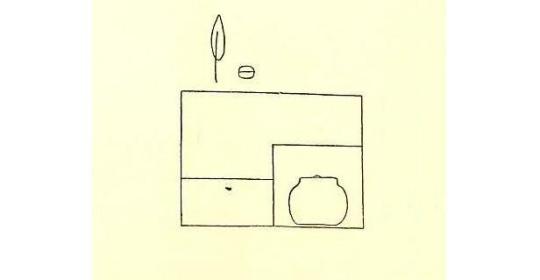
The first arrangement shows the way that an ordinary kōgō is displayed on the fukuro-dana. The arrangement depicted in the sketch is interpreted in the following way:
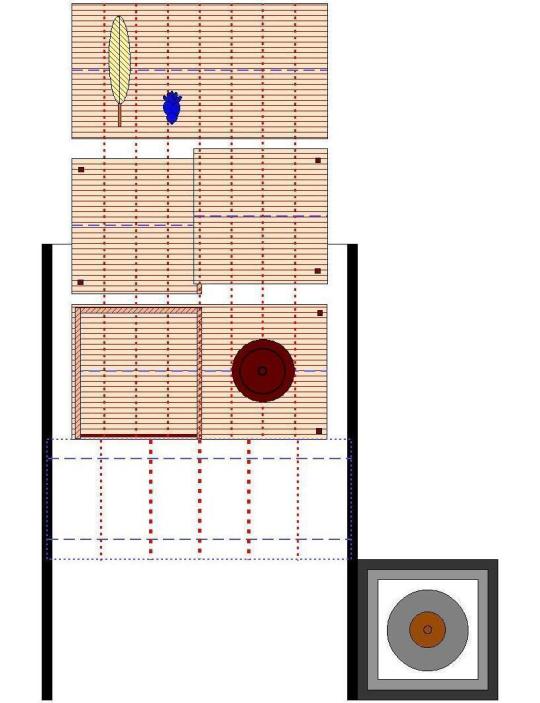
Note that the kōgō is placed so that it is associated with its kane (which many commentators express as “overlapping the kane by one-third” -- actually, the foot of the kōgō is oriented so that it is immediately to one side of the kane), while the habōki is placed between kane (and pointedly not in contact with either). This is because, on ordinary occasions, the shoza is supposed to be chō [調] (“yin”): the kakemono in the toko makes the toko han [半]; the kama in the ro makes the room also han [半]; thus the tana must be chō [調] (the mizusashi rests on a kane and so is han; the kōgō is also associated with a kane, and so is han; while the habōki, which is not associated with a kane, is chō: han + han + chō is chō, both for the tana, and for the za as a whole).
That said, on occasions (such as at night) when the shoza needs to be han [半], then the habōki would be associated with its kane (in other words, placed so that the handle is adjacent to the kane, thus allowing the feather to overlap the kane).
——————————————--———-—————————————————
II. The second sketch.
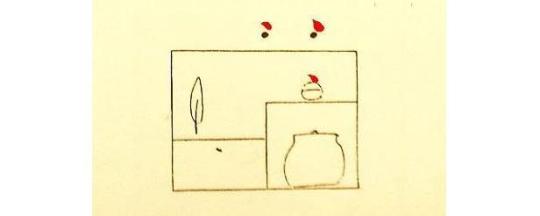
This sketch shows three possible ways to display a meibutsu kōgō as an hitotsu-mono [一ツ物] on the fukuro-dana (while this sketch has a red mark on the kōgō arranged on the naka-dana, the kōgō is unmarked in the Enkaku-ji manuscript* -- though its literal representation in the sketch is sufficient to indicate that it is one of the three locations intended):
◦ first, with the kōgō arranged on the naka-dana (as shown most literally in the sketch);
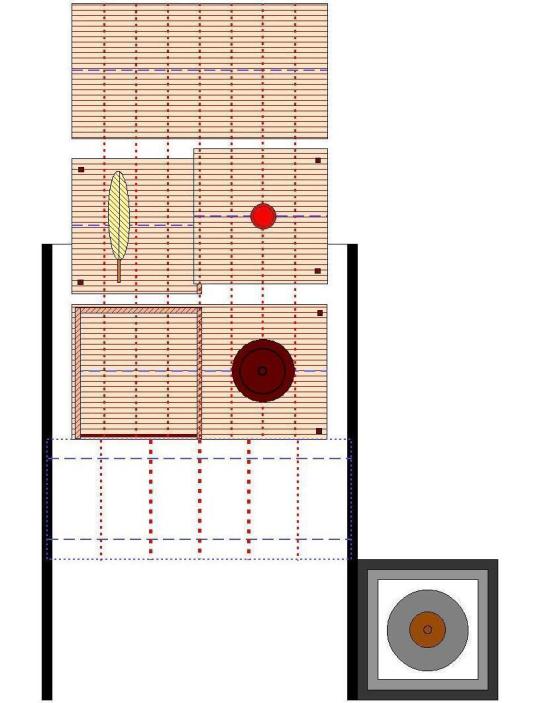
◦ second, placed in the center of the ten-ita (as indicated by the left-most of the two red spots); and,
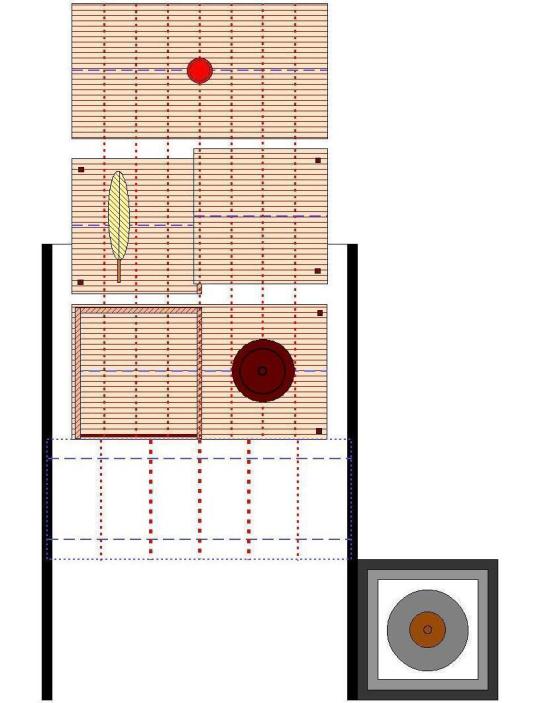
◦ third, placed on the ten-ita, but centered above the naka-dana.
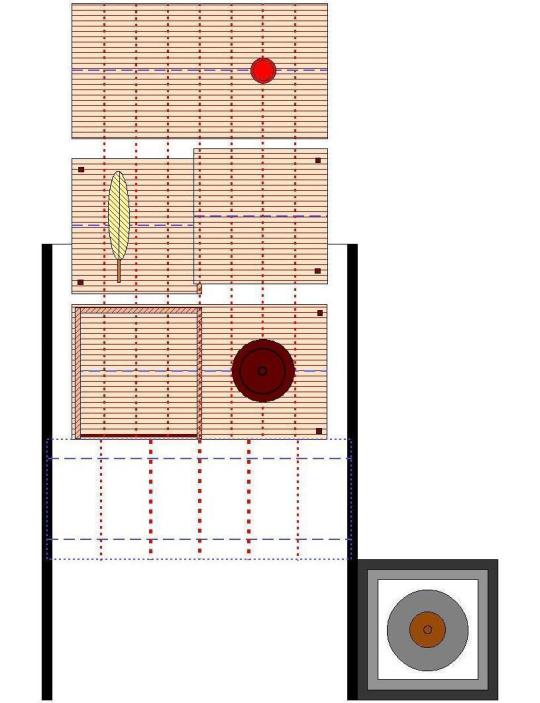
The arrangements used on the smaller-sized tana (such as the Seirō-dana [城樓棚] and Hora-dana [洞棚]) derive from this last version of the kazari.
In all three cases, the meibutsu kōgō is placed squarely on its kane, while the habōki is not associated with a kane (for the same reason that was mentioned in the notes under the first arrangement).
The “ku-den” [口傳] relate to the fact that a kōgō displayed in this manner was supposed to be a meibutsu piece, specifically one of exceptional merit (such as a kōgō that had been owned and treasured by a great chajin of the past -- for example, by Ashikaga Yoshimasa), while also ranking the three possible locations (with the kōgō centered on the right side of the ten-ita being the position of greatest respect†, followed by its being centered on the ten-ita, and then centered on the naka-dana -- which was probably the most common form of the hitotsu-mono arrangement, if only due to an inclination to deprecate ones own possessions, irrespective of their antecedents).
Tanaka Senshō argues that the red spots were added (to what was likely a copy that Sōkei had made of the original manuscript, which was in Rikyū’s archive‡) by Nambō Sōkei, as part of his own private scholarship. If this assessment is correct, then the purpose was to remind himself of things that Rikyū had told him about these arrangements. The same, Tanaka suggests, holds true for many of the words and comments that were written on, and beside, the sketches**. ___________ *As I mentioned above, I am of two minds regarding whether to let these differences stand. Since I am ostensibly using the Enkaku-ji manuscript as my source book, perhaps I should edit these sketches so that they more exactly reflect what is found in that source. Nevertheless, since the sketches in Jitsuzan’s original copy of the material were made, as I have said, with the Shū-un-an documents spread out in front of him, this earlier version of the sketches perhaps more accurately reflects the nature and contents of the original documents, making their contents worthy of preservation.
The question -- and it is one that I cannot really answer -- is whether the Nampō Roku should be perceived as primarily a faithful preservation of the original material, or accepted as a reworking of that material by Tachibana Jitsuzan, intended to fill a specific need (the refutation of Sōtan’s approach to chanoyu) -- a goal which may or may not have been contiguous with Sōkei’s own purposes. Jitsuzan eliminated the third red mark because it was superfluous (since the kōgō is already literally represented on the naka-dana); but (I suspect) Sōkei marked that kōgō with a red spot precisely because the teaching he received from Rikyū was as applicable to it, in that position, as it was to the others (which are solely represented by the red spots marked above the ten-ita). I cannot convince myself that fidelity to the Enkaku-ji manuscript trumps the potential insight which the full collection of marks on the original versions of the sketches provide.
†This may seem counterintuitive, since it locates the most precious kōgō “closest to the fire.” The convention, however, derives from the original arrangement of Jōō’s 4.5-mat room (where the ro was on the host’s left, and the katte on his right), making its being centered on the right side of the ten-ita “more safe” than its being placed in the center of the ten-ita. Other anomalies of this sort will be noted, from time to time, in the remaining sketches -- so the reader is advised to keep the reason in mind.
With respect to “closer to the fire,” this is an anachronistic argument (though it is the one that readers who have studied with one of the modern schools will most likely be familiar). The original idea was related to purity, rather than to danger. The movement of the guests (when taking their seats, or moving around to inspect the objects that the host has arranged in the room) was felt to stir up dust (of which, given the nature of the tatamai mat, the room cannot be made completely free). The rising heat and steam from the kama divides the air in the room into two fractions: that on the side of the guests (the heat lifts the dust raised by the guests’ movements up to the ceiling, and then back toward their seats), and that between the fire and the katte. The cleanest place, therefore, was the position closest to the katte, and it was originally for this reason that the most precious utensils were located on that side of the tana. This will become clearer in Book Five, where the arrangements related to the service of guests of different ranks (or different degrees of relationship to the host) -- things that were out of place in the wabi setting -- will be discussed.
‡It is possible that Rikyū discarded this document, along with most of his other papers, when he moved his Sakai household from Ima-ichi-machi to Mozuno. (What we know of Rikyū suggests that he was not a sentimentalist -- and he had long since moved on, with respect to the way he arranged his utensils on the fukuro-dana, making this material rather useless: as I mentioned before, of the numerous sketches for the fukuro-dana assembled here, only one made its way into Rikyu’s own practice, and his writings on the subject). In this case, Sōkei may have made his notations on the original Jōō document.
**Thus “ku-den” is used in a literal sense to mean something transmitted orally to Sōkei by Rikyū for his own edification, rather than a formal secret that was intended to be passed down from generation to generation. This would explain the lack of any record of many of these “secret” teachings, as is the case here.
As mentioned above, Tanaka Senshō also implies that at least some of these additions may have been entered into the manuscripts at an even later date -- perhaps even after the finished copy of the Nampō Roku had been presented to the Enkaku-ji.
1 note
·
View note
Text
Nampō Roku, Book 3 (15): Regarding the Lamp in the 4.5-mat Room.

15) In the 4.5-mat room, with respect to the matter of the lamp, if [one] is using the daisu [臺子]¹, kyū-dai [及第]², naka-ita [中板]³, or things of that sort, one should use a small candlestick⁴ [for illumination during a night-gathering].
[However,] with the fukuro-dana [袋棚] -- and everything below that [level]⁵ -- a tōdai [燈臺], tankei [短檠], [or] andon [行燈]: [choosing from] among these, as is appropriate [to the circumstances]⁶, so it has been said⁷.
==========================================================
Kaki-ire [書入]:
❖ At a night-gathering during the summer, in order to keep the interior of the tearoom as cool as possible, there is the case where both the shōji [障子] and the sudare [スダレ] are taken away⁸.
So that the lamp will continue burning even if wind gusts in, as well as [to deter] insects and the like from flying into [the room], if one is using a Genji-tōdai [源氏燈臺]⁹, it is best to cover [the flame by closing the paper shade]¹⁰.
Also in the small room, in summer, during a night gathering it might be better to light an andon¹¹.
_________________________
¹Daisu [臺子].
In the classical documents (including the Nampō Roku), this word always refers to the shin-daisu [眞臺子] -- whether of the large* or small size†.
The shin-daisu was usually painted with shin-nuri‡. __________ *The large shin-daisu was made to be used in a room covered with kyō-ma tatami [京間疊] (which measures 6-shaku 3-sun by 3-shaku 1-sun 5-bu). Kyō-ma tatami were originally used only in residences constructed for the nobility.
Both the ten-ita and the ji-ita of the large daisu measure 2-shaku 9-sun 5-bu by 1-shaku 4-sun. (The height of the ten-ita was variable, and originally made according to the stature of the host -- as well as in consideration of the height of the kama, when it was arranged on the furo.)
◎ Shin-daisu with ten-ita and ji-ita of different sizes were first made by certain machi-shū (apparently as an expression of the wabi disinclination to waste), and this kind of daisu was popularized more generally by Sen no Sōtan -- who made his daisu by combining parts from several different old daisu (in his case, not only the ten-ita and ji-ita, but even the legs, differed from each other). This machi-shū idea was totally inappropriate to the purpose (since the gokushin tea of the daisu is inherently antithetical to the idea of wabi).
†The small shin-daisu was originally made to be used in a room covered with inaka-ma tatami [田舎間疊] (measuring 5-shaku 9-sun by 2-shaku 9-sun 5-bu), which was the kind of mat commonly found in the homes of the townsmen (irrespective of their wealth), and its ten-ita and ji-ita measured 1-shaku 7-sun 5-bu by 1-shaku 3-sun.
Even during Rikyū's lifetime, the small shin-daisu was sometimes used in a room covered with kyō-ma tatami (the large shin-daisu must never be used in a room covered with inaka-ma tatami, however); and, during the Edo period, certain schools articulated the “rule” that the large shin-daisu was to be used with the furo, and the small shin-daisu was to be used with the ro. All of these usages were non-standard, however, and should never be indulged in (since they indicate an ignorance of historical propriety).
‡Shukō is said to have begun using one made of unpainted wood, with the four legs made of bamboo. This kind of daisu, because it was used only one time (as was true of anything made from unpainted wood), was considered to be especially pure.
While modern chajin usually understand the word shin-daisu [眞臺子] to refer to one painted with shin-nuri [眞塗], the actually meaning of the epithet is “original” daisu (in other words, the kind of daisu that was used on the continent).
²Kyū-dai [及第].
This is an abbreviation of the name kyū-dai daisu [及第臺子]. The kyū-dai daisu seems to have been first used (in chanoyu) by Jōō -- who held that it should only be used with the ro, and never with the furo*.
More commonly, the moniker was also abbreviated kyū-dai [及臺]. __________ *Certain machi-shū, however, used a clay furo on this kind of daisu (stating that this was possible because, though the legs would interfere with the raising and lowering of the kan if a kimen-buro was placed on this daisu, since the clay furo does not have kan, it can be used with impunity). Even if the issue of the kan seems to be resolved, however, the rules of kane-wari are still violated (because of the smaller size of the ji-ita).
The Sen families misinterpreted Rikyū's use of the word kyū-dai [休臺] -- which actually refers collectively to the two tana that are now known as the shi-hō-dana [四方棚] (the “ro-version” of the kyū-dai) and maru-joku [丸卓] (the tana’s “furo-version”) -- as a reference to the kyū-dai daisu [及第臺子] (even though the kanji are different). As a result, and without any historical evidence to support the assertion, they argued (based on the machi-shū practice) that Rikyū used the furo on the kyū-dai daisu; and they continue to teach this aberrant way of doing things even today (and employ it when attempting to recreate Rikyū’s historical arrangements).
Alas, when their error was pointed out -- which has been done by different scholars, from time to time -- rather than accepting that they may have been wrong, they argue back that the source of the criticism (Rikyū's own writings, no less) must be fake, because they were ignorant of it. How proud they are of their ignorance.
³Naka-ita [中板].
This is the word used in the Nampō Roku for what is more generally known as the naga-ita [長板].
According to Book Six, naka-ita was derived from the fact that this board represents the space between the four legs of the large shin-daisu (the original board, which was made for Ashikaga Yoshimasa, was created by cutting away the edges of the ten-ita of an old daisu up to the inner corner of the four leg holes).
That said, the expression naka-ita [中板] is found only in the Nampō Roku; all other old sources (including Rikyū's densho) have the name of this board written as naga-ita [長板]. (Some, therefore, have taken naka-ita to be a hentai-gana representation.)
⁴Ko shoku-dai [小燭臺].
This refers to a (metal -- or sometimes ceramic) candlestick that does not have a long handle.
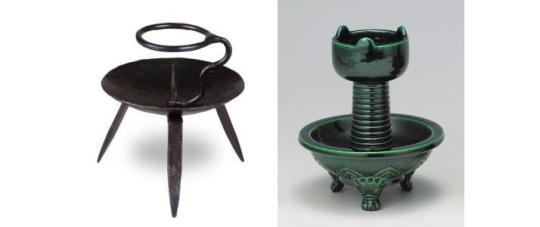
Shibayama Fugen, in his commentary, points out that the wax-candle is the shin [眞] -- original -- source of illumination, while the oil-lamp is sō [草]*. __________ *Rō-hi wa shin nari, abura-bi wa sō nari [蠟火ハ眞ナリ、油火ハ草ナリ]. More literally, “the wax-flame is shin, the oil-flame is sō.”
⁵Fukuro-dana i-ka no toki [袋棚已下の時].
I-ka [已下; the expression is usually written 以下 today] means “and what is below,” or “and below.” While in the present day it is usually translated “the following” or “(and) what follows,” here it is used more literally to mean the various arrangements that are “more wabi than the fukuro-dana.” In other words, all of the wabi arrangements -- from the fukuro-dana* down to hakobi-date [運び立て]† where nothing is present in the room but the kama, and everything else is brought out after the guests enter the room. __________ *Which was the first “truly wabi” arrangement.
Originally, the ro was used all year round in the wabi setting. Thus Jōō considers the case where the fukuro-dana is being used at a night gathering.
The daisu is shin [眞]. Therefore, the fukuro-dana was considered to be sō [草] by Jōō (though Edo period machi-shū chajin started arguing that it was gyō [行], while things like the temae where the utensils are displayed directly on the mat, and the hakobi-date -- see the next sub-note -- are sō).
†Hakobi-date [運び立て] -- which style of service was created by Rikyū, on the first occasion when Jōō visited his home for tea. Since Rikyū's family had recently become impoverished, the young man owned nothing that would impress the greatest tea master (and most avid collector of meibutsu antiques) of the day.
Thus, rather than trying (and, surely, failing) to do so with the things he owned, Rikyū decided to make the temae itself -- the effort of preparing and serving tea -- the go-chisō [御馳走], the central feature, of his chakai for the great master. Consequently, when Jōō entered for the shoza, he found only the kama in the ro, and the kakemono (Rikyū's Yoku-ryō-an bokuseki [欲了庵墨跡]) in the tokonoma.
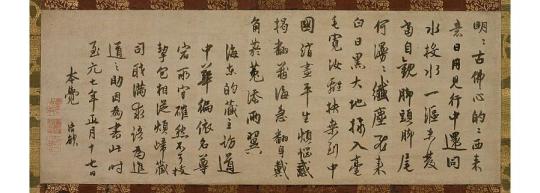
Everything else needed for the sumi-temae, Rikyū brought out from the katte, and took away again at the conclusion of the temae.
And when Jōō returned from the naka-dachi, he found, in addition to the kama and the kakemono, only the chabana (arranged in Rikyū's Tsuru-no-hito-koe [鶴の一聲], below, in the middle of the floor of the toko in front of the kakemono) had been added to the things displayed in the room.

Once again, all of the utensils necessary for the service of koicha, and usucha, were brought out from the katte; and after the service of tea was concluded, everything was taken away again.
It is said that this concept so impressed Jōō that he decided to take Rikyū into his confidence, and accepted him as one of his personal disciples.
◎ It should be noted that this was done in a 4.5-mat room. Hakobi-date (according to Rikyū) is reserved to that setting; it should not be done in a small room (unless the room has a mizuya-dōko attached to it, allowing the utensils to be lifted out directly onto the utensil mat, and returned directly at the end of the service of tea).
⁶Tōdai, tankei, andō no aida shikaru-beshi [燈臺、短檠、行燈の間しかるべし].
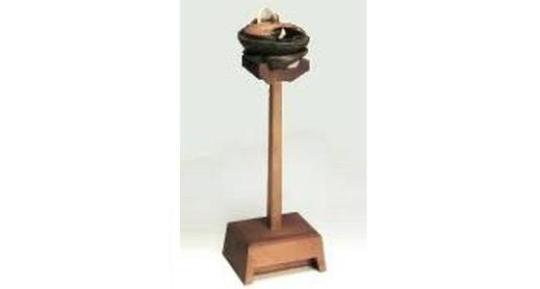
A tōdai [燈臺] (above) is an upright stand on top of which an oil-lamp is rested. One version of this kind of lamp-stand (made from a length of bamboo) is known as a chiku-kei [竹檠] today (below). The modern schools have enunciated various rules regarding the way these different lamp-stands must be used.
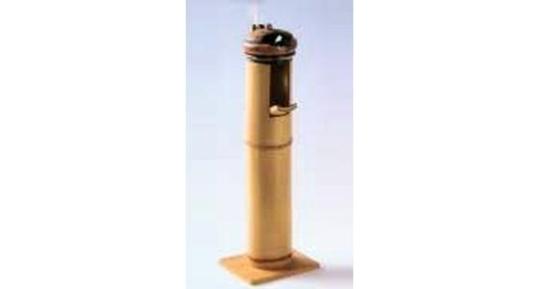
A tankei [短檠] is a more elaborate sort of lamp-stand. While the modern version has the height of the rest for the oil-lamp fixed, originally it could be moved up and down (raising or lowering the light relative to the floor).

Andō [行燈 = あんとう] is the pre-modern reading of the word andon [あんどん], meaning (originally) a traveling lamp (the oil-lamp is enclosed in a paper shade, with a handle affixed to the top).
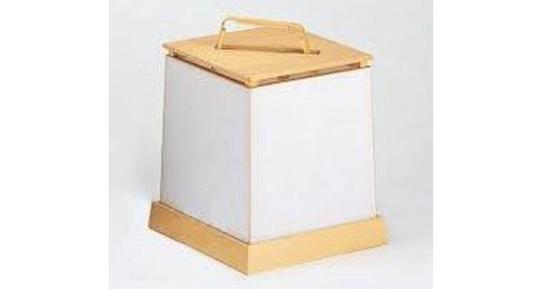
...No aida shikaru-beshi [の間然るべし]: aida [間] means “(from) among the (several objects mentioned);” shikaru-beshi [然るべし] means “as proper,” “as appropriate.”
In other words, from among the three sorts of lamp-stands mentioned (the tō-dai, tankei, and andon), the host should select the one most appropriate to the setting and circumstances. The tō-dai has the lamp fixed at a certain height above the mats (thus giving a softer, more general illumination to the whole room); the tankei (originally) allowed the height of the lamp to be adjusted (so it could be focused or generalized); and the andon (where the lamp is shaded with a paper cover) provides a much softer illumination* (with the flame located much closer to the floor as well). __________ *Traditionally, the andon was used at dawn, to make the lamp-light “yin.”
The exposed flame of the tōdai and tankei, by contrast, was considered “yang.”
⁷To iu-iu [と云〰].
This classical ending (which means “so it has been said”), found at the end of many of the verses in the Chanoyu Hyaku Shu [茶湯百首]*, suggests that this was one of the original entries that was moved into Book Three essentially intact from Jōō's original document. ___________ *It is not correct to call this collection of poems “the Hundred Poems of Rikyū” because, while Rikyū certainly did more to proselytize the teachings preserved in these verses than Jōō (who seems to have passed them on to only the chosen few among his personal disciples), the fact is that the vast majority of them were written by Jōō (who was a classically trained poet). Rikyū’s own contributions to the collection amount to no more than a handful of the poems, and most of those are simply variations on Jōō’s (replacing the word koicha [濃茶] with usucha [薄茶], for example, in order to expand upon, or qualify, the original’s significance).
⁸Ika ni mo za-naka suzushiku shōji ・ sudare mo hazusu-koto ari [イカニモ座中スヾシク障子・スダレモハヅスコトアリ].
Ika ni mo [如何にも] is usually translated “really,” “truly,” “honestly,” and so on; but it actually means “as it is,” “be that as it may,” or “under the circumstances.” In other words, given the fact that this is a night gathering being held during the summer, it is important in these circumstances to keep the room as cool as possible. This is to be done by removing not only the shōji panels (that cover the windows), but even the sudare (reed blinds) that were hung outside the windows.
Since the shōji were actually supposed to be replaced by wooden shutters* at night (according to Rikyū's densho), and since sudare were only hung up during the daytime (if at all†), to reduce the light, this suggests that this kaki-ire was added by someone during the Edo period. __________ *The shutters were supposed to be dabbed with a cloth dipped in black ink on the side facing the room to darken them, so they would not reflect light (since, according to Rikyū, their movement when blown by the wind -- the shutters were suspended from two hooks, meaning they were not fixed tightly against the opening -- could be disquieting to the guests, who might notice shadows moving in the windows).
While he wrote nothing about removing them on hot summer nights, there would be no objection to doing so -- for the reasons expressed in this kaki-ire.
†This hanging of sudare during the shoza, and removing them during the naka-dachi (or, according to an even later version of the teaching, after the host has rested the hishaku on the futaoki -- which he needs o do with a clearly audible pop, so that the assistants waiting outside can hear it, and start taking the sudare away), was an Edo period piece of theatrical nonsense, based on a misinterpretation of the ancient statement that the shoza was supposed to be yin, and the goza was yang.
In fact, this yin and yang referred not to the intensity of the light (which was left up to nature), but to the condition of the water in the kama (cold, or sub-boiling, water is yin; actively boiling water is yang), and the things displayed in the tokonoma (the kakemono, and specifically a bokuseki, is yin; living flowers are yang).
⁹Genji-tōdai [源氏燈臺].
This is a lamp-stand (usually similar to a variety of tankei, where the oil-lamp is supported on a ring) with one (or more) movable (hinged) baffle (often shaped like round uchiwa fans, and either silvered like a mirror, or highly polished to achieve the same effect) which allows one to control the intensity and direction of the light*.

While the description of the lamp-stand found in this note, such as it is, seems to suggest that the author of this kaki-ire was thinking of a stand similar to the Enshū-andon [遠州行燈]† (shown below, on the left), Shibayama Fugen describes this as being a lamp-stand provided with a ribbed paper shade (resembling an akoda-melon) that can be lowered over the oil lamp.
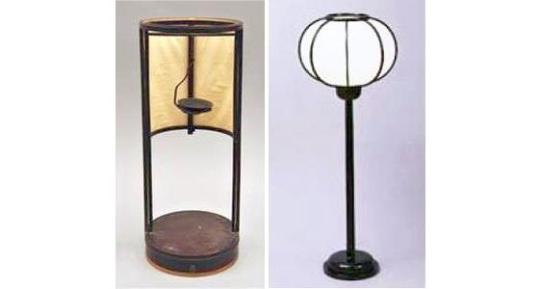
This kind of tōdai is generally referred to as either an akoda-andon [ 阿古陀行 燈], from its shape, or sometimes as an Ouchi-andon [大内行燈]‡, on account of its supposed use in the Imperial Court (right). ___________ *This kind of lamp-stand is also known as a Genji-bi [源氏火].
†The true Genji-bi has a baffle (which focuses the light in one direction while denying it from the opposite side -- though some have a series of holes pierced in the baffle, allowing a certain amount of light to shine into the darkened side of the room), rather than a shade. Yet the description uses the word ōi [覆い], which means a cover. (The photos of the Enshū-andon [遠州行燈] and akoda-andon [ 阿古陀行 燈] / Ouchi-andon [大内行燈] more closely approximate what the author of the kaki-ire has described.)
‡Since the Edo period, miniature copies of this type of lamp-stand have been included in the sets of hina-ningyo [雛人形] that are traditionally displayed on the occasion of the momo-no-sekku [桃の節句], on the third day of the Third Lunar Month.
¹⁰Ōi-shitaru wo mochi-irete yoshi [ヲヽヒシタルヲ用テヨシ].
Ōi-shitaru [覆いしたる]: ōi [覆い] means a cover or shade (the same word describes the cloth cover that is tied over the lid of a cha-tsubo), while ōi-suru [覆いする] means to put the cover on (something). Shitaru makes it conditional (“desiring to put the cover on...”).
In other words, “it is good if one decides to cover the flame (which will not only protect it from the wind, but also decrease the intensity, and so attract fewer night creatures).”
¹¹Ko-zashiki ni te mo natsu ha yo-kai ni ando wo tobosu mo yoshi [小座敷ニテモ夏ハ夜會ニアンドウヲトボスモヨシ].
While the andon* was usually said to be appropriate for the dawn chakai (to make the flame yin by covering it with a paper shade), here the purpose is to both protect the flame from gusts of wind, and to dampen the intensity of the light so, as above, it will draw fewer night insects into the room.
Traditionally, a kake-tōdai [掛燈臺] -- which, like the tankei and free-standing tōdai, has an open flame -- was used to provide illumination in the smallest rooms at night. __________ *Since the word is written with katakana, the classical pronunciation andō [アンドウ] is apparent.
It is possible that the modern pronunciation andon [アンドン] was the result of a misreading of the original spelling (perhaps occasioned by deterioration of an ancient manuscript).
1 note
·
View note
Text
Nampō Roku, Book 7 (59d): Shibayama Fugen’s Complete Commentary on Entry 48 from the Sumibiki no uchinuki-gaki・tsuika [墨引之内拔書・追加] (Part 2).

Such a rule [of “special continuance” across the kane¹] is very necessary for things like daisu midare-kazari. And in the illustrations of the various arrangements that include the incense utensils, in Book Five of this [Nampō] Roku, as well as in [Book] Six, entry 54, below the drawing of the shaku-nagabon, there is the [text]: “therefore, in the case of the shaku-naga, as well as when using the various other trays, one is free [to orient] a small habōki, a chashaku, [the pair of] kyōji, or [other] things of that sort [so that they] continue [across several kane]².” This [kind of arrangement] depends precisely on this rule.
In [the drawing labeled] kō [甲]³, even though the taki-gara-ire [炷殻入]⁴ is [placed on] the yin-kane, [it is changed into yang] -- from the yang-kane on which the kyōji-tate [香箸立]⁵ [is placed] -- by means of the habōki continuing [across the two kane].

Even though the taki-gara-ire in the drawing [labeled] otsu [乙]⁶ is also [arranged on a] yin[-kane], it is connected⁷ to the yang [that is occupied by] the jū-kōgō [重香箱]⁸, by means of the kyōji [香箸]⁹.
In the [lowermost] drawing [labeled] hei [丙]¹⁰, even though both the kōgō and the taki-gara-ire are yin, the central kōro’s yang is connected [to them] on the left, by the kyōji, and on the right, by the hane. In these examples the kyōji and habōki perform the same function as the ken-byō in the text of the entry¹¹.
There are many other examples of this kind of thing in Book Five: Daisu.

“And again, when it is a large hitsu-kake [筆架], etc.¹²”: it is said that the ken-byō can be replaced by a large hitsu-kake [that extends across the kane]. This is as shown in the sketch that was included in entry 30, in the fourth book [of the Nampō Rōku]¹³.
“[When arranged] on top of the daisu, the chaire, the chawan, each plays a [unique] role[...]¹⁴”: this means that each of these utensils performs a special role [in terms of kane-wari], and so it is said that this rule [of occupying successive kane] does not apply [to them].
Nevertheless, we must be careful with [how we understand] this expression “on top of the daisu.” For example, in the drawings from entries 17 to 22 in Book Five, as well as entry 25, regarding the hishaku, it always plays a role [in the calculation of the kane-wari value of the arrangement]¹⁵. Also, the ha[bōki] -- in entries 26, 27, and 36 -- plays a [similar] role¹⁶.
But in those cases where the ha[bōki] is placed on a tray on top of the daisu -- generally in instances where the incense utensils are mixed with things like the chaire [or other tea things] -- the hane does not perform an independent role ([see entries] 38, 39, 42, 46, 48, 49, and so on¹⁷).
This is not to mention that in the sō-an, there are some [arrangements] that do not conform to this example. In entry 37 [of the Sumibiki no uchinuki-gaki・tsuika], this is considered in the section on daime-giri mitsu-gumi [臺目切三ツ組]¹⁸.
“A biwa and [its] plectrum box” are shown in Book [Four], entry 25¹⁹; and, “a tō-bin and hai” are shown in the same volume, entry 26²⁰.
With respect to “a large ken-byō [placed] in the exact center of the tsukue-toko, etc.²¹”, this is the same as [what is shown in] the sketch found in Book Four, entry 30²². Because this would [always] be something like a meibutsu ken-byō, particularly when it was brought out for display on the tsukue-toko, it was never used for tsuzuki-kane. It is just placed out as one of the decorations on the tsukue-toko.
In the case of this kind of arrangement, placing another small ken-byō on the far side of the suzuri in order to make use of the tsuzuki-kane [is wrong]: it is inappropriate for there to be both a large and a small ken-byō [in the same arrangement].
At such a time, [the host] should not use a [second] ken-byō as the basis for the tsuzuki-kane on the far side of the suzuri. Rather, it would be better to employ a large fude-kake, or else [something like] a large mizu-ire [水入]²³ [to connect the yin-kane to the yang] for this purpose. That is why, in the original text [of this entry], it says that, when placing a large ken-byō in the very middle of the desk, “it is all the more important to use a fude-kake or mizu-ire to effect the continuance²⁴.”

Jitsuzan did not grasp this idea; to arbitrarily interpret the arrangement of the large ken-byō in the middle [of the tsukue-toko] as being a form of continuation was mistaken. In Book Seven, entry 54, of the original [Nampō] Roku, he [seems to have] misinterpreted the words of the original text²⁵: “there is a matter of continuance associated with the large ken-byō²⁶” and so on -- this is some very vague sophistry [in my opinion]. Please refer to the notes associated with the parallel paragraph [in the same entry] in Book Seven.
“Hitsu-dai-suzuri” is referring to one type of suzuri-bako [硯箱]²⁷. It is mentioned in entry 6 of [Book] Four of this [Nampō] Roku.
[The hitsu-dai-suzuri] should rest on a single yang[-kane], and that is all [that needs to be said about it]. This is why it says “it is unnecessary to be anxious [about this]²⁸.”
Regarding [the statement that] “things should not be put into the empty space between the yin[-kane] and the yang[-kane]²⁹”: when the ken-byō continues [the yang-energy onto the yin-]kane, in the space in front [of the screen] where things may be placed, whether it is “a fude, or sumi, these may be arranged freely³⁰.” But when saying these words, there is something to which we must pay careful attention: while the configuration itself might be unrestrained³¹, it is also wrong to place anything in a spot where there is no kane. In entry 29 of the [Nampō] Roku, [Book] Four, above the sketch is [written] “when, because of the ken-byō or fude-kake, the [yang-]kane continues [onto the yin], the brush should be placed first; and you should [also] understand that the other things should [be arranged to] accompany the suzuri, so it is said³²” -- [the matter] is stated in this way.
If you make a drawing of the description as given in Book Four, it would look like the following³³:
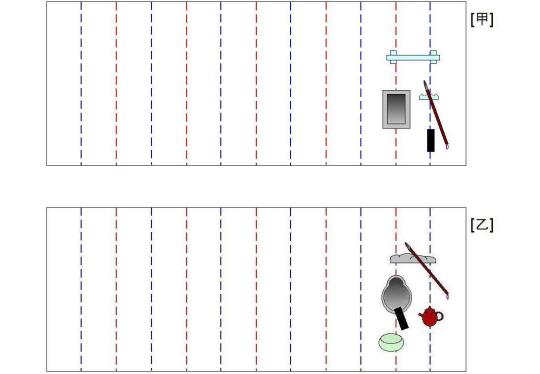
In [the sketch labeled] kō [甲], the ken-byō extends across the kane. [In consequence of which] the brush touches the kane that was changed into yang. The fude-kake and ink-stick are placed to accompany the brush.
In otsu [乙], it is the fude-kake that continues [across the kane]. The brush touches the kane that was [thereby] changed into yang. The sui-chū [水注]³⁴ is subsidiary to the fude. The sumi and hissen are placed so that they share the suzuri’s kane.
If we carefully master rules³⁵ of this sort, we will be able to modify them in various ways [to match every kind of situation].
_________________________
◎ This is the concluding section of Shibayama Fugen’s commentary on the text of entry 48 from the Sumibiki no uchinuki-gaki・tsuika [墨引之内拔書・追加]*. As in the translation of the first section of Shibayama’s commentary, all of the specific references to footnotes in that post are noted here, and indicated by the “■“ symbol.
Mentions of “the cited post” all refer to the post entitled Nampō Roku, Book 7 (59b): Entry 48 from the Sumibiki no uchinuki-gaki・tsuika [墨引之内拔書・追加], the URL for which is:
https://chanoyu-to-wa.tumblr.com/post/717634538581442560/namp%C5%8D-roku-book-7-59b-entry-48-from-the
¹See footnote 20 in the previous post.
²Sōjite shaku-naga nado shina-jina aru bon naka, ko-ha[bōki]・chashaku・kyōji nado ni te tsuzukete no jiyū nari [惣テ尺長抔品々アル盆中、小羽・茶杓・香箸ナドニテツヾケテノ自由ナリ].
The meaning is just as represented in the translation.
³The first sketch shows the large kō-bon on the left seat, with a chawan* and usucha-ki* on the right seat. ___________ *As this arrangement dates from the first half of the sixteenth century, I have shown an ido-chawan and large natsume, both of which were popular during that period.
Though Shibayama Fugen has made several minor changes in the details of this arrangement, it is basically the same as the Sō no kōro-kazari [草ノ香爐カサリ] discussed in the post entitled Nampō Roku, Book 5 (39): the Sō [草] Form of the Display of a Kōro [香爐] -- Before and After, [One] of Three [Arrangements]. The URL for that post is:
https://chanoyu-to-wa.tumblr.com/post/629088351517032448/namp%C5%8D-roku-book-5-39-the-s%C5%8D-%E8%8D%89-form-of-the
While the drawing shows a natsume, Shino Sō-on (see footnote 6), the originator of these arrangements, used his family’s meibutsu chaire (known as Kisakata [象潟]), tied in its shifuku (even though he was going to serve usucha).
⁴Taki-gara-ire [炷殻入] is a container (usually made of ceramic or metal) into which the burned-out pieces of kayara [伽羅] (which becomes fused to the gin-yō [銀葉], mica square, as it smolders) are discarded.
In each of the three sketches, the taki-gara-ire is represented by the blue circle.
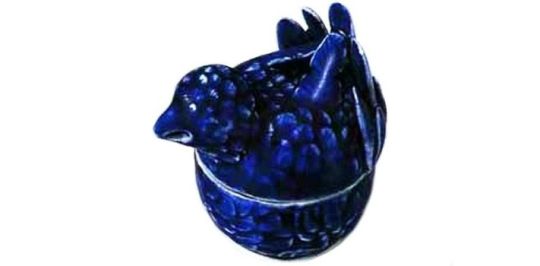
Rikyū’s famous ruri-suzume [瑠璃雀], shown above, was originally used as a taki-gara-ire by Ashikaga Yoshimasa*. This is true for most of the old ceramic “kōgō” from the first half of the sixteenth century and before -- which were elevated to this function by Jōō (as appropriate for use with the ro†). __________ *Yoshimasa used the red-lacquered “guri-guri kōgō” [グリグリ香合], shown below, as his incense container.
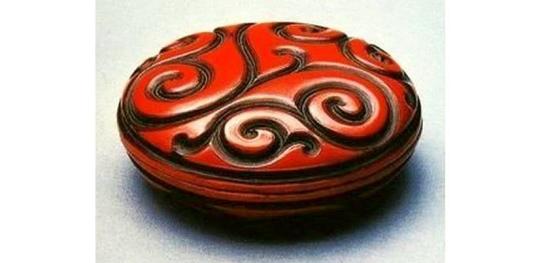
Traditionally only lacquered pieces were used for this purpose.
Rikyū seems to have acquired both of these small containers as a set; but, following Jōō’s suggestion, he used the lacquered piece during the furo season, and the ceramic piece with the ro.
†The same can be said with regard to the use of the large chawan as the omo-chawan in the wabi setting. Originally these bowls were used as kae-chawan (meaning their primary purpose was to give the host a place to wash the chasen at the end of the temae, so he would not defile the temmoku with this action), and only came to be used for serving tea in stages:
- first, the large bowl came to be used to serve the cha-no-ato [茶の跡] (the left-over koicha that remains clinging to the sides of the chawan after the guest has drunk) to the people attending the nobleman (originally tea was served only to the person we would call the shōkyaku -- who was technically taking the place of the Buddha, and drinking the tea that had been offered to the image so it would not go to waste): the tea was loosened from the sides of the temmoku with the chasen, and then this mixture of koicha and hot water was poured into the kae-chawan, which was then passed around among the shōkyaku’s attendants, so they could drink it;
- later, the matcha remaining in the chaire was put into the kae-chawan, and whisked with hot water into usucha, and that was offered to the attendants;
- then Shukō used his ido-chawan (in place of a temmoku) to offer tea to the memory of his departed master (high-footed bowls were made for the purpose of making ritual offerings to the departed spirits in Korea), after which the bowl of tea was passed around with each of the participants drinking a mouthful of tea (Shukō's room was just of 2-mats, so, including himself, there would probably have been only two or three people present);
- and finally, as the temmoku began to fall out of use of the sixteenth century, the large chawan came to be used to serve tea (while new, small chawan were used as kae-chawan).
⁵Kyōji-tate [香箸立] is a small, vase-like object (usually made of bronze or some other metal), in which the various implements used to prepare the kōro were stood*.
In the top drawing (labeled kō [甲]), the kyōji-tate is represented by the dark brown circle.

In the above photo, the kiki-kōro [聞き香爐] was placed on the left, the lacquered kōgō [香合; 香箱] is on the right, with the kyōji-tate [香筋立] (containing, from left to right, the gin-yō-basami [銀葉挾], hai-oshi [灰押し], kyōji [香筋; 香箸], and koji [火筋; 火箸]) and the taki-gara-ire [炷殻入] in the middle.
This particular kōgō (which is shaped like a turtle) and taki-gara-ire (which has a pond scene with water plants and lotus painted on it) show how the two were paired together. ___________ *In the same way that the hishaku was stood in the much larger shaku-tate. Today kyōji-tate are frequently used as holders for sen-kō [線香] (Incense sticks) -- so much so that the original purpose of the kyōji-tate has been forgotten.
⁶The arrangement labeled otsu [乙] has no obvious parallels in Book Five of the Nampō Roku* -- though this (like the others) was probably also one of the arrangements created by Shino Sō-on [志野宗温; 1477 ~ 1557], for use in those kō-kai [香會] at which tea would also be served†.
Jōō’s original cha-kai [茶會] was based on Sō-on’s special style of incense gathering (with certain modifications to underscore the increased importance he was giving to the service of tea): Jōō’s early guests were largely drawn from people with whom he had become acquainted at Sō-on’s kō-kai‡. __________ *Though the collection of cha-kō kazari [茶香飾] in Book Five can hardly be called definitive -- and it is known that at least several arrangements were removed during the late Edo period (probably by people who wanted a souvenir of the Nampō Roku, rather than to hide their contents for some reason) -- it was probably more or less representative of Sō-on and Jōō’s efforts.
The practice of using a different arrangement and set of utensils in chanoyu seems to have imitated the way Shino Sō-on conducted his kō-kai.
†This may have been intended to inform the guests that there would be a goza -- that they should remain on the veranda, or in another room, during the naka-dachi, to compose a poem (the poems, inspired by the incense, would be read and discussed during the goza, accompanied by the service of usucha).
This format for the kō-kai seems to have been first suggested by Shino Sō-on.
‡Which means that Jōō would have been careful to avoid doing anything extremely different from Sō-on, so as not to make those guests feel uncomfortable.
⁷Taki-gara-ire mata yin-kane naredomo, jū-kōgō no yang yori kyōji wo motte tsuzuke-shi-mono nari [炷殻入亦陰なれども、重香箱の陽より香箸を以て続けしものなり] means that, by means of the kyōji [香箸] (see footnote 9), the taki-gara-ire’s yin-kane is connected to the jū-kōgō’s yang-kane (which changes the yin-kane into yang).
⁸While the incense world would read this compound as jū-kōgō [重香箱], contemporary tea people would pronounce it jū-kō-bako*.

A jū-kōgō [重香合] -- three typical examples of which are shown above† -- is a set of three small boxes that stack one on top of the other, with the uppermost also being provided with a lid. The lowest box is made either of lacquered wood lined with a copper or silver cup, or else of pottery (this latter type of jū-kōgō was created specifically for use in chanoyu, with the lowest box usually made from Raku-yaki), since it is used as the taki-gara-ire. Usually (two) piece(s) of kyara [伽羅] (enclosed in some sort of cover‡) are placed in the uppermost box, with several gin-yō placed in the box in the middle.
In the middle drawing, the jū-kōgō is represented as the object decorated with maki-e, to the left of the taki-gara-ire (the blue circle). __________ *A box of this sort is commonly used in chanoyu when incense will be appreciated during the chakai -- perhaps because the kō-bon [香盆] used in chanoyu is notably smaller than the trays (from Yoshimasa’s collection of six large trays) that were preferred in former times.
†The left jū-kōgō, decorated with maki-e, is the sort commonly used by practitioners of incense; the other two are more commonly seen in chanoyu (the right version was created by Omotesenke’s Joshin-sai Sōsa [如心齋宗左; 1706 ~ 1751] during the eighteenth century, as a deliberately wabi version of this object).
‡Traditionally the kō-zutsumi [香包み] was made from a rectangular piece of bamboo-sheath, sometimes gilded or silvered on the inside, though recently they are more commonly made of meibutsu-gire backed by a piece of gilded paper (like that glued onto the underside of the ivory lid of the chaire); some tea people, eschewing such things (which they associate with the incense schools) prefer using a piece of kaishi, cut and folded to make a small envelope.
⁹Kyōji [香箸], also written kyōji [香筋]*, are the special chopsticks (made of ivory or ebony†) used to take the piece of kyara from the ko-zutsumi, and place it on top of the gin-yō (after the gin-yō has been placed on top of the shaped ash in the kōro).

Because the kyōji are oriented horizontally, they contact both the yin-kane (where the taki-gara-ire is resting) and the succeeding yang-kane (where the jū-kōgō has been placed), thereby transmuting the yin into yang. ___________ *Especially by practitioners of incense.
†These materials are used because they neither have a smell, nor will they absorb the smell from the incense. Thus they will neither contaminate the first piece of kyara, nor cross-contaminate the second piece with the fragrance of the first.
¹⁰This arrangement of the incense utensils on the naka hō-bon [中方盆]* is similar† to the one described in the post entitled Meibutsu kōro kazari [名物香爐飾], the URL for which is:
https://chanoyu-to-wa.tumblr.com/post/630990876073721856/namp%C5%8D-roku-book-5-48-the-display-of-a
__________ *The naka hō-bon [中方盆], while not one of the six meibutsu trays used by the Higashiyama-dono, was especially beloved by the machi-shū chajin of the late fifteenth and early sixteenth century (who recreated many of Yoshimasa's arrangementsᵃ for this setting), and from whom this arrangement derives.
Because this tray is 1-shaku square, it was less imposing (and so more in keeping with the spirit of wabi) than any of the larger trays. __________ ᵃSometimes successfully, but sometimes these arrangements fail to conform to the demands of kane-wari -- or else fail to do proper honor to the utensils being used.
†Generally similar; but there are differences, too.
¹¹Here we might ask why, when the ken-byō continued across two yin-kane, Shibayama claimed that this “diluted” the yang-nature of the enclosed kane, while, in this case, there is apparently no such effect. Though the reason is probably because the kyōji and ko-hane are separate entities*, the result is, in fact, the same: two yin-kane are attached with the yang-kane in the middle because something crosses both. __________ *Shibayama’s drawing moves the habōki to the far side of the tray, perhaps in an effort to discontinue the connections. However, the arrangement depicted in Book Five has both the kyōji and the habōki on the near side of the tray (though not exactly aligned with each other).
Arguments of this sort always seem somewhat forced, and it is the inconsistency (introduced by Imai Sōkyū and his followers when they began to recognize the yin-kane) that sometimes gives kane-wari a bad name.
¹²Mata ōi-naru fude-kake iu-iu [又大ナル筆架云〻].
This refers to a fude-kake wide enough to stretch across both the yang and the yin kane. The intended result -- that the yin-kane is changed to yang -- is exactly the same as when a smaller ken-byō was arranged in the same way.
■ This is a reference to the sentence discussed in footnote 10 of the post cited in the introduction.
¹³The sketch in question is reproduced below. Note that the fude-kake extends across both the endmost yang-kane and the endmost yin-kane (this is not really clear in the original sketch).

While this entry was numbered 30 in Shibayama’s teihon, it was entry 24 in the Enkaku-ji manuscript*, and that is the numbering that has been followed in this translation. __________ *The associated post was titled Nampō Roku, Book 4 (24.1): Four Arrangements for the Dashi Fu-zukue [出文机] (Tsuke-shoin [付書院]), Part 1. The URL for that post is:
https://chanoyu-to-wa.tumblr.com/post/611693645010173952/namp%C5%8D-roku-book-4-241-four-arrangements-for
¹⁴Daisu no ue no chaire mo chawan mo hitoyaku-hitoyaku [臺子ノ上ノ茶入モ茶碗モ一役〻〻] means on the daisu, the chaire, the chawan, each of these plays a [unique] role[...].”
In other words, each of these utensils is a hon-tai [本躰] (see footnote 26 of the previous post), and so each of them participates in the kane-wari calculation.
■ This refers to footnote 12 in the cited post.
¹⁵In all of these arrangements, the hishaku is placed on the ten-ita (the ten-ita of the cited arrangements are shown below -- where two arrangements are side by side, these show two different conditions for the same arrangement).
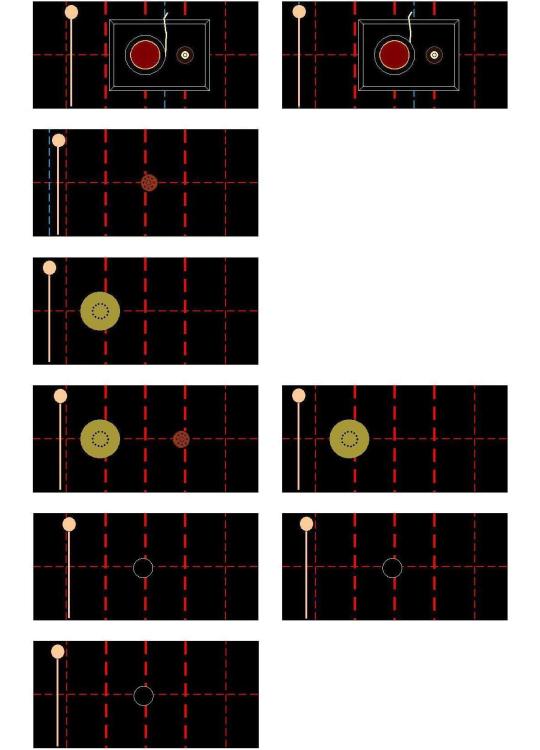
As elsewhere, Shibayama’s numbers do not agree with the numbering system used in the Enkaku-ji manuscript.
¹⁶These arrangements are shown below.

Here, it is the habōki that is (or is not) associated with a kane.
¹⁷These are the drawings from the entries cited by Shibayama.

Again, Shibayama's numbering does not agree with what was found in the Enkaku-ji manuscript.
¹⁸Entry 37 from the Sumibiki no uchinuki-gaki・tsuika reads:
daime-kiri no ro ni te mitsu-gumi no koto, mizusashi to chawan, yō-kane ni yoku kakete-okeba, tsuzuki ni narite, chaire in ni okite mo kirawazu, chawan nashi ni, chaire bakari ka, chawan bakari ka, yume-yume oku-bekarazu, saredomo kono mitsu-gumi ha koto-no-hoka sewa-sewashiki ikenai-koto nari
[臺目切ノ爐ニテ三ツ組ノコト、水指ト茶碗、陽カネニ能ク掛ケテ置ケバ、ツヾキニ成テ、茶入陰ニ置テモキラハズ、茶碗ナシニ、茶入斗カ、茶碗バカリカ、ユメ〻〻不可置、サレ共此三ツ組ハ殊ノ外セワ〻〻敷シテ不好事也].
“Mitsu-gumi with the daime-kiri ro: if the mizusashi and chawan are carefully placed so they are resting on [the same] yang-kane; in order for this to become a case of [special] continuance*, the chaire is placed on the succeeding yin[-kane] -- which is also not unpleasant.
If the chaire is [placed] by itself [in front of the mizusashi] without the chawan, or if the chawan is by itself, placing them out like this should absolutely never be done. That said, this mitsu-gumi is exceptionally annoying and displeasing.”
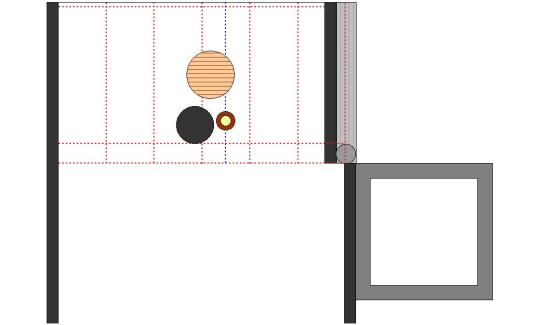
In books Six and Seven there are discussions of mitsu-gumi, but possibilities similar to what is shown above* are never mentioned. This, and the fact that the language is the same as what is found in the other machi-shū emendations, leads us to conclude that this is another addition of questionable merit. ___________ *While the mizusashi would act in the manner described in the present entry to change the yin-kane (and anything arranged on it) into yang, and so is an example of “special continuation” -- this is why Shibayama mentions in his commentary on entry 59 -- the way the chaire is oriented completely ignores the most basic rules of kane-wari.
The drawing has been redrawn from Shibayama’s commentary on entry 37 (Shibayama is somewhat notorious for a certain lack of accuracy, in so far as the relative sizes of the utensils he is depicting is concerned: in this case, by drawing the chawan much smaller than what would be possible, he makes the spacing between it and the chaire seem much more plausible -- however, in the above sketch, the chawan is 3-sun 8-bu in diameter, the chaire 1-sun 9-bu, and the mage-mono mizusashi 4-sun 9-bu, all of which are the smallest possible sizes for utensils of their type, and while the mizusashi and chawan overlap their kane by one-third, the chaire is placed squarely on the yin-kane, as was, indeed, Imai Sōkyū rule).
According to the rules of kane-wari, the separation between the chawan and chaire should be between 2-sun and 1-sun 5-bu.
¹⁹Biwa ni bachi-bako [琵琶ニ撥箱].
This is the sketch from entry 25 in Book Four, together with its analysis.
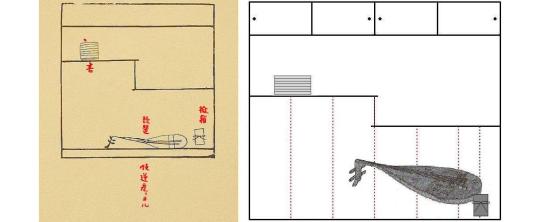
As above, the numbering in Shibayama’s teihon is not consistent with that used in the Enkaku-ji manuscript. Note that in the interpretation (which, in this case, is based on Shibayama’s version), the biwa extends across the outermost yin-kane, on which the bachi-bako is also arranged. This makes this arrangement an example of “special continuance*.”
Shibayama comments that a musical instrument should not be displayed unless the host, or one of the guests, are passionate about music. Nevertheless, the plectrum is tied in its box because to display it openly would imply that someone was expected to perform during the gathering.
Photographs of a biwa and its plectrum were included under footnote 22 in the previous post.
■ This is a reference to footnote 14 in the cited post. ___________ *In other versions of the Nampō Roku, this is not always the case -- as, for example, in Jitsuzan’s own drawing of the arrangement (which is shown on the left).
²⁰Tō-bin ni hai [湯瓶ニ盃].
The sketch from entry 26 in Book Four is shown below.

Here the matter of “special continuance” is effected by the tray, which contacts both kane.
The tō-bin, as the hon-tai or principal object (in this grouping), is displayed on the yang-kane, while the hai, as the subsidiary object, occupies the succeeding yin-kane.
A tō-bin and hai are shown in the lower photograph under footnote 21 of the previous post.
■ This, likewise, is a reference to footnote 14 in the cited post.
²¹Ōi-naru ken-byō tsukue-toko no mannaka ni iu-iu [大ナル硯屛、机床ノ眞中ニ云〻].
While placing the ken-byō (whether large or small) in the middle of the dashi fu-zukue, with the suzuri arranged in front of it, was the original way things were done, the machi-shū preferred to place the suzuri on the right side of the writing desk, as if the desk was arranged for writing (i.e., as if the host had been interrupted in the act of writing by the arrival of his guests).
The fact that the ken-byō, when placed in the center, would then be far away from the suzuri (even though its actual purpose was to protect the suzuri from any dust that might blow in through the open shōji) appears to have been considered irrelevant by the machi-shū (who apparently considered its primary purpose to be related to kane-wari).
■ This sentence is discussed at greater length in footnote 17, in the cited post.
²²Shibayama is here referring to the drawing that was included under footnote 13, above.

The schematic version is reproduced again here, for clarity. The reader is asked to look closely at the collection of objects that are arranged on the right side of the desk -- where a large fude-kake is used to join the endmost yin kane to the yang, as will be further explained below.
²³A mizu-ire [水入] is a larger, pitcher-like container* for the water that is used to prepare the ink (as well as to rinse the brush clean, when it is poured into the hissen [筆洗]†).

While the small container of water (that allows water to be added to the suzuri drop by drop) is called a sui-teki [水滴], the larger water container was referred to as a mizu-ire [水入], and (in this case) it would have to be large enough to cross both the yang and yin kane (which, on a 1-ken-wide dashi fu-zukue, are separated by around 5-sun, which would mean that from the tip of the spout to the outer edge of the handle, the mizu-ire would have to be at least that large -- though pieces of this sort usually measure 6- to 8-sun across). ___________ *Though both could be made of bronze (or celadon), a mizu-ire was usually much more substantial than the vessel used as a tō-bin (see footnote 20).
†A hissen [筆洗] (also sometimes called a fude-susugi [筆濯ぎ]) is a small bowl used for washing brushes after use.

While they could be made of anything that is waterproof, traditionally ceramic bowls (often featuring some sort of decoration, or undulations of the rim, that help with reshaping the head of the brush to a point before putting it down to dry) were more common.
While Japanese bowls were common for ordinary daily use, for display on the dashi fu-zukue, hissen imported from the continent were generally preferred.
²⁴Nao-sara fude-kake・mizu-ire-tō ni te tsuzuke [猶更筆架・水入等ニテツヾケ].
If, when a large, meibutsu ken-byō has been displayed in the middle of the desk, the host wishes to make use of the tsuzuki-kane (to join the collection of writing implements into a single group), then either the fude-kake, or something like a mizu-ire, should be placed on the far side of the suzuri -- something connected with the writing implements that is large enough to span the distance between the yang and yin-kane (which, when the tsukue-toko is 1-ken-wide tsukue-toko, is around 5-sun).
■ This is also referring to footnote 17 in the cited post.
²⁵The printed text has “原箸,” but the second kanji is obviously a mistake (the second kanji means “chopsticks”). It should be “原著” (which means the original work, or original version of the text*).
At the end of this phrase, the printed text has two commas printed one after the other (“、 、”), which might suggest that some words might have been lost (by the printer?) -- though the implication of this is not clear†. __________ *Shibayama Fugen believed that the original text was written by Nambō Sōkei, which he believes Tachibana Jitsuzan to have corrupted (perhaps intentionally) when he copied it.
Unfortunately, Shibayama failed to recognize (probably because his only exposure to the tea writings of the sixteenth century was through the documents related to the Nampō Roku which he mistakenly believed to be authentic because they tended to reinforce the chanoyu that he had been taught) that most of the exceptions are found in spurious material that was slipped into the Shū-un-an cache sometime between Sōkei's death and the date when Tachibana Jitsuzan gained access to the collection.
The fact that many of the documents discovered in the wooden chest in the Shū-un-an by the Enkaku-ji scholars differ from what is found in the Nampō Roku should immediately excite suspicion. Tachibana Jitsuzan was given access to the collection, and we must assume that meant that he was allowed to examine all of the documents found in the wooden chest, which he proceeded to copy in toto. If other documents were found during the second or third decade of the following century (when the Enkaku-ji scholars accessed the collection), the question must be asked how and when these papers became part of the collection -- or else (if they had always been there), why Tachibana Jitsuzan chose to ignore them in favor of those that he did include in the Nampō Roku (his original notes suggest that he originally copied everything uncritically, only making editorial revisions when preparing the notebooks that he was planning to present to the Enkaku-ji). The fact that many of those “new” documents support the assertions made in the toku-shu shahon and genpon versions (which are often very different, occasionally contradictory, to Jitsuzan’s original Nampō Roku), coupled with the fact that their language is even farther removed from the language of sixteenth century Sakai than the interpolations incorporated during the first decades of the Edo period, should lead to the conclusion that these things were most likely planted there by the group responsible for producing the block-printed genpon edition (which, as we have seen, was advertised as being a “new and more authentic” version of the Nampō Roku, in contrast to the previously circulated editions, both hand-copied and printed -- that, in fact, more closely reproduce the text of the Enkaku-ji manuscript). Adding all of these things together, it seems more likely that Shibayama was himself mislead (though not necessarily on this particular point -- since Jitsuzan’s sketches make it clear that there are on subsidiary objects close enough to the large ken-byō that tsuzuki-kane derived from the ken-byō could be an issue), and that the new material found in the toku-shu shahon and genpon versions was based on documents that were inserted into the Shū-un-an cache between the end of the seventeenth and the middle of the eighteenth centuries (with the purpose of bringing the Nampō Roku even closer to the machi-shū chanoyu that was being championed by the Sen families).
†The text was set based on Shibayama’s handwritten notebooks. If this is an exact, unedited reproduction of his text, then perhaps it reflects Shibayama’s momentary confusion over the miswritten kanji.
²⁶“Dai-ken-byō ni te tsuzukuru-koto ari [大硯屛ニテツヾクルコトアリ],” which certainly implies that when the large ken-byō is arranged in the exact center of the dashi fu-zukue, it changes one of the yin-kane in front of it to yang in the manner that we have been discussing -- though, if one refers to the original sketch (see, for example, the schematic diagram of this arrangement that was included under footnote 21), there do not seem to be any objects associated with any of the yin-kane that might have been contacted by the ken-byō (and so could be transmuted by association).
²⁷“Hitsu-dai-suzuri [筆臺硯]”: Shibayama states, based on the below-quoted passage (from entry 6* in Book Four) that this term refers to a type of suzuri-bako (ink-stone box) that includes a compartment for brushes (this compartment should contain a raised horizontal slat, like a built-in fude-kake, that elevates the brushs so that they do not contact the floor of the box), as well as compartments for the suzuri and sui-teki.

Entry 6 in Book Four, reads:
When a hitsu-dai [筆臺] was displayed in the Higashiyama Palace, if that hitsu-dai was one that lacked a name, the feeling was that it was better to be reticent:
- Sōami and his followers taught that [if the hitsu-dai was an ordinary piece], it might be said that one could proceed [but only after carefully thinking the matter through first, weighing the pros for display against the cons];
- Nōami, however, held that excessive reticence is out of place -- and an ordinary suzuri-bako could also be arranged together [with the other things on the dashi fu-zukue] in the same manner.
Naturally, when considering the way to display a meibutsu [object], one must change the way one is thinking: this excellent teaching was handed down from Kūkai to Dōchin, and then on to Sōeki†.
■ The hitsu-dai-suzuri was discussed in footnote 18 of the cited post -- where a small portion of the above text was translated in the first sub-note. Here, the entire text of that entry from Book Four has been quoted. ___________ *As usual, there is a discrepancy in the numbering between Shibayama Fugen’s source and the Enkaku-ji manuscript.
†The full text of this entry, from Book Four, reads:
Higashiyama-dono ni ha o-hitsu-dai kazarare soroe-domo, na mo naki hitsu-dai nado enryo aru-beki yoshi, Sōami ichi-ryū ni ha mōshi-soroe-domo, Nōami ha fu-kyū enryo, tsune no suzuri-bako mo oki-awa-subeshi, mochiron meibutsu no kazari-yō to ha kokoro-e kawaru-koto nari to denju no yoshi, Kūkai, Dōchin, Sōeki ni itaru-made sōden nari
[東山殿にハ御筆臺飾られ候得共、名もなき筆臺抔遠慮あるへき由、相阿彌一流にハ申候へとも、能阿彌ハ不及遠慮、常の硯箱も置合わスヘし、勿論名物のかざりやうとハ心得かはる事也と傳授のよし、空海、道陳、宗易に至る迄相傳なり].
Please see the post entitled Nampō Roku, Book 4 (7): Concerning the Display of the Hitsu-dai [筆臺] for futher details. The URL for that post is:
https://chanoyu-to-wa.tumblr.com/post/189671337033/namp%C5%8D-roku-book-4-7-concerning-the-display-of
Sōami [相阿彌; 1472 ~ 1525] was Nōami’s [能阿弥; 1397 ~ 1471] grandson, so this shows how the ideas had changed over time: Nōami’s approach was practical (one put out writing implements because one was planning to write; and, famous or not, the arrangement should be done so that everything is conveniently placed and easy to reach and use); Sōami was concerned with establishing the secret teachings that governed the details of the arrangements in the shōgun’s household (so that they could be reproduced by the other attendants when Sōami was no longer present). The arrangement would preferably be different from what ordinary people were doing -- since the continual use of famous treasures, even for ordinary purposes, would be seen to enhance the reputation of the shōgun (masking the fact that the Ashikaga house was in a state of terminal decline).
Kūkai [空海; his dates are unknown, but he appears to have still been relatively young at the time of Nōami’s death] was Nōami's disciple (and, according to some accounts, also his lover), and Dōchin's teacher. Dōchin [道陳; 1504 ~ 1562] was, of course, Rikyū’s first teacher; and it was by him that Rikyū was initiated into the tea of the daisu according to the orthodox tradition.
²⁸“Kokorozukai ni oyobazu [心ヅカヒニ及バズ].”
Since the only thing the host has to remember is that the hitsu-dai-suzuri should be placed on one yang-kane* (on account of the fact that it contains the suzuri, which is the hon-tai in any arrangement of writing utensils), there is no need for him (oyobazu [及ばず]) to think too carefully about, or pay close attention to (kokorozukai ni [心遣いに]) the way the object is arranged. __________ *Presumably so that it overlaps the kane by one-third when it is an ordinary piece, and so it is placed squarely on the kane when it is a meibutsu hitsu-dai-suzuri.
²⁹“In ni mo yō ni mo aranu-ma ni ha oki-bekarazu [陰ニモ陽ニモアラヌ間ニハ不可置].”
When something like a ken-byō has been oriented in such a way that it changes the yin-kane to yang, the things arranged in front of the screen must always be associated with one or the other of the two kane.
■ This refers to footnote 15 in the cited post.
³⁰“Fude mo sumi mo jiyū ni kazaru [筆モ墨モ自由ニ飾ル]”: while the brush and ink-stick are named, this caution applies to any of the other writing implements (such as the hissen [筆洗] and sui-teki [水滴]) that are also occasionally included in such groupings.
■ This sentence is discussed in footnote 7 of the cited post.
³¹Jiyū nari tote [自由なりとて] means to be free, to do things as one likes.
This means that there is no restriction on which utensils from the usual set of writing implements are displayed, or where they should be placed -- that is, whether any given implement is associated with the yang-kane, and which with the yin*. This is not fixed, and so is entirely up to the host's creativity and sensitivity (so long as the objects are all tied, in some way, to one of the two kane). __________ *Because the presence of the ken-byō converts the yin-kane, and everything associated with it, into yang, there is no actual distinction between the two kane -- everything displayed is yang, because of the ken-byō and the special rule of tsuzuki-kane.
The original yang-kane, however, seems to retain a certain claim to dominance, because the hon-tai is always supposed to be associated with it. But the things ranged along the formerly yin-kane are also considred yang (though, because of the way they are grouped together, the whole collection of objects is considered to be one unit, for the purposes of kane-wari).
³²“Ken-byō・fude-kake ni te kane wo tsuzuke, fude wo dai-ichi ni atete, hoka ha suzuri ni shitagau-yō kokoro-e iu-iu [硯屛・筆架ニテカネヲツヾケ、筆ヲ第一ニ當テヽ、外ハ硯ニ随フ様心得云々].”
Shitagau-yō [随う様] means “the way they accompany (the suzuri),” “the way they are subordinated to (the suzuri).”
The sketches will make what this means perfectly clear.

Notice, for example, that (in the sketch labeled kō [甲], reproduced above) while the small fude-kake has been placed in between the kane (which would seem to contradict the statement discussed under footnote 28, above), the brush resting on it crosses the (former) yin-kane, so that the fude-kake is connected with the kane in this way.

Likewise, in the sketch labeled otsu [乙] (above), while the sumi is shown in contact with the kane, this would not be necessary (because the suzuri itself, against which it is leaning, is already resting on the kane). So, the only consideration here, with respect to the orientation of the ink-stick, is what looks best.
The hissen and sui-teki, however, would need to touch their respective kane, because they are not in contact with either the suzuri or the fude.
³³Hidari no gotoshi [左ノ如シ] more literally means “(the drawing would look) like what is on the left.”
³⁴Today the name sui-teki [水滴], “water dropper,” seems to be the more common name for this implement (since it is used to drip water, drop by drop, onto the suzuri, so that the person can carefully control the thickness of the ink he is preparing). Sui-chū has a more academic sound to it, befitting Shibayama Fugen’s mindset.
³⁵Seiki [成規] means codified rules, formally established conventions.
If we have completely mastered the principals behind the fixed conventions, then we will more easily be able to apply them to settings that seem superficially different.
1 note
·
View note